|
PLearn 0.1
|
|
PLearn 0.1
|
Model made of RBMs linked through time. More...
#include <DenoisingRecurrentNet.h>
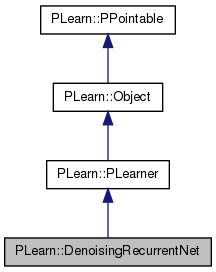
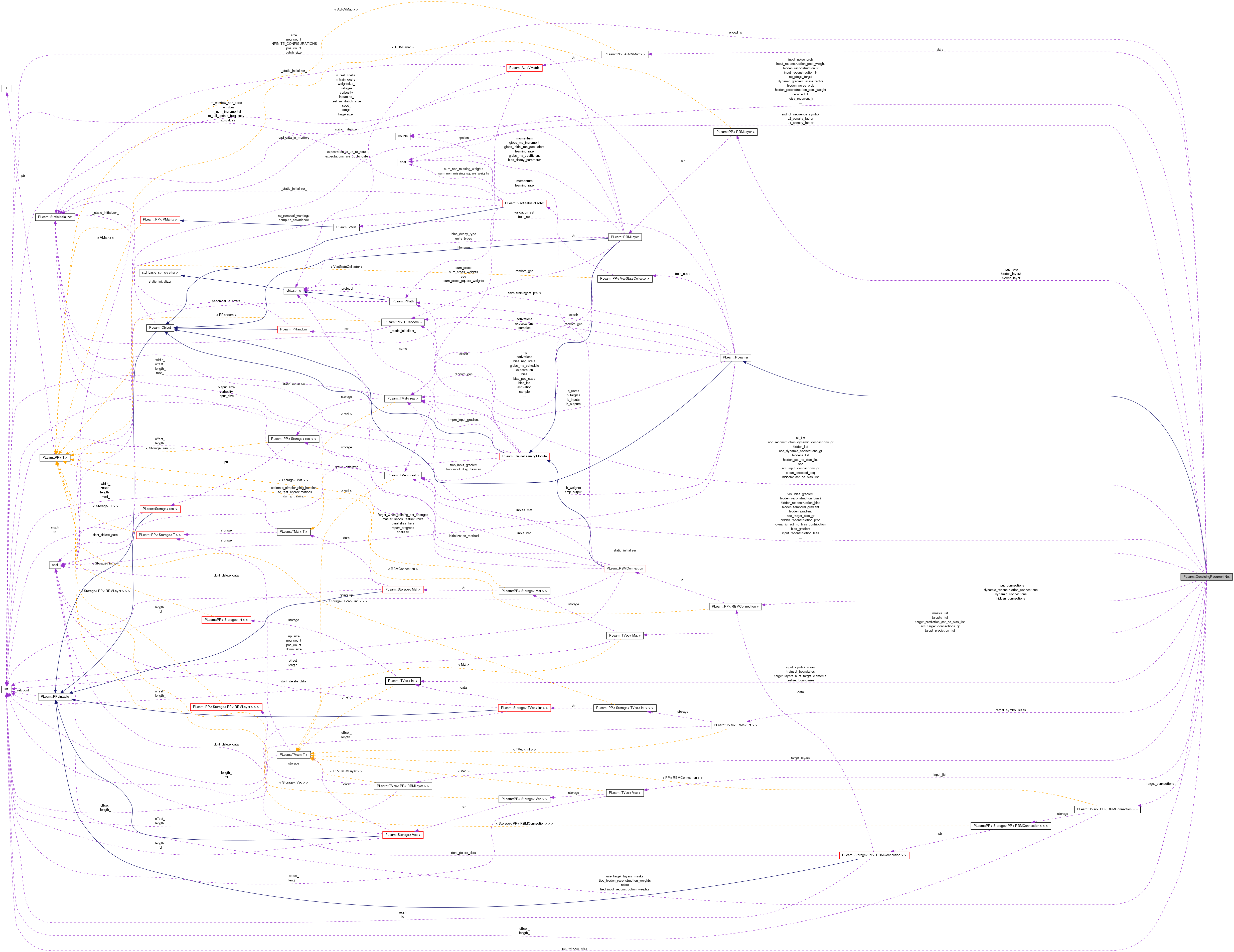
Public Member Functions | |
| void | encodeSequence (Mat sequence, Mat &encoded_seq) const |
| encodes sequence according to specified encoding option (declared const because it needs to be called in test) | |
| void | inject_zero_forcing_noise (Mat sequence, double noise_prob) const |
| void | inject_zero_forcing_noise (Vec sequence, double noise_prob) const |
| DenoisingRecurrentNet () | |
| Default constructor. | |
| virtual int | outputsize () const |
| Returns the size of this learner's output, (which typically may depend on its inputsize(), targetsize() and set options). | |
| void | setTrainingSet (VMat training_set, bool call_forget=true) |
| Declares the training set. | |
| virtual void | forget () |
| (Re-)initializes the PLearner in its fresh state (that state may depend on the 'seed' option) and sets 'stage' back to 0 (this is the stage of a fresh learner!). | |
| virtual void | train () |
| The role of the train method is to bring the learner up to stage==nstages, updating the train_stats collector with training costs measured on-line in the process. | |
| void | setLearningRate (real the_learning_rate) |
| Sets the learning of all layers and connections Remembers it by copying value to current_learning_rate. | |
| virtual void | computeOutput (const Vec &input, Vec &output) const |
| Computes the output from the input. | |
| virtual void | computeCostsFromOutputs (const Vec &input, const Vec &output, const Vec &target, Vec &costs) const |
| Computes the costs from already computed output. | |
| virtual TVec< std::string > | getTestCostNames () const |
| Returns the names of the costs computed by computeCostsFromOutpus (and thus the test method). | |
| int | nSequences () const |
| Returns the number of sequences in the training_set. | |
| void | getSequence (int i, Mat &seq) const |
| Returns the ith sequence. | |
| void | generate (int t, int n) |
| Generate music in a folder. | |
| void | generateArtificial () |
| Generate music in a folder. | |
| virtual TVec< std::string > | getTrainCostNames () const |
| Returns the names of the objective costs that the train method computes and for which it updates the VecStatsCollector train_stats. | |
| void | partition (TVec< double > part, TVec< double > periode, TVec< double > vel) const |
| Use the partition. | |
| void | clamp_units (const Vec layer_vector, PP< RBMLayer > layer, TVec< int > symbol_sizes) const |
| Clamps the layer units based on a layer vector. | |
| void | clamp_units (const Vec layer_vector, PP< RBMLayer > layer, TVec< int > symbol_sizes, const Vec original_mask, Vec &formated_mask) const |
| Clamps the layer units based on a layer vector and provides the associated mask in the correct format. | |
| void | recurrentUpdate (real input_reconstruction_weight, real hidden_reconstruction_cost_weight, real temporal_gradient_contribution, real prediction_cost_weight, real inputAndDynamicPart, Vec train_costs, Vec train_n_items) |
| Updates both the RBM parameters and the dynamic connections in the recurrent tuning phase, after the visible units have been clamped. | |
| virtual void | test (VMat testset, PP< VecStatsCollector > test_stats, VMat testoutputs=0, VMat testcosts=0) const |
| Performs test on testset, updating test cost statistics, and optionally filling testoutputs and testcosts. | |
| virtual string | classname () const |
| virtual OptionList & | getOptionList () const |
| virtual OptionMap & | getOptionMap () const |
| virtual RemoteMethodMap & | getRemoteMethodMap () const |
| virtual DenoisingRecurrentNet * | deepCopy (CopiesMap &copies) const |
| virtual void | build () |
| Finish building the object; just call inherited::build followed by build_() | |
| virtual void | makeDeepCopyFromShallowCopy (CopiesMap &copies) |
| Transforms a shallow copy into a deep copy. | |
Static Public Member Functions | |
| static void | locateSequenceBoundaries (VMat dataset, TVec< int > &boundaries, real end_of_sequence_symbol) |
| static void | encode_onehot_diffNote_duration (Mat sequence, Mat &encoded_sequence, bool use_silence, int duration_nbits=20) |
| static void | encode_onehot_note_octav_duration (Mat sequence, Mat &encoded_sequence, int prepend_zero_rows, bool use_silence, int octav_nbits, int duration_nbits=20) |
| static void | encode_onehot_timeframe (Mat sequence, Mat &encoded_sequence, int prepend_zero_rows, bool use_silence=false) |
| static int | duration_to_number_of_timeframes (int duration) |
| static int | getDurationBit (int duration) |
| static Vec | getInputWindow (Mat sequence, int startpos, int winsize) |
| static void | getNoteAndOctave (int midi_number, int ¬e, int &octave) |
| static string | _classname_ () |
| static OptionList & | _getOptionList_ () |
| static RemoteMethodMap & | _getRemoteMethodMap_ () |
| static Object * | _new_instance_for_typemap_ () |
| static bool | _isa_ (const Object *o) |
| static void | _static_initialize_ () |
| static const PPath & | declaringFile () |
Public Attributes | |
| Vec | target_layers_weights |
| The training weights of each target layers. | |
| bool | use_target_layers_masks |
| Indication that a mask indicating which target to predict is present in the input part of the VMatrix dataset. | |
| real | end_of_sequence_symbol |
| Value of the first input component for end-of-sequence delimiter. | |
| PP< RBMLayer > | input_layer |
| The input layer of the model. | |
| TVec< PP< RBMLayer > > | target_layers |
| The target layers of the model. | |
| PP< RBMLayer > | hidden_layer |
| The hidden layer of the model. | |
| PP< RBMLayer > | hidden_layer2 |
| The second hidden layer of the model (optional) | |
| PP< RBMConnection > | dynamic_connections |
| The RBMConnection between the first hidden layers, through time. | |
| PP< RBMConnection > | dynamic_reconstruction_connections |
| The RBMConnection for the reconstruction between the hidden layers, through time. | |
| PP< RBMConnection > | hidden_connections |
| The RBMConnection between the first and second hidden layers (optional) | |
| PP< RBMConnection > | input_connections |
| The RBMConnection from input_layer to hidden_layer. | |
| TVec< PP< RBMConnection > > | target_connections |
| The RBMConnection from input_layer to hidden_layer. | |
| TVec< int > | target_layers_n_of_target_elements |
| Number of elements in the target part of a VMatrix associated to each target layer. | |
| TVec< int > | input_symbol_sizes |
| Number of symbols for each symbolic field of train_set. | |
| TVec< TVec< int > > | target_symbol_sizes |
| Number of symbols for each symbolic field of train_set. | |
| string | encoding |
| Chooses what type of encoding to apply to an input sequence Possibilities: "timeframe", "note_duration", "note_octav_duration", "raw_masked_supervised". | |
| bool | noise |
| real | L1_penalty_factor |
| Optional (default=0) factor of L1 regularization term. | |
| real | L2_penalty_factor |
| Optional (default=0) factor of L2 regularization term. | |
| int | input_window_size |
| Input window size. | |
| bool | tied_input_reconstruction_weights |
| double | input_noise_prob |
| double | input_reconstruction_lr |
| double | hidden_noise_prob |
| double | hidden_reconstruction_lr |
| bool | tied_hidden_reconstruction_weights |
| double | noisy_recurrent_lr |
| double | dynamic_gradient_scale_factor |
| double | recurrent_lr |
| Vec | mean_encoded_vec |
| Vec | input_reconstruction_bias |
| Vec | hidden_reconstruction_bias |
| Vec | hidden_reconstruction_bias2 |
| double | prediction_cost_weight |
| double | input_reconstruction_cost_weight |
| double | hidden_reconstruction_cost_weight |
| double | nb_stage_reconstruction |
| double | nb_stage_target |
Static Public Attributes | |
| static StaticInitializer | _static_initializer_ |
Static Protected Member Functions | |
| static void | declareOptions (OptionList &ol) |
| Declares the class options. | |
Protected Attributes | |
| double | current_learning_rate |
| PP< AutoVMatrix > | data |
| Store external data;. | |
| TVec< Mat > | acc_target_connections_gr |
| Mat | acc_input_connections_gr |
| Mat | acc_dynamic_connections_gr |
| Mat | acc_reconstruction_dynamic_connections_gr |
| Vec | acc_target_bias_gr |
| Stores accumulate target bias gradient. | |
| Vec | acc_hidden_bias_gr |
| Stores accumulate hidden bias gradient. | |
| Vec | acc_recons_bias_gr |
| Stores accumulate reconstruction bias gradient. | |
| Vec | bias_gradient |
| Stores bias gradient. | |
| Vec | visi_bias_gradient |
| Stores bias gradient. | |
| Vec | hidden_gradient |
| Stores hidden gradient of dynamic connections. | |
| Vec | hidden_temporal_gradient |
| Stores hidden gradient of dynamic connections coming from time t+1. | |
| Mat | hidden_list |
| List of hidden layers values. | |
| Mat | hidden_act_no_bias_list |
| Mat | hidden2_list |
| List of second hidden layers values. | |
| Mat | hidden2_act_no_bias_list |
| TVec< Mat > | target_prediction_list |
| List of target prediction values. | |
| TVec< Mat > | target_prediction_act_no_bias_list |
| TVec< Vec > | input_list |
| List of inputs values. | |
| TVec< Mat > | targets_list |
| List of inputs values. | |
| Mat | nll_list |
| List of the nll of the input samples in a sequence. | |
| TVec< Mat > | masks_list |
| List of all targets' masks. | |
| Vec | dynamic_act_no_bias_contribution |
| Contribution of dynamic weights to hidden layer activation. | |
| TVec< int > | trainset_boundaries |
| TVec< int > | testset_boundaries |
| Mat | seq |
| Mat | encoded_seq |
| Mat | clean_encoded_seq |
| Vec | input_reconstruction_prob |
| Vec | hidden_reconstruction_prob |
Private Types | |
| typedef PLearner | inherited |
Private Member Functions | |
| void | build_ () |
| This does the actual building. | |
| void | applyMultipleSoftmaxToInputWindow (Vec input_reconstruction_activation, Vec input_reconstruction_prob) |
| void | recurrentFprop (Vec train_costs, Vec train_n_items, bool useDynamicConnections=true) const |
| void | encodeSequenceAndPopulateLists (Mat seq, bool doNoise) const |
| does encoding if needed and populates the list. | |
| void | encodeAndCreateSupervisedSequence (Mat seq) const |
| encodes seq, then populates: inputslist, targets_list, masks_list | |
| void | encodeAndCreateSupervisedSequence2 (Mat seq) const |
| void | splitRawMaskedSupervisedSequence (Mat seq, bool doNoise) const |
| For the (backward testing) raw_masked_supervised case. Populates: input_list, targets_list, masks_list. | |
| void | encode_artificialData (Mat seq) const |
| void | resize_lists (int l) const |
| void | trainUnconditionalPredictor () |
| void | unconditionalFprop (Vec train_costs, Vec train_n_items) const |
| Mat | getTargetConnectionsWeightMatrix (int tar) |
| Mat | getInputConnectionsWeightMatrix () |
| Mat | getDynamicConnectionsWeightMatrix () |
| Mat | getDynamicReconstructionConnectionsWeightMatrix () |
| void | updateTargetLayer (Vec &grad, Vec &bias, real &lr) |
| void | bpropUpdateConnection (const Vec &input, const Vec &output, Vec &input_gradient, const Vec &output_gradient, Mat &weights, Mat &acc_weights_gr, int &down_size, int &up_size, real &lr, bool accumulate, bool using_penalty_factor) |
| void | bpropUpdateHiddenLayer (const Vec &input, const Vec &output, Vec &input_gradient, const Vec &output_gradient, Vec &bias, real &lr) |
| void | applyWeightPenalty (Mat &weights, Mat &acc_weights_gr, int &down_size, int &up_size, real &lr) |
| double | fpropUpdateInputReconstructionFromHidden (Vec hidden, Mat &reconstruction_weights, Mat &acc_weights_gr, Vec &input_reconstruction_bias, Vec &input_reconstruction_prob, Vec clean_input, Vec hidden_gradient, double input_reconstruction_cost_weight, double lr) |
| Builds input_reconstruction_prob from hidden (using reconstruction_weights which is nhidden x ninputs, and input_reconstruction_bias) then backpropagates reconstruction cost (after comparison with clean_input) with learning rate input_reconstruction_lr accumulates gradient in hidden_gradient, and updates reconstruction_weights and input_reconstruction_bias Also computes neg log cost and returns it. | |
| double | fpropInputReconstructionFromHidden (Vec hidden, Mat reconstruction_weights, Vec &input_reconstruction_bias, Vec &input_reconstruction_prob, Vec clean_input) |
| Builds input_reconstruction_prob from hidden (using reconstruction_weights which is nhidden x ninputs, and input_reconstruction_bias) Also computes neg log cost and returns it. | |
| void | updateInputReconstructionFromHidden (Vec hidden, Mat &reconstruction_weights, Mat &acc_weights_gr, Vec &input_reconstruction_bias, Vec input_reconstruction_prob, Vec clean_input, Vec hidden_gradient, double input_reconstruction_cost_weight, double lr) |
| Backpropagates reconstruction cost (after comparison with clean_input) with learning rate input_reconstruction_lr accumulates gradient in hidden_gradient, and updates reconstruction_weights and input_reconstruction_bias. | |
| double | fpropHiddenReconstructionFromLastHidden2 (Vec theInput, Vec hidden, Mat reconstruction_weights, Mat &acc_weights_gr, Vec &reconstruction_bias, Vec &reconstruction_bias2, Vec hidden_reconstruction_activation_grad, Vec &reconstruction_prob, Vec clean_input, Vec hidden_gradient, double hidden_reconstruction_cost_weight, double lr) |
| double | fpropHiddenReconstructionFromLastHidden (Vec theInput, Vec hidden, Mat reconstruction_weights, Mat &acc_weights_gr, Vec &reconstruction_bias, Vec &reconstruction_bias2, Vec hidden_reconstruction_activation_grad, Vec &reconstruction_prob, Vec clean_input, Vec hidden_gradient, double hidden_reconstruction_cost_weight, double lr) |
| double | fpropHiddenSymmetricDynamicMatrix (Vec hidden, Mat reconstruction_weights, Vec &reconstruction_prob, Vec clean_input, Vec hidden_gradient, double hidden_reconstruction_cost_weight, double lr) |
Model made of RBMs linked through time.
Definition at line 61 of file DenoisingRecurrentNet.h.
typedef PLearner PLearn::DenoisingRecurrentNet::inherited [private] |
Reimplemented from PLearn::PLearner.
Definition at line 63 of file DenoisingRecurrentNet.h.
| PLearn::DenoisingRecurrentNet::DenoisingRecurrentNet | ( | ) |
Default constructor.
Definition at line 73 of file DenoisingRecurrentNet.cc.
References PLearn::PLearner::random_gen.
:
use_target_layers_masks( false ),
end_of_sequence_symbol( -1000 ),
encoding("note_octav_duration"),
input_window_size(1),
tied_input_reconstruction_weights( true ),
input_noise_prob( 0.15 ),
input_reconstruction_lr( 0 ),
hidden_noise_prob( 0.15 ),
hidden_reconstruction_lr( 0 ),
tied_hidden_reconstruction_weights( false ),
noisy_recurrent_lr( 0.000001),
dynamic_gradient_scale_factor( 1.0 ),
recurrent_lr( 0.00001 ),
prediction_cost_weight(1),
input_reconstruction_cost_weight(0),
hidden_reconstruction_cost_weight(0),
current_learning_rate(0),
nb_stage_reconstruction(0),
nb_stage_target(0),
noise(false),
L1_penalty_factor(0),
L2_penalty_factor(0)
{
random_gen = new PRandom();
}
| string PLearn::DenoisingRecurrentNet::_classname_ | ( | ) | [static] |
Reimplemented from PLearn::PLearner.
Definition at line 71 of file DenoisingRecurrentNet.cc.
| OptionList & PLearn::DenoisingRecurrentNet::_getOptionList_ | ( | ) | [static] |
Reimplemented from PLearn::PLearner.
Definition at line 71 of file DenoisingRecurrentNet.cc.
| RemoteMethodMap & PLearn::DenoisingRecurrentNet::_getRemoteMethodMap_ | ( | ) | [static] |
Reimplemented from PLearn::PLearner.
Definition at line 71 of file DenoisingRecurrentNet.cc.
Reimplemented from PLearn::PLearner.
Definition at line 71 of file DenoisingRecurrentNet.cc.
| Object * PLearn::DenoisingRecurrentNet::_new_instance_for_typemap_ | ( | ) | [static] |
Reimplemented from PLearn::Object.
Definition at line 71 of file DenoisingRecurrentNet.cc.
| StaticInitializer DenoisingRecurrentNet::_static_initializer_ & PLearn::DenoisingRecurrentNet::_static_initialize_ | ( | ) | [static] |
Reimplemented from PLearn::PLearner.
Definition at line 71 of file DenoisingRecurrentNet.cc.
| void PLearn::DenoisingRecurrentNet::applyMultipleSoftmaxToInputWindow | ( | Vec | input_reconstruction_activation, |
| Vec | input_reconstruction_prob | ||
| ) | [private] |
Definition at line 1191 of file DenoisingRecurrentNet.cc.
References input_window_size, PLearn::TVec< T >::length(), PLERROR, PLearn::TVec< T >::subVec(), target_layers, and target_prediction_list.
Referenced by fpropInputReconstructionFromHidden().
{
if(target_layers.length()!=1)
PLERROR("applyMultipleSoftmaxToInputWindow was thought to work with a single target layer which is a RBMMixedLayer combining differnet multinomial costs");
// int nelems = target_layers[0]->size();
int nelems = target_prediction_list[0].width();
if(input_reconstruction_activation.length() != input_window_size*nelems)
PLERROR("Problem: input_reconstruction_activation.length() != input_window_size*nelems (%d != %d * %d)",input_reconstruction_activation.length(),input_window_size,nelems);
for(int k=0; k<input_window_size; k++)
{
Vec activation_window = input_reconstruction_activation.subVec(k*nelems, nelems);
Vec prob_window = input_reconstruction_prob.subVec(k*nelems, nelems);
target_layers[0]->fprop(activation_window, prob_window);
}
}


| void PLearn::DenoisingRecurrentNet::applyWeightPenalty | ( | Mat & | weights, |
| Mat & | acc_weights_gr, | ||
| int & | down_size, | ||
| int & | up_size, | ||
| real & | lr | ||
| ) | [private] |
Definition at line 1334 of file DenoisingRecurrentNet.cc.
References i, j, L1_penalty_factor, and L2_penalty_factor.
Referenced by bpropUpdateConnection().
{
// Apply penalty (decay) on weights.
real delta_L1 = lr * L1_penalty_factor;
real delta_L2 = lr * L2_penalty_factor;
/*if (L2_decrease_type == "one_over_t")
delta_L2 /= (1 + L2_decrease_constant * L2_n_updates);
else if (L2_decrease_type == "sigmoid_like")
delta_L2 *= sigmoid((L2_shift - L2_n_updates) * L2_decrease_constant);
else
PLERROR("In RBMMatrixConnection::applyWeightPenalty - Invalid value "
"for L2_decrease_type: %s", L2_decrease_type.c_str());
*/
for( int i=0; i<up_size; i++)
{
real* w_ = weights[i];
real* a_w_g = acc_weights_gr[i];
for( int j=0; j<down_size; j++ )
{
if( delta_L2 != 0. ){
//w_[j] *= (1 - delta_L2);
a_w_g[j] -= w_[j]*delta_L2;
}
if( delta_L1 != 0. )
{
if( w_[j] > delta_L1 )
a_w_g[j] -= delta_L1;
else if( w_[j] < -delta_L1 )
a_w_g[j] += delta_L1;
else
a_w_g[j] = 0.;
}
}
}
/*if (delta_L2 > 0)
L2_n_updates++;*/
}

| void PLearn::DenoisingRecurrentNet::bpropUpdateConnection | ( | const Vec & | input, |
| const Vec & | output, | ||
| Vec & | input_gradient, | ||
| const Vec & | output_gradient, | ||
| Mat & | weights, | ||
| Mat & | acc_weights_gr, | ||
| int & | down_size, | ||
| int & | up_size, | ||
| real & | lr, | ||
| bool | accumulate, | ||
| bool | using_penalty_factor | ||
| ) | [private] |
Definition at line 1259 of file DenoisingRecurrentNet.cc.
References applyWeightPenalty(), PLearn::externalProductScaleAcc(), PLearn::fast_exact_is_equal(), L1_penalty_factor, L2_penalty_factor, PLASSERT, PLASSERT_MSG, PLearn::TVec< T >::resize(), PLearn::TVec< T >::size(), PLearn::transposeProduct(), and PLearn::transposeProductAcc().
Referenced by recurrentUpdate().
{
PLASSERT( input.size() == down_size );
PLASSERT( output.size() == up_size );
PLASSERT( output_gradient.size() == up_size );
if( accumulate )
{
PLASSERT_MSG( input_gradient.size() == down_size,
"Cannot resize input_gradient AND accumulate into it" );
// input_gradient += weights' * output_gradient
transposeProductAcc( input_gradient, weights, output_gradient );
}
else
{
input_gradient.resize( down_size );
// input_gradient = weights' * output_gradient
transposeProduct( input_gradient, weights, output_gradient );
}
// weights -= learning_rate * output_gradient * input'
//externalProductScaleAcc( weights, output_gradient, input, -lr );
externalProductScaleAcc( acc_weights_gr, output_gradient, input, -lr );
if((!fast_exact_is_equal(L1_penalty_factor,0) || !fast_exact_is_equal(L2_penalty_factor,0)) && using_penalty_factor)
applyWeightPenalty(weights, acc_weights_gr, down_size, up_size, lr);
}
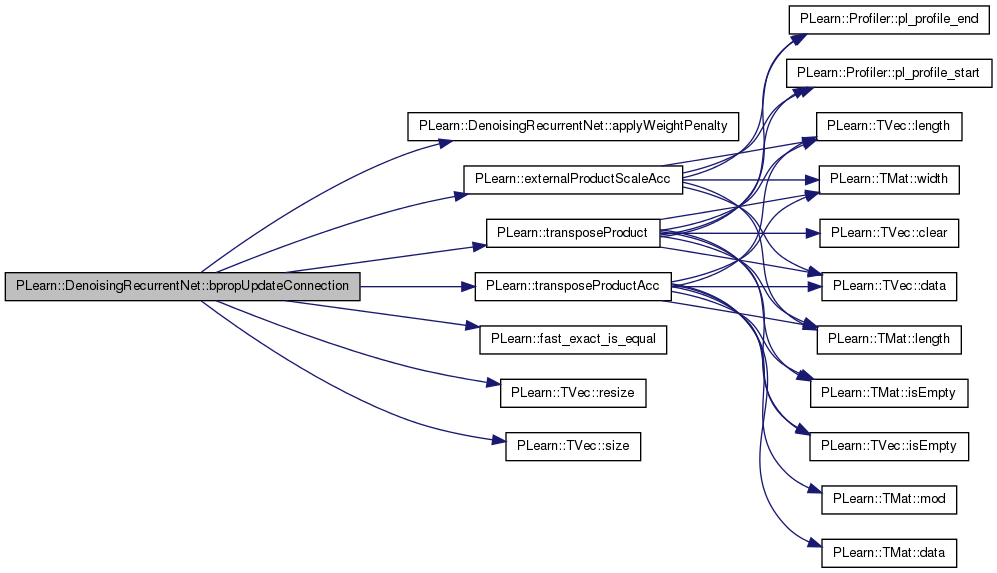

| void PLearn::DenoisingRecurrentNet::bpropUpdateHiddenLayer | ( | const Vec & | input, |
| const Vec & | output, | ||
| Vec & | input_gradient, | ||
| const Vec & | output_gradient, | ||
| Vec & | bias, | ||
| real & | lr | ||
| ) | [private] |
Definition at line 1299 of file DenoisingRecurrentNet.cc.
References PLearn::TVec< T >::clear(), i, PLearn::TVec< T >::length(), PLASSERT, PLearn::TVec< T >::resize(), and PLearn::TVec< T >::size().
Referenced by recurrentUpdate().
{
int size = bias.length();
PLASSERT( input.size() == size );
PLASSERT( output.size() == size );
PLASSERT( output_gradient.size() == size );
input_gradient.resize( size );
input_gradient.clear();
for( int i=0 ; i<size ; i++ )
{
real output_i = output[i];
real in_grad_i;
in_grad_i = output_i * (1-output_i) * output_gradient[i];
input_gradient[i] += in_grad_i;
// update the bias: bias -= learning_rate * input_gradient
bias[i] -= lr * in_grad_i;
}
//applyBiasDecay();
}
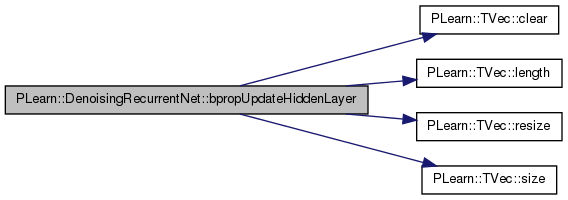

| void PLearn::DenoisingRecurrentNet::build | ( | ) | [virtual] |
Finish building the object; just call inherited::build followed by build_()
Reimplemented from PLearn::PLearner.
Definition at line 504 of file DenoisingRecurrentNet.cc.
References PLearn::PLearner::build(), and build_().
{
inherited::build();
build_();
}
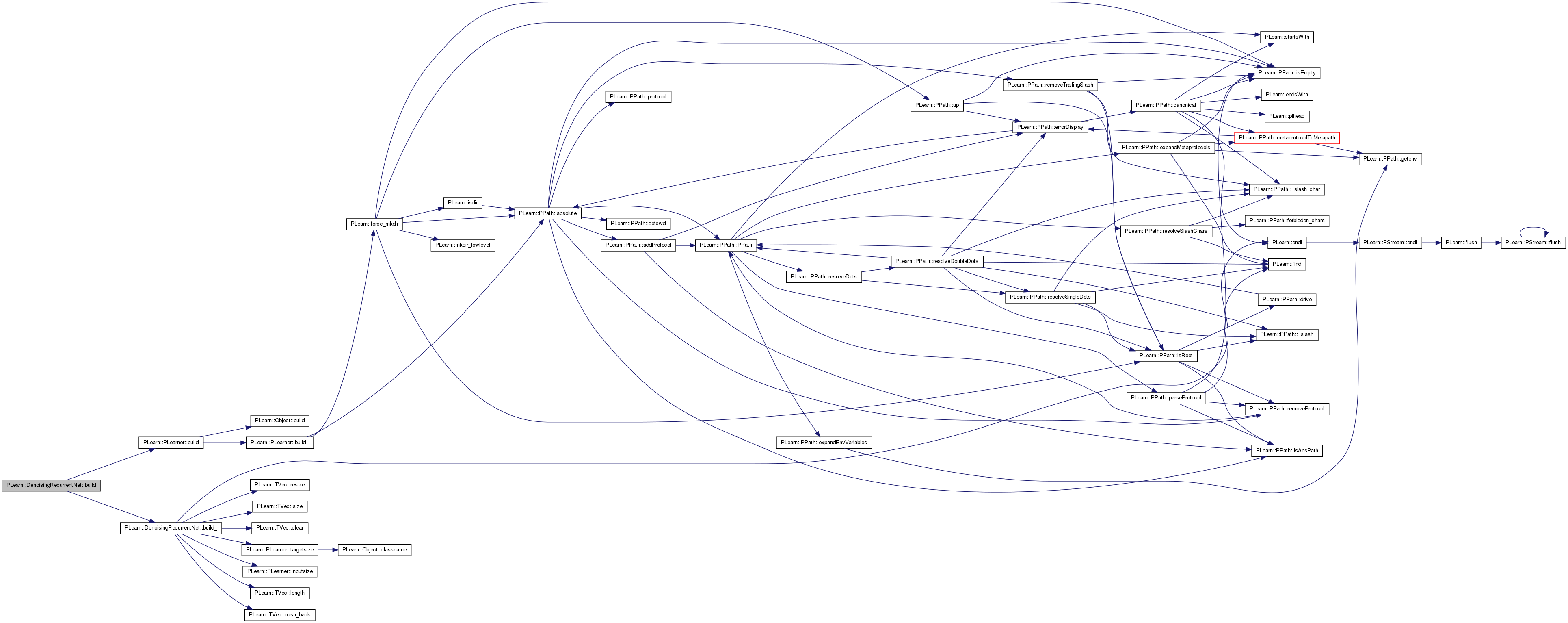
| void PLearn::DenoisingRecurrentNet::build_ | ( | ) | [private] |
This does the actual building.
Reimplemented from PLearn::PLearner.
Definition at line 302 of file DenoisingRecurrentNet.cc.
References PLearn::TVec< T >::clear(), dynamic_connections, dynamic_reconstruction_connections, encoding, PLearn::endl(), hidden_connections, hidden_layer, hidden_layer2, i, input_connections, input_layer, input_symbol_sizes, PLearn::PLearner::inputsize(), PLearn::TVec< T >::length(), PLASSERT, PLERROR, PLearn::TVec< T >::push_back(), PLearn::PLearner::random_gen, PLearn::TVec< T >::resize(), PLearn::TVec< T >::size(), target_connections, target_layers, target_layers_n_of_target_elements, target_layers_weights, target_symbol_sizes, PLearn::PLearner::targetsize(), PLearn::PLearner::train_set, and use_target_layers_masks.
Referenced by build().
{
// ### This method should do the real building of the object,
// ### according to set 'options', in *any* situation.
// ### Typical situations include:
// ### - Initial building of an object from a few user-specified options
// ### - Building of a "reloaded" object: i.e. from the complete set of
// ### all serialised options.
// ### - Updating or "re-building" of an object after a few "tuning"
// ### options have been modified.
// ### You should assume that the parent class' build_() has already been
// ### called.
MODULE_LOG << "build_() called" << endl;
if(train_set)
{
use_target_layers_masks = (encoding=="raw_masked_supervised");
PLASSERT( target_layers_weights.length() == target_layers.length() );
PLASSERT( target_connections.length() == target_layers.length() );
PLASSERT( target_layers.length() > 0 );
PLASSERT( input_layer );
PLASSERT( hidden_layer );
PLASSERT( input_connections );
// Parsing symbols in input
int input_layer_size = 0;
input_symbol_sizes.resize(0);
PP<Dictionary> dict;
int inputsize_without_masks = inputsize()
- ( use_target_layers_masks ? targetsize() : 0 );
for(int i=0; i<inputsize_without_masks; i++)
{
dict = train_set->getDictionary(i);
if(dict)
{
if( dict->size() == 0 )
PLERROR("DenoisingRecurrentNet::build_(): dictionary "
"of field %d is empty", i);
input_symbol_sizes.push_back(dict->size());
// Adjust size to include one-hot vector
input_layer_size += dict->size();
}
else
{
input_symbol_sizes.push_back(-1);
input_layer_size++;
}
}
/*
if( input_layer->size != input_layer_size )
PLERROR("DenoisingRecurrentNet::build_(): input_layer->size %d "
"should be %d", input_layer->size, input_layer_size);
*/
// Parsing symbols in target
int tar_layer = 0;
int tar_layer_size = 0;
target_symbol_sizes.resize(target_layers.length());
for( tar_layer=0; tar_layer<target_layers.length(); tar_layer++ )
target_symbol_sizes[tar_layer].resize(0);
target_layers_n_of_target_elements.resize( targetsize() );
target_layers_n_of_target_elements.clear();
tar_layer = 0;
for( int tar=0; tar<targetsize(); tar++)
{
if( tar_layer > target_layers.length() )
PLERROR("DenoisingRecurrentNet::build_(): target layers "
"does not cover all targets.");
dict = train_set->getDictionary(tar+inputsize());
if(dict)
{
if( use_target_layers_masks )
PLERROR("DenoisingRecurrentNet::build_(): masks for "
"symbolic targets is not implemented.");
if( dict->size() == 0 )
PLERROR("DenoisingRecurrentNet::build_(): dictionary "
"of field %d is empty", tar);
target_symbol_sizes[tar_layer].push_back(dict->size());
target_layers_n_of_target_elements[tar_layer]++;
tar_layer_size += dict->size();
}
else
{
target_symbol_sizes[tar_layer].push_back(-1);
target_layers_n_of_target_elements[tar_layer]++;
tar_layer_size++;
}
if( target_layers[tar_layer]->size == tar_layer_size )
{
tar_layer++;
tar_layer_size = 0;
}
}
//if( tar_layer != target_layers.length() )
// PLERROR("DenoisingRecurrentNet::build_(): target layers "
// "does not cover all targets.");
// Building weights and layers
if( !input_layer->random_gen )
{
input_layer->random_gen = random_gen;
input_layer->forget();
}
if( !hidden_layer->random_gen )
{
hidden_layer->random_gen = random_gen;
hidden_layer->forget();
}
input_connections->down_size = input_layer->size;
input_connections->up_size = hidden_layer->size;
if( !input_connections->random_gen )
{
input_connections->random_gen = random_gen;
input_connections->forget();
}
input_connections->build();
if( dynamic_connections )
{
dynamic_connections->down_size = hidden_layer->size;
dynamic_connections->up_size = hidden_layer->size;
if( !dynamic_connections->random_gen )
{
dynamic_connections->random_gen = random_gen;
dynamic_connections->forget();
}
dynamic_connections->build();
}
if( dynamic_reconstruction_connections )
{
dynamic_reconstruction_connections->down_size = hidden_layer->size;
dynamic_reconstruction_connections->up_size = hidden_layer->size;
if( !dynamic_reconstruction_connections->random_gen )
{
dynamic_reconstruction_connections->random_gen = random_gen;
dynamic_reconstruction_connections->forget();
}
dynamic_reconstruction_connections->build();
}
if( hidden_layer2 )
{
if( !hidden_layer2->random_gen )
{
hidden_layer2->random_gen = random_gen;
hidden_layer2->forget();
}
PLASSERT( hidden_connections );
hidden_connections->down_size = hidden_layer->size;
hidden_connections->up_size = hidden_layer2->size;
if( !hidden_connections->random_gen )
{
hidden_connections->random_gen = random_gen;
hidden_connections->forget();
}
hidden_connections->build();
}
for( int tar_layer = 0; tar_layer < target_layers.length(); tar_layer++ )
{
PLASSERT( target_layers[tar_layer] );
PLASSERT( target_connections[tar_layer] );
if( !target_layers[tar_layer]->random_gen )
{
target_layers[tar_layer]->random_gen = random_gen;
target_layers[tar_layer]->forget();
}
if( hidden_layer2 )
target_connections[tar_layer]->down_size = hidden_layer2->size;
else
target_connections[tar_layer]->down_size = hidden_layer->size;
target_connections[tar_layer]->up_size = target_layers[tar_layer]->size;
if( !target_connections[tar_layer]->random_gen )
{
target_connections[tar_layer]->random_gen = random_gen;
target_connections[tar_layer]->forget();
}
target_connections[tar_layer]->build();
}
}
}
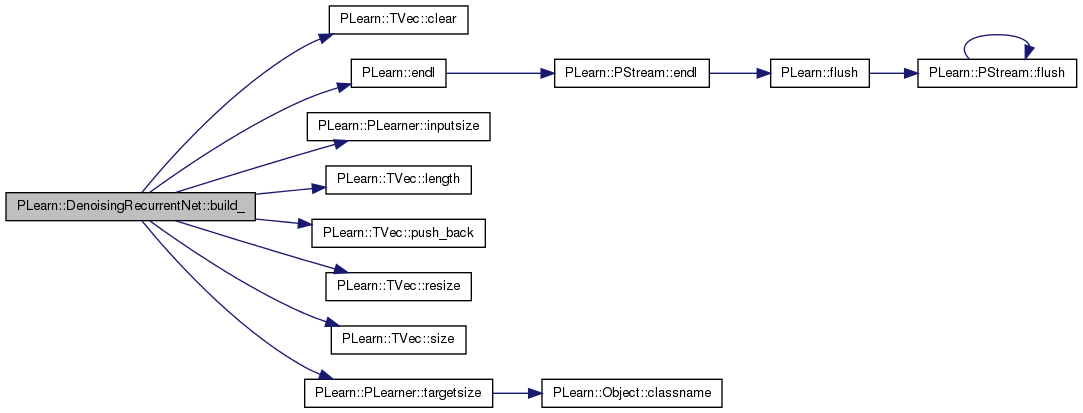

| void PLearn::DenoisingRecurrentNet::clamp_units | ( | const Vec | layer_vector, |
| PP< RBMLayer > | layer, | ||
| TVec< int > | symbol_sizes, | ||
| const Vec | original_mask, | ||
| Vec & | formated_mask | ||
| ) | const |
Clamps the layer units based on a layer vector and provides the associated mask in the correct format.
Definition at line 2519 of file DenoisingRecurrentNet.cc.
References PLearn::TVec< T >::fill(), i, PLearn::TVec< T >::length(), PLASSERT, PLearn::TVec< T >::resize(), and PLearn::TVec< T >::subVec().
{
int it = 0;
int ss = -1;
PLASSERT( original_mask.length() == layer_vector.length() );
formated_mask.resize(layer->size);
for(int i=0; i<layer_vector.length(); i++)
{
ss = symbol_sizes[i];
// If input is a real ...
if(ss < 0)
{
formated_mask[it] = original_mask[i];
layer->expectation[it++] = layer_vector[i];
}
else // ... or a symbol
{
// Convert to one-hot vector
layer->expectation.subVec(it,ss).clear();
formated_mask.subVec(it,ss).fill(original_mask[i]);
layer->expectation[it+(int)layer_vector[i]] = 1;
it += ss;
}
}
layer->setExpectation( layer->expectation );
}

| void PLearn::DenoisingRecurrentNet::clamp_units | ( | const Vec | layer_vector, |
| PP< RBMLayer > | layer, | ||
| TVec< int > | symbol_sizes | ||
| ) | const |
Clamps the layer units based on a layer vector.
Definition at line 2494 of file DenoisingRecurrentNet.cc.
References i, and PLearn::TVec< T >::length().
Referenced by generate(), and generateArtificial().
{
int it = 0;
int ss = -1;
for(int i=0; i<layer_vector.length(); i++)
{
ss = symbol_sizes[i];
// If input is a real ...
if(ss < 0)
{
layer->expectation[it++] = layer_vector[i];
}
else // ... or a symbol
{
// Convert to one-hot vector
layer->expectation.subVec(it,ss).clear();
layer->expectation[it+(int)layer_vector[i]] = 1;
it += ss;
}
}
layer->setExpectation( layer->expectation );
}


| string PLearn::DenoisingRecurrentNet::classname | ( | ) | const [virtual] |
Reimplemented from PLearn::Object.
Definition at line 71 of file DenoisingRecurrentNet.cc.
Referenced by train().

| void PLearn::DenoisingRecurrentNet::computeCostsFromOutputs | ( | const Vec & | input, |
| const Vec & | output, | ||
| const Vec & | target, | ||
| Vec & | costs | ||
| ) | const [virtual] |
Computes the costs from already computed output.
Implements PLearn::PLearner.
Definition at line 2585 of file DenoisingRecurrentNet.cc.
References PLERROR.
{
PLERROR("DenoisingRecurrentNet::computeCostsFromOutputs(): this is a "
"dynamic, generative model, that can only compute negative "
"log-likelihooh costs for a whole VMat");
}
| void PLearn::DenoisingRecurrentNet::computeOutput | ( | const Vec & | input, |
| Vec & | output | ||
| ) | const [virtual] |
Computes the output from the input.
Reimplemented from PLearn::PLearner.
Definition at line 2578 of file DenoisingRecurrentNet.cc.
References PLERROR.
{
PLERROR("DenoisingRecurrentNet::computeOutput(): this is a dynamic, "
"generative model, that can only compute negative log-likelihood "
"costs for a whole VMat");
}
| void PLearn::DenoisingRecurrentNet::declareOptions | ( | OptionList & | ol | ) | [static, protected] |
Declares the class options.
Reimplemented from PLearn::PLearner.
Definition at line 100 of file DenoisingRecurrentNet.cc.
References PLearn::OptionBase::buildoption, PLearn::declareOption(), PLearn::PLearner::declareOptions(), dynamic_connections, dynamic_gradient_scale_factor, dynamic_reconstruction_connections, encoding, end_of_sequence_symbol, hidden_connections, hidden_layer, hidden_layer2, hidden_noise_prob, hidden_reconstruction_cost_weight, hidden_reconstruction_lr, input_connections, input_layer, input_noise_prob, input_reconstruction_cost_weight, input_reconstruction_lr, input_symbol_sizes, input_window_size, L1_penalty_factor, L2_penalty_factor, PLearn::OptionBase::learntoption, mean_encoded_vec, nb_stage_reconstruction, nb_stage_target, noisy_recurrent_lr, prediction_cost_weight, recurrent_lr, target_connections, target_layers, target_layers_n_of_target_elements, target_layers_weights, target_symbol_sizes, tied_hidden_reconstruction_weights, and tied_input_reconstruction_weights.
{
// declareOption(ol, "rbm_learning_rate", &DenoisingRecurrentNet::rbm_learning_rate,
// OptionBase::buildoption,
// "The learning rate used during RBM contrastive "
// "divergence learning phase.\n");
// declareOption(ol, "rbm_nstages", &DenoisingRecurrentNet::rbm_nstages,
// OptionBase::buildoption,
// "Number of epochs for rbm phase.\n");
declareOption(ol, "target_layers_weights",
&DenoisingRecurrentNet::target_layers_weights,
OptionBase::buildoption,
"The training weights of each target layers.\n");
declareOption(ol, "end_of_sequence_symbol",
&DenoisingRecurrentNet::end_of_sequence_symbol,
OptionBase::buildoption,
"Value of the first input component for end-of-sequence "
"delimiter.\n");
// TO DO: input_layer is to be removed eventually because only its size is really used
declareOption(ol, "input_layer", &DenoisingRecurrentNet::input_layer,
OptionBase::buildoption,
"The input layer of the model.\n");
declareOption(ol, "target_layers", &DenoisingRecurrentNet::target_layers,
OptionBase::buildoption,
"The target layers of the model.\n");
declareOption(ol, "hidden_layer", &DenoisingRecurrentNet::hidden_layer,
OptionBase::buildoption,
"The hidden layer of the model.\n");
declareOption(ol, "hidden_layer2", &DenoisingRecurrentNet::hidden_layer2,
OptionBase::buildoption,
"The second hidden layer of the model (optional).\n");
declareOption(ol, "dynamic_connections",
&DenoisingRecurrentNet::dynamic_connections,
OptionBase::buildoption,
"The RBMConnection between the first hidden layers, "
"through time (optional).\n");
declareOption(ol, "dynamic_reconstruction_connections",
&DenoisingRecurrentNet::dynamic_reconstruction_connections,
OptionBase::buildoption,
"The RBMConnection for the reconstruction between the hidden layers, "
"through time (optional).\n");
declareOption(ol, "hidden_connections",
&DenoisingRecurrentNet::hidden_connections,
OptionBase::buildoption,
"The RBMConnection between the first and second "
"hidden layers (optional).\n");
declareOption(ol, "input_connections",
&DenoisingRecurrentNet::input_connections,
OptionBase::buildoption,
"The RBMConnection from input_layer to hidden_layer.\n");
declareOption(ol, "target_connections",
&DenoisingRecurrentNet::target_connections,
OptionBase::buildoption,
"The RBMConnection from input_layer to hidden_layer.\n");
declareOption(ol, "target_layers_n_of_target_elements",
&DenoisingRecurrentNet::target_layers_n_of_target_elements,
OptionBase::learntoption,
"Number of elements in the target part of a VMatrix associated\n"
"to each target layer.\n");
declareOption(ol, "input_symbol_sizes",
&DenoisingRecurrentNet::input_symbol_sizes,
OptionBase::learntoption,
"Number of symbols for each symbolic field of train_set.\n");
declareOption(ol, "target_symbol_sizes",
&DenoisingRecurrentNet::target_symbol_sizes,
OptionBase::learntoption,
"Number of symbols for each symbolic field of train_set.\n");
declareOption(ol, "encoding",
&DenoisingRecurrentNet::encoding,
OptionBase::buildoption,
"Chooses what type of encoding to apply to an input sequence\n"
"Possibilities: timeframe, note_duration, note_octav_duration, raw_masked_supervised");
declareOption(ol, "input_window_size",
&DenoisingRecurrentNet::input_window_size,
OptionBase::buildoption,
"How many time steps to present as input\n"
"If it's 0, then all layers are essentially ignored, and instead an unconditional predictor is trained\n"
"This option is ignored when mode is raw_masked_supervised,"
"since in this mode the full expanded and preprocessed input and target are given explicitly."
);
declareOption(ol, "tied_input_reconstruction_weights",
&DenoisingRecurrentNet::tied_input_reconstruction_weights,
OptionBase::buildoption,
"Do we want the input reconstruction weights tied or not\n"
"Boolean, yes or no");
declareOption(ol, "input_noise_prob",
&DenoisingRecurrentNet::input_noise_prob,
OptionBase::buildoption,
"Probability, for each neurone of each input, to be set to zero\n");
declareOption(ol, "input_reconstruction_lr",
&DenoisingRecurrentNet::input_reconstruction_lr,
OptionBase::buildoption,
"The learning rate used for the reconstruction\n");
declareOption(ol, "hidden_noise_prob",
&DenoisingRecurrentNet::hidden_noise_prob,
OptionBase::buildoption,
"Probability, for each neurone of each hidden layer, to be set to zero\n");
declareOption(ol, "hidden_reconstruction_lr",
&DenoisingRecurrentNet::hidden_reconstruction_lr,
OptionBase::buildoption,
"The learning rate used for the dynamic reconstruction through time\n");
declareOption(ol, "tied_hidden_reconstruction_weights",
&DenoisingRecurrentNet::tied_hidden_reconstruction_weights,
OptionBase::buildoption,
"Do we want the dynamic reconstruction weights tied or not\n"
"Boolean, yes or no");
declareOption(ol, "noisy_recurrent_lr",
&DenoisingRecurrentNet::noisy_recurrent_lr,
OptionBase::buildoption,
"The learning rate used in the noisy recurrent phase for the input reconstruction\n");
declareOption(ol, "dynamic_gradient_scale_factor",
&DenoisingRecurrentNet::dynamic_gradient_scale_factor,
OptionBase::buildoption,
"The scale factor of the learning rate used in the noisy recurrent phase for the dynamic hidden reconstruction\n");
declareOption(ol, "recurrent_lr",
&DenoisingRecurrentNet::recurrent_lr,
OptionBase::buildoption,
"The learning rate used in the fine tuning phase\n");
declareOption(ol, "mean_encoded_vec", &DenoisingRecurrentNet::mean_encoded_vec,
OptionBase::learntoption,
"When training with trainUnconditionalPredictor (if input_window_size==0), this is simply used to store the the avg encoded frame");
declareOption(ol, "prediction_cost_weight", &DenoisingRecurrentNet::prediction_cost_weight,
OptionBase::learntoption,
"The training weight for the target prediction");
declareOption(ol, "input_reconstruction_cost_weight", &DenoisingRecurrentNet::input_reconstruction_cost_weight,
OptionBase::learntoption,
"The training weight for the input reconstruction");
declareOption(ol, "hidden_reconstruction_cost_weight", &DenoisingRecurrentNet::hidden_reconstruction_cost_weight,
OptionBase::learntoption,
"The training weight for the hidden reconstruction");
declareOption(ol, "nb_stage_reconstruction", &DenoisingRecurrentNet::nb_stage_reconstruction,
OptionBase::learntoption,
"The nomber of stage for de reconstructions");
declareOption(ol, "nb_stage_target", &DenoisingRecurrentNet::nb_stage_target,
OptionBase::learntoption,
"The nomber of stage for de target");
declareOption(ol, "L1_penalty_factor",
&DenoisingRecurrentNet::L1_penalty_factor,
OptionBase::buildoption,
"Optional (default=0) factor of L1 regularization term, i.e.\n"
"minimize L1_penalty_factor * sum_{ij} |weights(i,j)| "
"during training.\n");
declareOption(ol, "L2_penalty_factor",
&DenoisingRecurrentNet::L2_penalty_factor,
OptionBase::buildoption,
"Optional (default=0) factor of L2 regularization term, i.e.\n"
"minimize 0.5 * L2_penalty_factor * sum_{ij} weights(i,j)^2 "
"during training.\n");
/*
declareOption(ol, "", &DenoisingRecurrentNet::,
OptionBase::learntoption,
"");
*/
// Now call the parent class' declareOptions
inherited::declareOptions(ol);
}

| static const PPath& PLearn::DenoisingRecurrentNet::declaringFile | ( | ) | [inline, static] |
Reimplemented from PLearn::PLearner.
Definition at line 328 of file DenoisingRecurrentNet.h.
:
//##### Not Options #####################################################
| DenoisingRecurrentNet * PLearn::DenoisingRecurrentNet::deepCopy | ( | CopiesMap & | copies | ) | const [virtual] |
Reimplemented from PLearn::PLearner.
Definition at line 71 of file DenoisingRecurrentNet.cc.
Definition at line 2415 of file DenoisingRecurrentNet.cc.
References PLERROR.
Referenced by encode_onehot_timeframe().
{
PLERROR("duration_to_number_of_timeframes (used only when encoding==timeframe) is not yet implemented");
return duration+1;
}

| void PLearn::DenoisingRecurrentNet::encode_artificialData | ( | Mat | seq | ) | const [private] |
Definition at line 1006 of file DenoisingRecurrentNet.cc.
References encoded_seq, i, input_list, PLearn::PLearner::inputsize(), PLearn::TMat< T >::length(), PLearn::TVec< T >::length(), PLearn::TMat< T >::resize(), PLearn::TVec< T >::resize(), resize_lists(), PLearn::TVec< T >::size(), PLearn::TMat< T >::subMatColumns(), target_layers, targets_list, PLearn::PLearner::targetsize(), and PLearn::TMat< T >::width().
Referenced by encodeSequenceAndPopulateLists().
{
int l = seq.length();
int theInputsize = inputsize();
int theTargetsize = targetsize();
resize_lists(l);
//int inputsize_without_masks = inputsize-targetsize;
Mat input_part;
input_part.resize(seq.length(),theInputsize);
input_part << seq.subMatColumns(0,theInputsize);
//Mat mask_part = seq.subMatColumns(inputsize, targetsize);
Mat target_part = seq.subMatColumns(theInputsize, theTargetsize);
//if(doNoise)
// inject_zero_forcing_noise(input_part, input_noise_prob);
for(int i=0; i<l; i++)
input_list[i] = input_part(i);
int ntargets = target_layers.length();
targets_list.resize(ntargets);
//masks_list.resize(ntargets);
int startcol = 0; // starting column of next target in target_part and mask_part
for(int k=0; k<ntargets; k++)
{
int targsize = target_layers[k]->size;
targets_list[k] = target_part.subMatColumns(startcol, targsize);
//masks_list[k] = mask_part.subMatColumns(startcol, targsize);
startcol += targsize;
}
encoded_seq.resize(input_part.length(), input_part.width());
encoded_seq << input_part;
/*int l = sequence.length();
// reserve one extra bit to mean repetition
encoded_sequence.resize(l, 1);
encoded_sequence.clear();
for(int i=0; i<l; i++)
{
int number = int(sequence(i,0));
encoded_sequence(i,0) = number;
} */
}
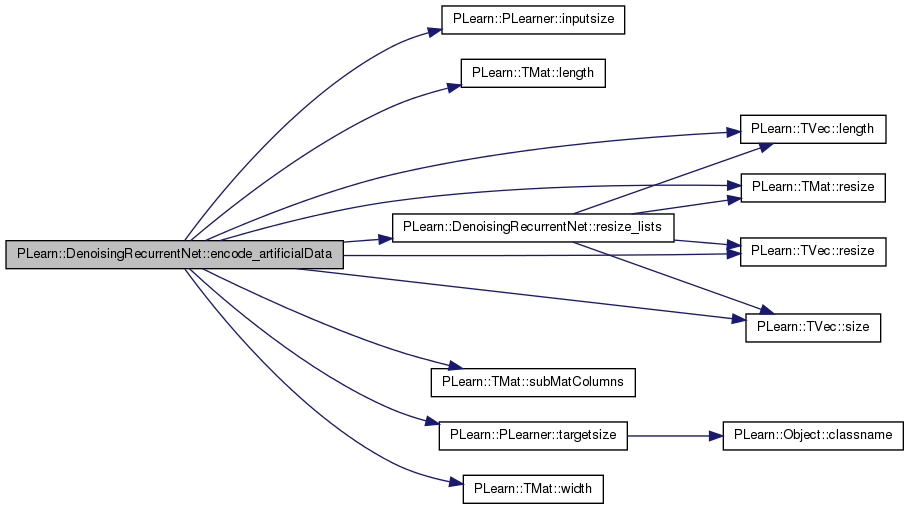

| void PLearn::DenoisingRecurrentNet::encode_onehot_diffNote_duration | ( | Mat | sequence, |
| Mat & | encoded_sequence, | ||
| bool | use_silence, | ||
| int | duration_nbits = 20 |
||
| ) | [static] |
Definition at line 2330 of file DenoisingRecurrentNet.cc.
References PLearn::TMat< T >::clear(), getDurationBit(), i, PLearn::TMat< T >::length(), PLERROR, and PLearn::TMat< T >::resize().
Referenced by encodeSequence().
{
int l = sequence.length();
//diff paussible -21 ... -1 0 1 ... 21
// index 0 20 21 22 43
int note_nbits = 43; //de -21 a 21
encoded_sequence.resize(l,note_nbits+duration_nbits);
encoded_sequence.clear();
for(int i=0; i<l; i++)
{
//int midi_number = int(sequence(i,0));
if(i==0) // silence
{
encoded_sequence(i,21) = 1;
}
else{
int diffNote = int(sequence(i,0))-int(sequence(i-1,0))+21;
encoded_sequence(i,diffNote) = 1;
}
int duration_bit = getDurationBit(int(sequence(i,1)));
if(duration_bit<0 || duration_bit>=duration_nbits)
PLERROR("duration_bit out of valid range");
encoded_sequence(i,note_nbits+duration_bit) = 1;
}
}


| void PLearn::DenoisingRecurrentNet::encode_onehot_note_octav_duration | ( | Mat | sequence, |
| Mat & | encoded_sequence, | ||
| int | prepend_zero_rows, | ||
| bool | use_silence, | ||
| int | octav_nbits, | ||
| int | duration_nbits = 20 |
||
| ) | [static] |
Definition at line 2363 of file DenoisingRecurrentNet.cc.
References PLearn::TMat< T >::clear(), getDurationBit(), i, PLearn::TMat< T >::length(), PLERROR, and PLearn::TMat< T >::resize().
Referenced by encodeSequence().
{
int l = sequence.length();
int note_nbits = use_silence ?13 :12;
encoded_sequence.resize(prepend_zero_rows+l,note_nbits+octav_nbits+duration_nbits);
encoded_sequence.clear();
int octav_min = 10000;
int octav_max = -10000;
if(octav_nbits>0)
{
for(int i=0; i<l; i++)
{
int midi_number = int(sequence(i,0));
int octav = midi_number/12;
if(octav<octav_min)
octav_min = octav;
if(octav>octav_max)
octav_max = octav;
}
if(octav_max-octav_min > octav_nbits)
PLERROR("Octav range too big. Does not fit in octav_nbits");
}
for(int i=0; i<l; i++)
{
int midi_number = int(sequence(i,0));
if(midi_number==0) // silence
{
if(use_silence)
encoded_sequence(prepend_zero_rows+i,12) = 1;
}
else
encoded_sequence(prepend_zero_rows+i,midi_number%12) = 1;
if(octav_nbits>0)
{
int octavpos = midi_number/12-octav_min;
encoded_sequence(prepend_zero_rows+i,note_nbits+octavpos) = 1;
}
int duration_bit = getDurationBit(int(sequence(i,1)));
if(duration_bit<0 || duration_bit>=duration_nbits)
PLERROR("duration_bit out of valid range");
encoded_sequence(prepend_zero_rows+i,note_nbits+octav_nbits+duration_bit) = 1;
}
}


| void PLearn::DenoisingRecurrentNet::encode_onehot_timeframe | ( | Mat | sequence, |
| Mat & | encoded_sequence, | ||
| int | prepend_zero_rows, | ||
| bool | use_silence = false |
||
| ) | [static] |
Definition at line 2426 of file DenoisingRecurrentNet.cc.
References PLearn::TMat< T >::clear(), duration_to_number_of_timeframes(), i, PLearn::TMat< T >::length(), and PLearn::TMat< T >::resize().
Referenced by encodeSequence().
{
int l = sequence.length();
int newl = 0;
// First compute length of timeframe sequence
for(int i=0; i<l; i++)
{
int duration = int(sequence(i,1));
newl += duration_to_number_of_timeframes(duration);
}
int nnotes = use_silence ?13 :12;
// reserve one extra bit to mean repetition
encoded_sequence.resize(prepend_zero_rows+newl, nnotes+1);
encoded_sequence.clear();
int k=prepend_zero_rows;
for(int i=0; i<l; i++)
{
int midi_number = int(sequence(i,0));
if(midi_number==0) // silence
{
if(use_silence)
encoded_sequence(k++,12) = 1;
}
else
encoded_sequence(k++,midi_number%12) = 1;
int duration = int(sequence(i,1));
int nframes = duration_to_number_of_timeframes(duration);
while(--nframes>0) // setb repetition bit
encoded_sequence(k++,nnotes) = 1;
}
}


| void PLearn::DenoisingRecurrentNet::encodeAndCreateSupervisedSequence | ( | Mat | seq | ) | const [private] |
encodes seq, then populates: inputslist, targets_list, masks_list
Definition at line 938 of file DenoisingRecurrentNet.cc.
References encoded_seq, encodeSequence(), input_list, input_window_size, PLearn::TMat< T >::length(), PLearn::TVec< T >::length(), PLERROR, PLearn::TVec< T >::resize(), resize_lists(), PLearn::TMat< T >::subMatRows(), target_layers, targets_list, PLearn::TMat< T >::toVec(), use_target_layers_masks, and PLearn::TMat< T >::width().
Referenced by encodeSequenceAndPopulateLists().
{
if(use_target_layers_masks)
PLERROR("Bug: use_target_layers_masks is expected to be false (no masks) when in encodeAndCreateSupervisedSequence");
encodeSequence(seq, encoded_seq);
// now work with encoded_seq
int l = encoded_seq.length();
resize_lists(l-input_window_size);
int ntargets = target_layers.length();
targets_list.resize(ntargets);
//Mat targets = targets_list[0];
//targets.resize(l, encoded_seq.width());
targets_list[0].resize(l-input_window_size, encoded_seq.width());
for(int t=input_window_size; t<l; t++)
{
input_list[t-input_window_size] = encoded_seq.subMatRows(t-input_window_size,input_window_size).toVec();
//perr << "t-input_window_size = " << endl;
//perr << "subMat:" << endl << encoded_seq.subMatRows(t-input_window_size,input_window_size) << endl;
//perr << "toVec:" << endl << encoded_seq.subMatRows(t-input_window_size,input_window_size).toVec() << endl;
//perr << "input_list:" << endl << input_list[t-input_window_size] << endl;
// target is copied so that when adding noise to input, it doesn't modify target
//targets(t-input_window_size) << encoded_seq(t);
targets_list[0](t-input_window_size) << encoded_seq(t);
}
}


| void PLearn::DenoisingRecurrentNet::encodeAndCreateSupervisedSequence2 | ( | Mat | seq | ) | const [private] |
Definition at line 901 of file DenoisingRecurrentNet.cc.
References encoded_seq, encodeSequence(), input_list, input_window_size, PLearn::TMat< T >::length(), PLearn::TVec< T >::length(), PLERROR, PLearn::TVec< T >::resize(), resize_lists(), PLearn::TVec< T >::size(), PLearn::TMat< T >::subMatRows(), target_layers, targets_list, PLearn::TMat< T >::toVec(), and use_target_layers_masks.
Referenced by encodeSequenceAndPopulateLists().
{
if(use_target_layers_masks)
PLERROR("Bug: use_target_layers_masks is expected to be false (no masks) when in encodeAndCreateSupervisedSequence");
encodeSequence(seq, encoded_seq);
// now work with encoded_seq
Vec tempoTar;
int l = encoded_seq.length();
resize_lists(l-input_window_size);
int ntargets = target_layers.length();
targets_list.resize(ntargets);
for(int tar=0; tar<ntargets; tar++)
{
int targsize = target_layers[tar]->size;
targets_list[tar].resize(l-input_window_size, targsize);
}
int startTar;
for(int t=input_window_size; t<l; t++)
{
input_list[t-input_window_size] = encoded_seq.subMatRows(t-input_window_size,input_window_size).toVec();
startTar = 43;
for(int tar=0; tar<ntargets; tar++)
{
int targsize = target_layers[tar]->size;
targets_list[tar](t-input_window_size) << encoded_seq(t).subVec(startTar,targsize);
startTar += targsize;
}
}
}


encodes sequence according to specified encoding option (declared const because it needs to be called in test)
Possibilities: "timeframe", "note_duration", "note_octav_duration", "generic"
Definition at line 2248 of file DenoisingRecurrentNet.cc.
References encode_onehot_diffNote_duration(), encode_onehot_note_octav_duration(), encode_onehot_timeframe(), encoding, input_window_size, PLERROR, and PLearn::TMat< T >::resize().
Referenced by encodeAndCreateSupervisedSequence(), and encodeAndCreateSupervisedSequence2().
{
int prepend_zero_rows = input_window_size;
// reserve some minimum space for encoded_seq
encoded_seq.resize(5000, 4);
if(encoding=="timeframe")
encode_onehot_timeframe(sequence, encoded_seq, prepend_zero_rows);
else if(encoding=="note_duration")
encode_onehot_note_octav_duration(sequence, encoded_seq, prepend_zero_rows, false, 0);
else if(encoding=="note_octav_duration")
encode_onehot_note_octav_duration(sequence, encoded_seq, prepend_zero_rows, false, 4);
else if(encoding=="diffNote_duration")
encode_onehot_diffNote_duration(sequence, encoded_seq, false);
else if(encoding=="raw_masked_supervised")
PLERROR("raw_masked_supervised means already encoded! You shouldnt have landed here!!!");
else if(encoding=="generic")
PLERROR("generic means already encoded! You shouldnt have landed here!!!");
else
PLERROR("unsupported encoding: %s",encoding.c_str());
}


| void PLearn::DenoisingRecurrentNet::encodeSequenceAndPopulateLists | ( | Mat | seq, |
| bool | doNoise | ||
| ) | const [private] |
does encoding if needed and populates the list.
Definition at line 888 of file DenoisingRecurrentNet.cc.
References encode_artificialData(), encodeAndCreateSupervisedSequence(), encodeAndCreateSupervisedSequence2(), encoding, and splitRawMaskedSupervisedSequence().
Referenced by test(), train(), and trainUnconditionalPredictor().
{
if(encoding=="raw_masked_supervised") // old already encoded format (for backward testing)
splitRawMaskedSupervisedSequence(seq, doNoise);
else if(encoding=="generic")
encode_artificialData(seq);
else if(encoding=="note_octav_duration")
encodeAndCreateSupervisedSequence(seq);
else if(encoding=="diffNote_duration")
encodeAndCreateSupervisedSequence2(seq);
}
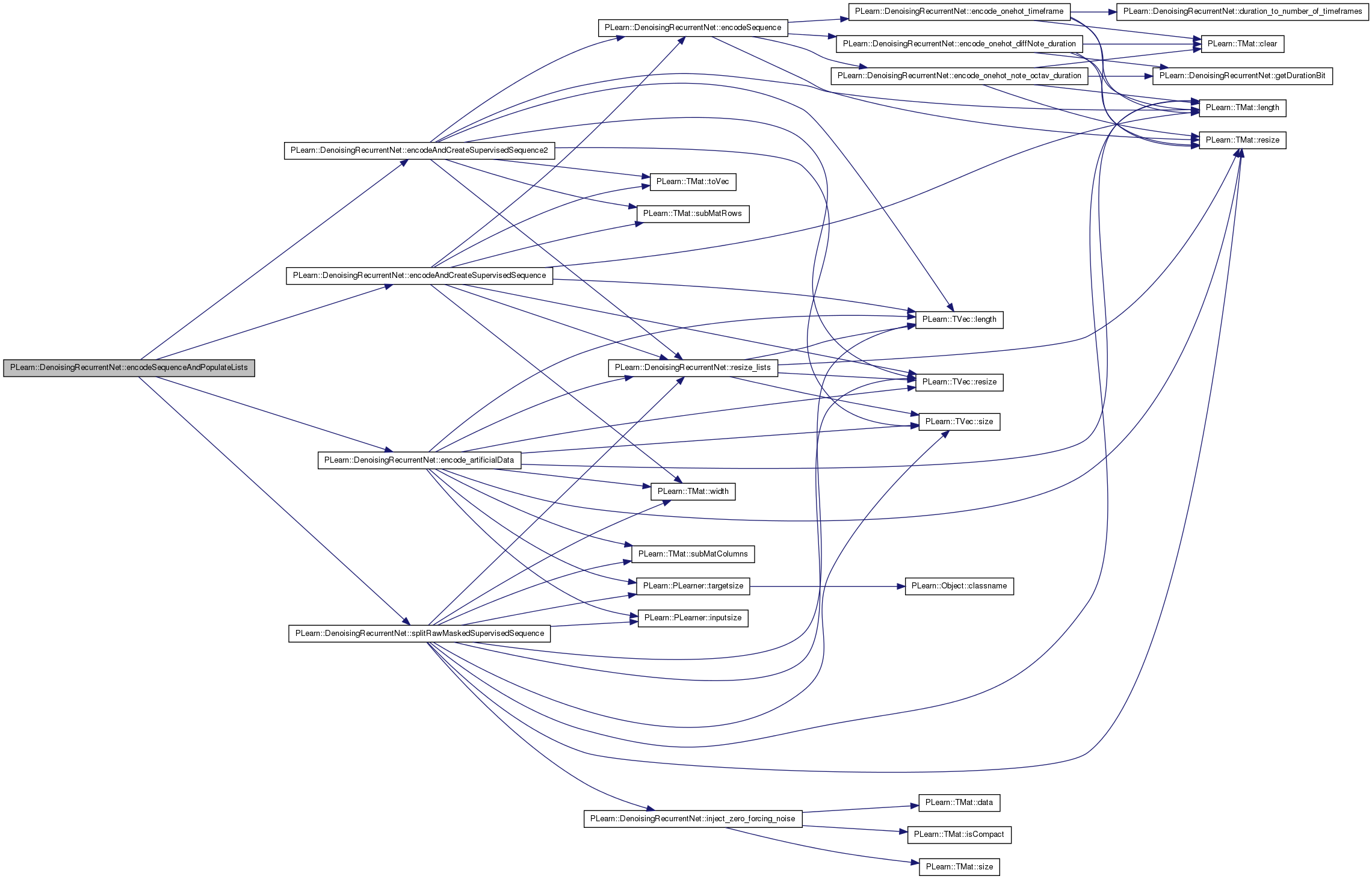

| void PLearn::DenoisingRecurrentNet::forget | ( | ) | [virtual] |
(Re-)initializes the PLearner in its fresh state (that state may depend on the 'seed' option) and sets 'stage' back to 0 (this is the stage of a fresh learner!).
Reimplemented from PLearn::PLearner.
Definition at line 582 of file DenoisingRecurrentNet.cc.
References PLearn::TVec< T >::clear(), dynamic_connections, dynamic_reconstruction_connections, PLearn::PLearner::forget(), hidden_connections, hidden_layer, hidden_layer2, i, input_connections, input_layer, input_reconstruction_bias, PLearn::TVec< T >::length(), PLearn::PLearner::stage, target_connections, and target_layers.
{
inherited::forget();
input_layer->forget();
hidden_layer->forget();
input_connections->forget();
if( dynamic_connections )
dynamic_connections->forget();
if( dynamic_reconstruction_connections )
dynamic_reconstruction_connections->forget();
if( hidden_layer2 )
{
hidden_layer2->forget();
hidden_connections->forget();
}
for( int i=0; i<target_layers.length(); i++ )
{
target_layers[i]->forget();
target_connections[i]->forget();
}
input_reconstruction_bias.clear();
stage = 0;
}

| double PLearn::DenoisingRecurrentNet::fpropHiddenReconstructionFromLastHidden | ( | Vec | theInput, |
| Vec | hidden, | ||
| Mat | reconstruction_weights, | ||
| Mat & | acc_weights_gr, | ||
| Vec & | reconstruction_bias, | ||
| Vec & | reconstruction_bias2, | ||
| Vec | hidden_reconstruction_activation_grad, | ||
| Vec & | reconstruction_prob, | ||
| Vec | clean_input, | ||
| Vec | hidden_gradient, | ||
| double | hidden_reconstruction_cost_weight, | ||
| double | lr | ||
| ) | [private] |
Definition at line 1596 of file DenoisingRecurrentNet.cc.
References PLearn::TVec< T >::clear(), dynamic_act_no_bias_contribution, dynamic_connections, PLearn::externalProductScaleAcc(), PLearn::fastsigmoid(), hidden_layer, hidden_reconstruction_cost_weight, inject_zero_forcing_noise(), input_connections, input_noise_prob, j, PLearn::TVec< T >::length(), PLearn::multiplyAcc(), PLearn::productAcc(), PLearn::TVec< T >::resize(), PLearn::safelog(), PLearn::TVec< T >::size(), and PLearn::transposeProduct().
Referenced by recurrentUpdate().
{
// set appropriate sizes
int fullhiddenlength = hidden_target.length();
Vec reconstruction_activation;
Vec hidden_input_noise;
Vec hidden_fprop_noise;
Vec hidden_act_no_bias;
Vec hidden_exp;
Vec dynamic_act_no_bias_contribution;
if(reconstruction_bias.length()==0)
{
reconstruction_bias.resize(fullhiddenlength);
reconstruction_bias.clear();
}
if(reconstruction_bias2.length()==0)
{
reconstruction_bias2.resize(fullhiddenlength);
reconstruction_bias2.clear();
}
reconstruction_activation.resize(fullhiddenlength);
reconstruction_prob.resize(fullhiddenlength);
hidden_fprop_noise.resize(fullhiddenlength);
hidden_input_noise.resize(fullhiddenlength);
hidden_act_no_bias.resize(fullhiddenlength);
hidden_exp.resize(fullhiddenlength);
dynamic_act_no_bias_contribution.resize(fullhiddenlength);
input_connections->fprop( theInput, hidden_act_no_bias);
hidden_input_noise << hidden_target;
inject_zero_forcing_noise(hidden_input_noise, input_noise_prob);
dynamic_connections->fprop(hidden_input_noise, dynamic_act_no_bias_contribution );
hidden_act_no_bias += dynamic_act_no_bias_contribution;
hidden_layer->fprop( hidden_act_no_bias, hidden_exp);
//hidden_act_no_bias += reconstruction_bias2;
//for( int j=0 ; j<fullhiddenlength ; j++ )
// hidden_fprop_noise[j] = fastsigmoid(hidden_act_no_bias[j] );
// predict (denoised) input_reconstruction
transposeProduct(reconstruction_activation, reconstruction_weights, hidden_exp); //dynamic matrice tied
//product(reconstruction_activation, reconstruction_weights, hidden_exp); //dynamic matrice not tied
reconstruction_activation += reconstruction_bias;
for( int j=0 ; j<fullhiddenlength ; j++ )
reconstruction_prob[j] = fastsigmoid( reconstruction_activation[j] );
//hidden_layer->fprop(reconstruction_activation, reconstruction_prob);
/********************************************************************************/
hidden_reconstruction_activation_grad.resize(reconstruction_prob.size());
hidden_reconstruction_activation_grad << reconstruction_prob;
hidden_reconstruction_activation_grad -= hidden_target;
hidden_reconstruction_activation_grad *= hidden_reconstruction_cost_weight;
productAcc(hidden_gradient, reconstruction_weights, hidden_reconstruction_activation_grad); //dynamic matrice tied
//transposeProductAcc(hidden_gradient, reconstruction_weights, hidden_reconstruction_activation_grad); //dynamic matrice not tied
//update bias
multiplyAcc(reconstruction_bias, hidden_reconstruction_activation_grad, -lr);
// update weight
externalProductScaleAcc(acc_weights_gr, hidden, hidden_reconstruction_activation_grad, -lr); //dynamic matrice tied
//externalProductScaleAcc(acc_weights_gr, hidden_reconstruction_activation_grad, hidden, -lr); //dynamic matrice not tied
//update bias2
//multiplyAcc(reconstruction_bias2, hidden_gradient, -lr);
/********************************************************************************/
// Vec hidden_reconstruction_activation_grad;
/*hidden_reconstruction_activation_grad.clear();
for(int k=0; k<reconstruction_prob.length(); k++){
// hidden_reconstruction_activation_grad[k] = safelog(1-reconstruction_prob[k]) - safelog(reconstruction_prob[k]);
hidden_reconstruction_activation_grad[k] = - reconstruction_activation[k];
}*/
double result_cost = 0;
double neg_log_cost = 0; // neg log softmax
for(int k=0; k<reconstruction_prob.length(); k++){
//if(hidden_target[k]!=0)
neg_log_cost -= hidden_target[k]*safelog(reconstruction_prob[k]) + (1-hidden_target[k])*safelog(1-reconstruction_prob[k]);
}
result_cost = neg_log_cost;
return result_cost;
}
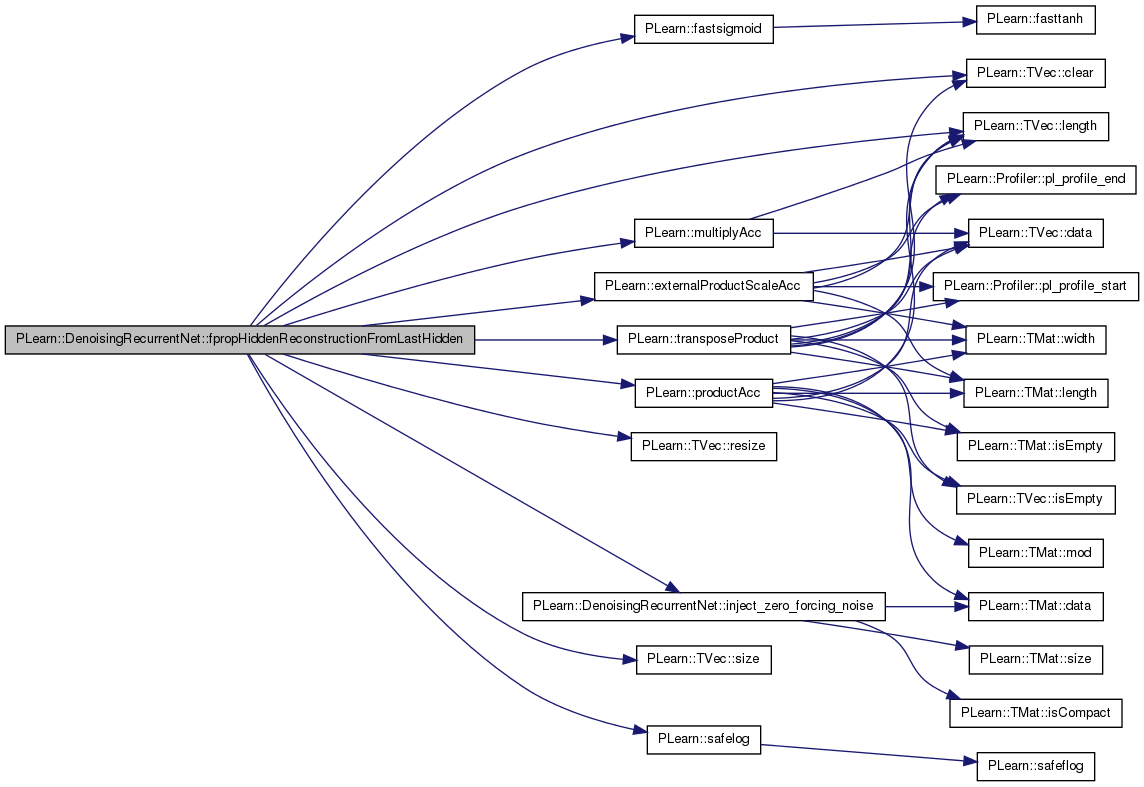

| double PLearn::DenoisingRecurrentNet::fpropHiddenReconstructionFromLastHidden2 | ( | Vec | theInput, |
| Vec | hidden, | ||
| Mat | reconstruction_weights, | ||
| Mat & | acc_weights_gr, | ||
| Vec & | reconstruction_bias, | ||
| Vec & | reconstruction_bias2, | ||
| Vec | hidden_reconstruction_activation_grad, | ||
| Vec & | reconstruction_prob, | ||
| Vec | clean_input, | ||
| Vec | hidden_gradient, | ||
| double | hidden_reconstruction_cost_weight, | ||
| double | lr | ||
| ) | [private] |
Definition at line 1474 of file DenoisingRecurrentNet.cc.
References PLearn::TVec< T >::clear(), dynamic_act_no_bias_contribution, PLearn::externalProductScaleAcc(), PLearn::fastsigmoid(), hidden_reconstruction_cost_weight, i, j, PLearn::TVec< T >::length(), PLearn::multiplyAcc(), PLearn::productAcc(), PLearn::TVec< T >::resize(), PLearn::safelog(), PLearn::TVec< T >::size(), and PLearn::transposeProduct().
{
// set appropriate sizes
int fullhiddenlength = hidden_target.length();
Vec reconstruction_activation;
Vec reconstruction_activation2;
Vec reconstruction_prob2;
Vec hidden_act_no_bias;
Vec hidden_exp;
Vec dynamic_act_no_bias_contribution;
Vec hidden_gradient2;
if(reconstruction_bias.length()==0)
{
reconstruction_bias.resize(fullhiddenlength);
reconstruction_bias.clear();
}
if(reconstruction_bias2.length()==0)
{
reconstruction_bias2.resize(fullhiddenlength);
reconstruction_bias2.clear();
}
reconstruction_prob2.resize(fullhiddenlength);
reconstruction_activation.resize(fullhiddenlength);
reconstruction_activation2.resize(fullhiddenlength);
reconstruction_prob.resize(fullhiddenlength);
hidden_act_no_bias.resize(fullhiddenlength);
hidden_exp.resize(fullhiddenlength);
dynamic_act_no_bias_contribution.resize(fullhiddenlength);
hidden_gradient2.resize(fullhiddenlength);
// predict (denoised) input_reconstruction
transposeProduct(reconstruction_activation, reconstruction_weights, hidden); //dynamic matrice tied
//product(reconstruction_activation, reconstruction_weights, hidden); //dynamic matrice not tied
reconstruction_activation += reconstruction_bias;
for( int j=0 ; j<fullhiddenlength ; j++ )
reconstruction_prob[j] = fastsigmoid( reconstruction_activation[j] );
// predict (denoised) input_reconstruction
transposeProduct(reconstruction_activation2, reconstruction_weights, reconstruction_prob); //dynamic matrice tied
reconstruction_activation2 += reconstruction_bias2;
for( int j=0 ; j<fullhiddenlength ; j++ )
reconstruction_prob2[j] = fastsigmoid( reconstruction_activation2[j] );
//hidden_layer->fprop(reconstruction_activation, reconstruction_prob);
/********************************************************************************/
hidden_reconstruction_activation_grad.resize(reconstruction_prob.size());
hidden_reconstruction_activation_grad << reconstruction_prob2;
hidden_reconstruction_activation_grad -= hidden_target;
hidden_reconstruction_activation_grad *= hidden_reconstruction_cost_weight;
productAcc(hidden_gradient2, reconstruction_weights, hidden_reconstruction_activation_grad); //dynamic matrice tied
//transposeProductAcc(hidden_gradient, reconstruction_weights, hidden_reconstruction_activation_grad); //dynamic matrice not tied
//update bias
multiplyAcc(reconstruction_bias2, hidden_reconstruction_activation_grad, -lr);
// update weight
externalProductScaleAcc(acc_weights_gr, hidden, hidden_reconstruction_activation_grad, -lr); //dynamic matrice tied
//externalProductScaleAcc(acc_weights_gr, hidden_reconstruction_activation_grad, hidden, -lr); //dynamic matrice not tied
hidden_reconstruction_activation_grad.clear();
//update bias
for( int i=0 ; i<fullhiddenlength ; i++ )
{
real in_grad_i;
in_grad_i = reconstruction_prob[i] * (1-reconstruction_prob[i]) * hidden_gradient2[i];
hidden_reconstruction_activation_grad[i] += in_grad_i;
// update the bias: bias -= learning_rate * input_gradient
reconstruction_bias[i] -= lr * in_grad_i;
}
productAcc(hidden_gradient, reconstruction_weights, hidden_reconstruction_activation_grad); //dynamic matrice tied
// update weight
externalProductScaleAcc(acc_weights_gr, hidden, hidden_reconstruction_activation_grad, -lr); //dynamic matrice tied
//update bias2
//multiplyAcc(reconstruction_bias2, hidden_gradient, -lr);
/********************************************************************************/
// Vec hidden_reconstruction_activation_grad;
/*hidden_reconstruction_activation_grad.clear();
for(int k=0; k<reconstruction_prob.length(); k++){
// hidden_reconstruction_activation_grad[k] = safelog(1-reconstruction_prob[k]) - safelog(reconstruction_prob[k]);
hidden_reconstruction_activation_grad[k] = - reconstruction_activation[k];
}*/
double result_cost = 0;
double neg_log_cost = 0; // neg log softmax
for(int k=0; k<reconstruction_prob.length(); k++){
//if(hidden_target[k]!=0)
neg_log_cost -= hidden_target[k]*safelog(reconstruction_prob[k]) + (1-hidden_target[k])*safelog(1-reconstruction_prob[k]);
}
result_cost = neg_log_cost;
return result_cost;
}
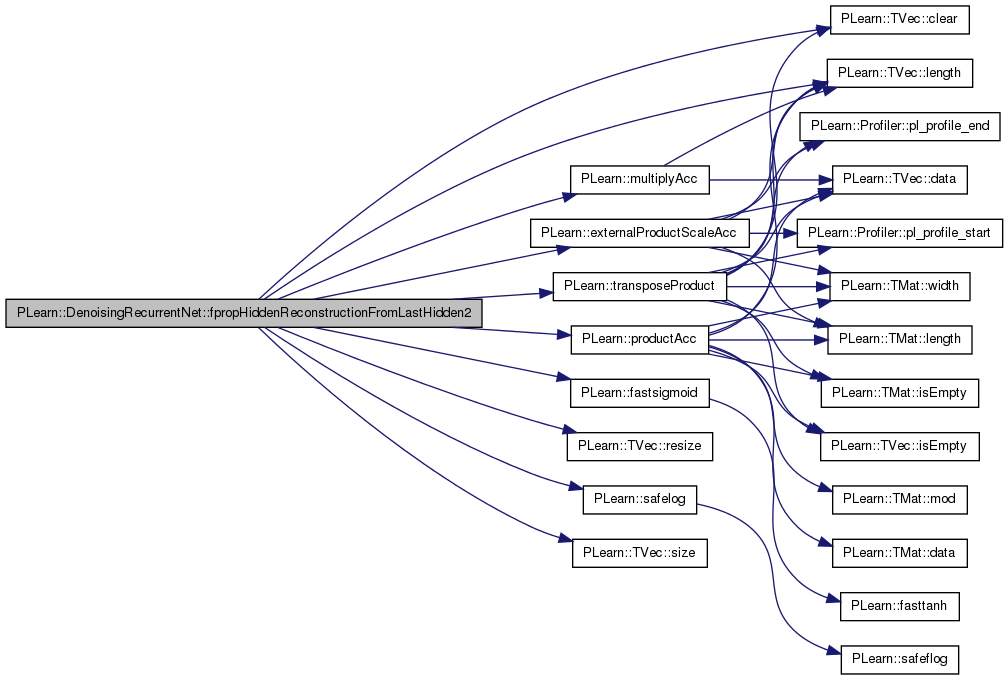
| double PLearn::DenoisingRecurrentNet::fpropHiddenSymmetricDynamicMatrix | ( | Vec | hidden, |
| Mat | reconstruction_weights, | ||
| Vec & | reconstruction_prob, | ||
| Vec | clean_input, | ||
| Vec | hidden_gradient, | ||
| double | hidden_reconstruction_cost_weight, | ||
| double | lr | ||
| ) | [private] |
Definition at line 1693 of file DenoisingRecurrentNet.cc.
References hidden_layer, hidden_reconstruction_cost_weight, PLearn::TVec< T >::length(), PLearn::productAcc(), PLearn::TVec< T >::resize(), PLearn::safelog(), PLearn::TVec< T >::size(), and PLearn::transposeProduct().
{
// set appropriate sizes
int fullinputlength = hidden_target.length();
Vec reconstruction_activation;
reconstruction_activation.resize(fullinputlength);
reconstruction_prob.resize(fullinputlength);
// predict (denoised) input_reconstruction
transposeProduct(reconstruction_activation, reconstruction_weights, hidden); //truc de stan
//product(reconstruction_activation, reconstruction_weights, hidden);
//reconstruction_activation += hidden_layer->bias;
hidden_layer->fprop(reconstruction_activation, reconstruction_prob);
/********************************************************************************/
Vec hidden_reconstruction_activation_grad;
hidden_reconstruction_activation_grad.resize(reconstruction_prob.size());
hidden_reconstruction_activation_grad << reconstruction_prob;
hidden_reconstruction_activation_grad -= hidden_target;
hidden_reconstruction_activation_grad *= hidden_reconstruction_cost_weight;
productAcc(hidden_gradient, reconstruction_weights, hidden_reconstruction_activation_grad);
/********************************************************************************/
double result_cost = 0;
double neg_log_cost = 0; // neg log softmax
for(int k=0; k<reconstruction_prob.length(); k++)
if(hidden_target[k]!=0)
neg_log_cost -= hidden_target[k]*safelog(reconstruction_prob[k]);
result_cost = neg_log_cost;
return result_cost;
}
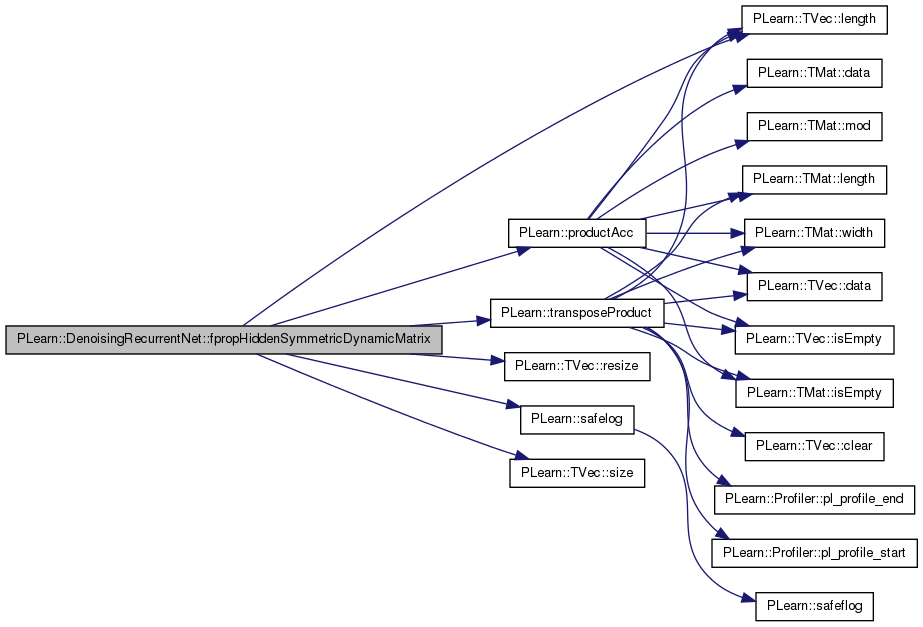
| double PLearn::DenoisingRecurrentNet::fpropInputReconstructionFromHidden | ( | Vec | hidden, |
| Mat | reconstruction_weights, | ||
| Vec & | input_reconstruction_bias, | ||
| Vec & | input_reconstruction_prob, | ||
| Vec | clean_input | ||
| ) | [private] |
Builds input_reconstruction_prob from hidden (using reconstruction_weights which is nhidden x ninputs, and input_reconstruction_bias) Also computes neg log cost and returns it.
Definition at line 1385 of file DenoisingRecurrentNet.cc.
References applyMultipleSoftmaxToInputWindow(), PLearn::TVec< T >::clear(), encoding, PLearn::TVec< T >::length(), PLearn::TVec< T >::resize(), PLearn::safelog(), PLearn::softmax(), and PLearn::transposeProduct().
Referenced by fpropUpdateInputReconstructionFromHidden().
{
// set appropriate sizes
int fullinputlength = clean_input.length();
Vec reconstruction_activation;
if(reconstruction_bias.length()==0)
{
reconstruction_bias.resize(fullinputlength);
reconstruction_bias.clear();
}
reconstruction_activation.resize(fullinputlength);
reconstruction_prob.resize(fullinputlength);
// predict (denoised) input_reconstruction
transposeProduct(reconstruction_activation, reconstruction_weights, hidden);
reconstruction_activation += reconstruction_bias;
softmax(reconstruction_activation, reconstruction_prob);
/*for( int j=0 ; j<fullinputlength ; j++ ){
if(clean_input[j]==1 || clean_input[j]==0)
reconstruction_prob[j] = fastsigmoid( reconstruction_activation[j] );
else
reconstruction_prob[j] = reconstruction_activation[j] ;
}*/
double result_cost = 0;
if(encoding=="raw_masked_supervised") // || encoding=="generic") // complicated input format... consider it's squared error
{
double r = 0;
double neg_log_cost = 0; // neg log softmax
for(int k=0; k<reconstruction_prob.length(); k++){
if(clean_input[k]==1 || clean_input[k]==0){
neg_log_cost -= clean_input[k]*safelog(reconstruction_prob[k]) + (1-clean_input[k])*safelog(1-reconstruction_prob[k]);
}
else{
r = reconstruction_prob[k] - clean_input[k];
neg_log_cost += r*r;
}
}
result_cost = neg_log_cost;
/*real r;
//reconstruction_prob << reconstruction_activation;
for(int i=0; i<reconstruction_activation.length(); i++){
r = reconstruction_activation[i] - clean_input[i];
result_cost += r*r;
}*/
}
else // suppose it's a multiple softmax
{
applyMultipleSoftmaxToInputWindow(reconstruction_activation, reconstruction_prob);
double neg_log_cost = 0; // neg log softmax
for(int k=0; k<reconstruction_prob.length(); k++)
if(clean_input[k]!=0)
neg_log_cost -= clean_input[k]*safelog(reconstruction_prob[k]);
result_cost = neg_log_cost;
}
return result_cost;
}
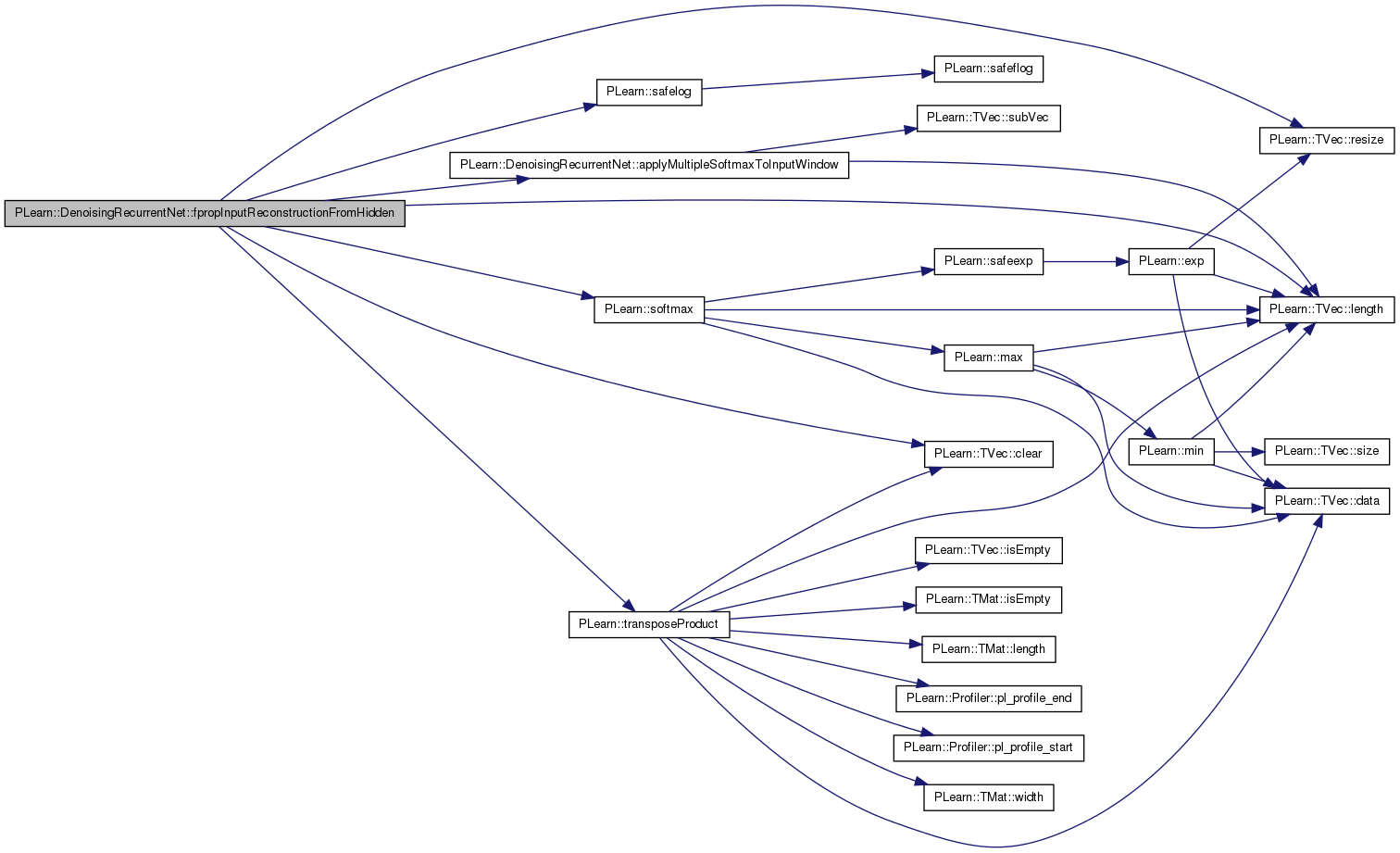

| double PLearn::DenoisingRecurrentNet::fpropUpdateInputReconstructionFromHidden | ( | Vec | hidden, |
| Mat & | reconstruction_weights, | ||
| Mat & | acc_weights_gr, | ||
| Vec & | input_reconstruction_bias, | ||
| Vec & | input_reconstruction_prob, | ||
| Vec | clean_input, | ||
| Vec | hidden_gradient, | ||
| double | input_reconstruction_cost_weight, | ||
| double | lr | ||
| ) | [private] |
Builds input_reconstruction_prob from hidden (using reconstruction_weights which is nhidden x ninputs, and input_reconstruction_bias) then backpropagates reconstruction cost (after comparison with clean_input) with learning rate input_reconstruction_lr accumulates gradient in hidden_gradient, and updates reconstruction_weights and input_reconstruction_bias Also computes neg log cost and returns it.
Definition at line 1373 of file DenoisingRecurrentNet.cc.
References fpropInputReconstructionFromHidden(), and updateInputReconstructionFromHidden().
Referenced by recurrentUpdate().
{
double cost = fpropInputReconstructionFromHidden(hidden, reconstruction_weights, input_reconstruction_bias, input_reconstruction_prob, clean_input);
updateInputReconstructionFromHidden(hidden, reconstruction_weights, acc_weights_gr, input_reconstruction_bias, input_reconstruction_prob,
clean_input, hidden_gradient, input_reconstruction_cost_weight, lr);
return cost;
}
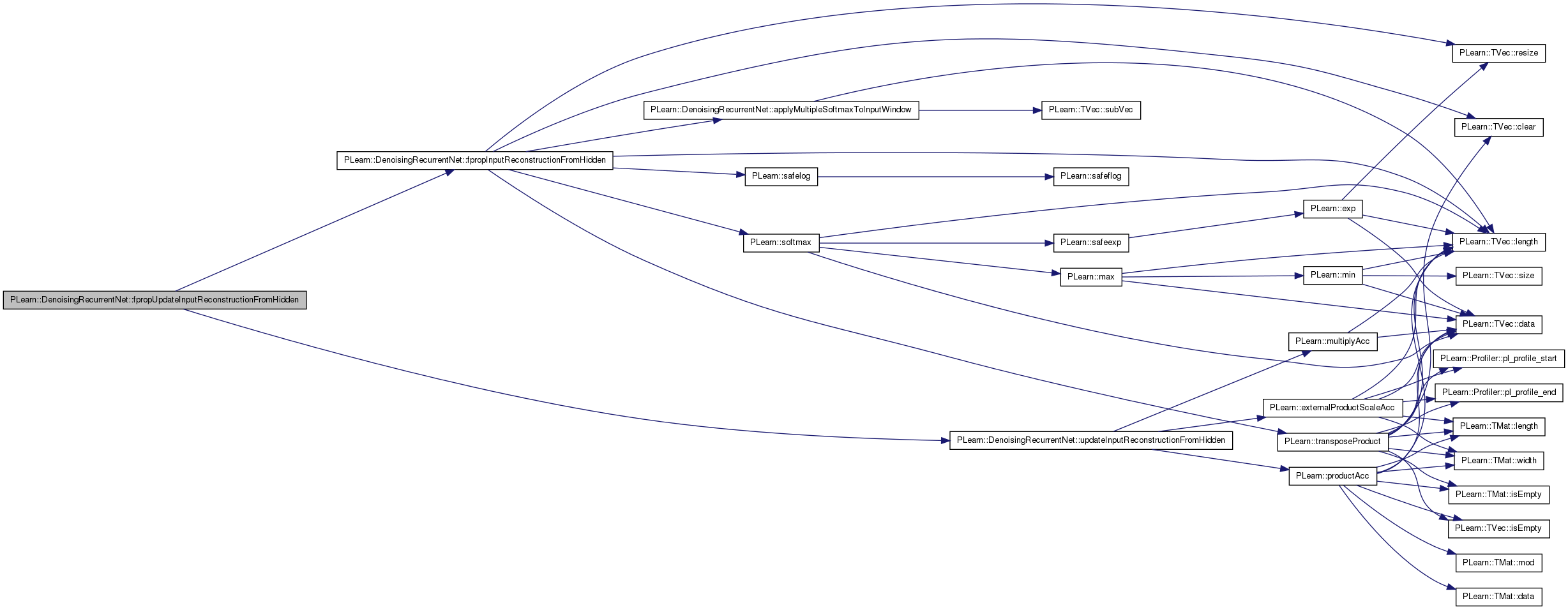

Generate music in a folder.
Definition at line 2705 of file DenoisingRecurrentNet.cc.
References clamp_units(), PLearn::TVec< T >::clear(), data, dynamic_act_no_bias_contribution, dynamic_connections, end_of_sequence_symbol, PLearn::fast_exact_is_equal(), hidden2_act_no_bias_list, hidden2_list, hidden_act_no_bias_list, hidden_connections, hidden_layer, hidden_layer2, hidden_list, i, input_connections, input_layer, input_list, input_symbol_sizes, PLearn::PLearner::inputsize(), j, PLearn::TVec< T >::length(), masks_list, nll_list, outputsize(), PLearn::TVec< T >::resize(), PLearn::TMat< T >::resize(), PLearn::TVec< T >::size(), PLearn::TVec< T >::subVec(), target_connections, target_layers, target_layers_n_of_target_elements, target_layers_weights, target_prediction_act_no_bias_list, target_prediction_list, target_symbol_sizes, targets_list, PLearn::PLearner::targetsize(), and use_target_layers_masks.
{
//PPath* the_filename = "/home/stan/Documents/recherche_maitrise/DDBN_bosendorfer/data/generate/scoreGen.amat";
data = new AutoVMatrix();
//data->filename = "/home/stan/Documents/recherche_maitrise/DDBN_bosendorfer/data/listData/target_tm12_input_t_tm12_tp12/scoreGen_tar_tm12__in_tm12_tp12.amat";
//data->filename = "/home/stan/Documents/recherche_maitrise/DDBN_bosendorfer/create_data/scoreGenSuitePerf.amat";
data->filename = "/home/stan/cvs/Gamme/expressive_data/dataGen.amat";
data->defineSizes(163,16,0);
//data->inputsize = 21;
//data->targetsize = 0;
//data->weightsize = 0;
data->build();
int len = data->length();
int tarSize = outputsize();
int partTarSize;
Vec input;
Vec target;
real weight;
int targsize;
Vec output(outputsize());
output.clear();
// Vec costs(nTestCosts());
// costs.clear();
// Vec n_items(nTestCosts());
// n_items.clear();
int r,r2;
use_target_layers_masks = true;
int ith_sample_in_sequence = 0;
int inputsize_without_masks = inputsize()
- ( use_target_layers_masks ? targetsize() : 0 );
int sum_target_elements = 0;
for (int i = 0; i < len; i++)
{
data->getExample(i, input, target, weight);
if(i>n)
{
for (int k = 1; k <= t; k++)
{
if(k<=i){
partTarSize = outputsize();
for( int tar=0; tar < target_layers.length(); tar++ )
{
input.subVec(inputsize_without_masks-(tarSize*(t-k))-partTarSize-1,target_layers[tar]->size) << target_prediction_list[tar](ith_sample_in_sequence-k);
partTarSize -= target_layers[tar]->size;
}
}
}
}
// for (int k = 1; k <= t; k++)
// {
// partTarSize = outputsize();
// for( int tar=0; tar < target_layers.length(); tar++ )
// {
// if(i>=t){
// input.subVec(inputsize_without_masks-(tarSize*(t-k))-partTarSize-1,target_layers[tar]->size) << target_prediction_list[tar](ith_sample_in_sequence-k);
// partTarSize -= target_layers[tar]->size;
// }
// }
// }
if( fast_exact_is_equal(input[0],end_of_sequence_symbol) )
{
// ith_sample_in_sequence = 0;
// hidden_list.resize(0);
// hidden_act_no_bias_list.resize(0);
// hidden2_list.resize(0);
// hidden2_act_no_bias_list.resize(0);
// target_prediction_list.resize(0);
// target_prediction_act_no_bias_list.resize(0);
// input_list.resize(0);
// targets_list.resize(0);
// nll_list.resize(0,0);
// masks_list.resize(0);
continue;
}
// Resize internal variables
hidden_list.resize(ith_sample_in_sequence+1, hidden_layer->size);
hidden_act_no_bias_list.resize(ith_sample_in_sequence+1, hidden_layer->size);
if( hidden_layer2 )
{
hidden2_list.resize(ith_sample_in_sequence+1, hidden_layer2->size);
hidden2_act_no_bias_list.resize(ith_sample_in_sequence+1, hidden_layer2->size);
}
input_list.resize(ith_sample_in_sequence+1);
input_list[ith_sample_in_sequence].resize(input_layer->size);
targets_list.resize( target_layers.length() );
target_prediction_list.resize( target_layers.length() );
target_prediction_act_no_bias_list.resize( target_layers.length() );
for( int tar=0; tar < target_layers.length(); tar++ )
{
if( !fast_exact_is_equal(target_layers_weights[tar],0) )
{
targsize = target_layers[tar]->size;
targets_list[tar].resize( ith_sample_in_sequence+1, targsize);
//targets_list[tar][ith_sample_in_sequence].resize( target_layers[tar]->size);
target_prediction_list[tar].resize(
ith_sample_in_sequence+1, targsize);
target_prediction_act_no_bias_list[tar].resize(
ith_sample_in_sequence+1, targsize);
}
}
nll_list.resize(ith_sample_in_sequence+1,target_layers.length());
if( use_target_layers_masks )
{
masks_list.resize( target_layers.length() );
for( int tar=0; tar < target_layers.length(); tar++ )
if( !fast_exact_is_equal(target_layers_weights[tar],0) )
masks_list[tar].resize( ith_sample_in_sequence+1, target_layers[tar]->size );
}
// Forward propagation
// Fetch right representation for input
clamp_units(input.subVec(0,inputsize_without_masks),
input_layer,
input_symbol_sizes);
input_list[ith_sample_in_sequence] << input_layer->expectation;
// Fetch right representation for target
sum_target_elements = 0;
for( int tar=0; tar < target_layers.length(); tar++ )
{
if( !fast_exact_is_equal(target_layers_weights[tar],0) )
{
if( use_target_layers_masks )
{
Vec masks_list_tar_i = masks_list[tar](ith_sample_in_sequence);
clamp_units(target.subVec(
sum_target_elements,
target_layers_n_of_target_elements[tar]),
target_layers[tar],
target_symbol_sizes[tar],
input.subVec(
inputsize_without_masks
+ sum_target_elements,
target_layers_n_of_target_elements[tar]),
masks_list_tar_i
);
}
else
{
clamp_units(target.subVec(
sum_target_elements,
target_layers_n_of_target_elements[tar]),
target_layers[tar],
target_symbol_sizes[tar]);
}
targets_list[tar](ith_sample_in_sequence) <<
target_layers[tar]->expectation;
}
sum_target_elements += target_layers_n_of_target_elements[tar];
}
Vec hidden_act_no_bias_i = hidden_act_no_bias_list(ith_sample_in_sequence);
input_connections->fprop( input_list[ith_sample_in_sequence],
hidden_act_no_bias_i);
if( ith_sample_in_sequence > 0 && dynamic_connections )
{
dynamic_connections->fprop(
hidden_list(ith_sample_in_sequence-1),
dynamic_act_no_bias_contribution );
hidden_act_no_bias_list(ith_sample_in_sequence) +=
dynamic_act_no_bias_contribution;
}
Vec hidden_i = hidden_list(ith_sample_in_sequence);
hidden_layer->fprop( hidden_act_no_bias_i,
hidden_i );
Vec last_hidden = hidden_i;
if( hidden_layer2 )
{
Vec hidden2_i = hidden2_list(ith_sample_in_sequence);
Vec hidden2_act_no_bias_i = hidden2_act_no_bias_list(ith_sample_in_sequence);
hidden_connections->fprop(
hidden2_i,
hidden2_act_no_bias_i);
hidden_layer2->fprop(
hidden2_act_no_bias_i,
hidden2_i
);
last_hidden = hidden2_i; // last hidden layer vec
}
for( int tar=0; tar < target_layers.length(); tar++ )
{
if( !fast_exact_is_equal(target_layers_weights[tar],0) )
{
Vec target_prediction_i = target_prediction_list[tar](i);
Vec target_prediction_act_no_bias_i = target_prediction_act_no_bias_list[tar](i);
target_connections[tar]->fprop(
last_hidden,
target_prediction_act_no_bias_i
);
target_layers[tar]->fprop(
target_prediction_act_no_bias_i,
target_prediction_i );
if( use_target_layers_masks )
target_prediction_i *= masks_list[tar](ith_sample_in_sequence);
}
}
sum_target_elements = 0;
for( int tar=0; tar < target_layers.length(); tar++ )
{
if( !fast_exact_is_equal(target_layers_weights[tar],0) )
{
target_layers[tar]->activation <<
target_prediction_act_no_bias_list[tar](
ith_sample_in_sequence);
target_layers[tar]->activation += target_layers[tar]->bias;
target_layers[tar]->setExpectation(
target_prediction_list[tar](
ith_sample_in_sequence));
nll_list(ith_sample_in_sequence,tar) =
target_layers[tar]->fpropNLL(
targets_list[tar](ith_sample_in_sequence) );
// costs[tar] += nll_list(ith_sample_in_sequence,tar);
// // Normalize by the number of things to predict
// if( use_target_layers_masks )
// {
// n_items[tar] += sum(
// input.subVec( inputsize_without_masks
// + sum_target_elements,
// target_layers_n_of_target_elements[tar]) );
// }
// else
// n_items[tar]++;
}
if( use_target_layers_masks )
sum_target_elements +=
target_layers_n_of_target_elements[tar];
}
ith_sample_in_sequence++;
}
// ith_sample_in_sequence = 0;
// hidden_list.resize(0);
// hidden_act_no_bias_list.resize(0);
// hidden2_list.resize(0);
// hidden2_act_no_bias_list.resize(0);
// target_prediction_list.resize(0);
// target_prediction_act_no_bias_list.resize(0);
// input_list.resize(0);
// targets_list.resize(0);
// nll_list.resize(0,0);
// masks_list.resize(0);
//Vec tempo;
//TVec<real> tempo;
//tempo.resize(visible_layer->size);
ofstream myfile;
myfile.open ("/home/stan/Documents/recherche_maitrise/DDBN_bosendorfer/data/generate/test.txt");
for (int i = 0; i < target_prediction_list[0].length() ; i++ ){
for( int tar=0; tar < target_layers.length(); tar++ )
{
for (int j = 0; j < target_prediction_list[tar](i).length() ; j++ ){
//if(i>n){
myfile << target_prediction_list[tar](i)[j] << " ";
// }
//else{
// myfile << targets_list[tar](i)[j] << " ";
// }
}
}
myfile << "\n";
}
myfile.close();
}
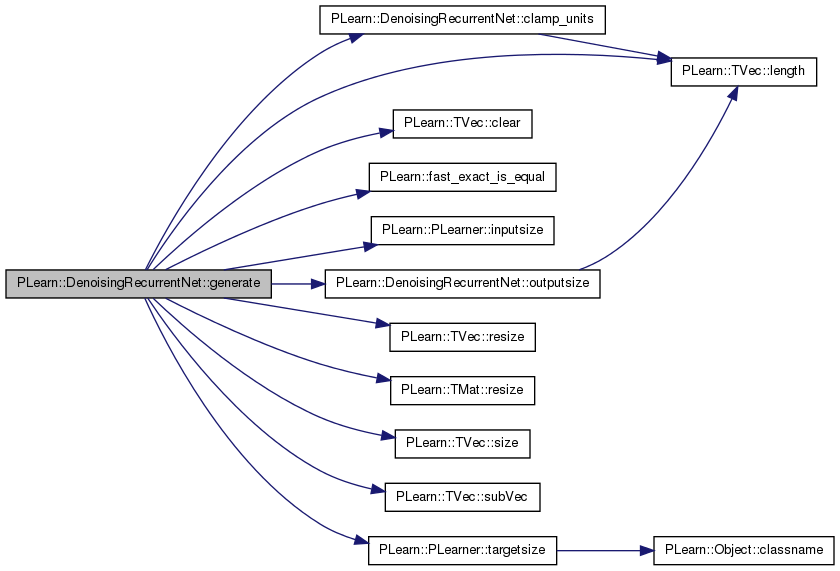
| void PLearn::DenoisingRecurrentNet::generateArtificial | ( | ) |
Generate music in a folder.
Definition at line 3021 of file DenoisingRecurrentNet.cc.
References clamp_units(), PLearn::TVec< T >::clear(), data, dynamic_act_no_bias_contribution, dynamic_connections, end_of_sequence_symbol, PLearn::fast_exact_is_equal(), hidden2_act_no_bias_list, hidden2_list, hidden_act_no_bias_list, hidden_connections, hidden_layer, hidden_layer2, hidden_list, i, input_connections, input_layer, input_list, input_symbol_sizes, PLearn::PLearner::inputsize(), j, PLearn::TVec< T >::length(), masks_list, nll_list, outputsize(), PLearn::TMat< T >::resize(), PLearn::TVec< T >::resize(), PLearn::TVec< T >::size(), PLearn::TVec< T >::subVec(), target_connections, target_layers, target_layers_n_of_target_elements, target_layers_weights, target_prediction_act_no_bias_list, target_prediction_list, target_symbol_sizes, targets_list, PLearn::PLearner::targetsize(), and use_target_layers_masks.
{
//PPath* the_filename = "/home/stan/Documents/recherche_maitrise/DDBN_bosendorfer/data/generate/scoreGen.amat";
data = new AutoVMatrix();
//data->filename = "/home/stan/Documents/recherche_maitrise/DDBN_bosendorfer/data/listData/target_tm12_input_t_tm12_tp12/scoreGen_tar_tm12__in_tm12_tp12.amat";
//data->filename = "/home/stan/Documents/recherche_maitrise/DDBN_bosendorfer/create_data/scoreGenSuitePerf.amat";
//data->filename = "/home/stan/cvs/Gamme/expressive_data/dataGen.amat";
data->filename = "/home/stan/Documents/recherche_maitrise/artificialData/generate/dataGen.amat";
data->defineSizes(1,1,0);
//data->defineSizes(163,16,0);
//data->inputsize = 21;
//data->targetsize = 0;
//data->weightsize = 0;
data->build();
int len = data->length();
int tarSize = outputsize();
int partTarSize;
Vec input;
Vec target;
real weight;
int targsize;
Vec output(outputsize());
output.clear();
// Vec costs(nTestCosts());
// costs.clear();
// Vec n_items(nTestCosts());
// n_items.clear();
int r,r2;
use_target_layers_masks = false;
int ith_sample_in_sequence = 0;
int inputsize_without_masks = inputsize()
- ( use_target_layers_masks ? targetsize() : 0 );
int sum_target_elements = 0;
for (int i = 0; i < len; i++)
{
data->getExample(i, input, target, weight);
/*if(i>n)
{
for (int k = 1; k <= t; k++)
{
if(k<=i){
partTarSize = outputsize();
for( int tar=0; tar < target_layers.length(); tar++ )
{
input.subVec(inputsize_without_masks-(tarSize*(t-k))-partTarSize-1,target_layers[tar]->size) << target_prediction_list[tar](ith_sample_in_sequence-k);
partTarSize -= target_layers[tar]->size;
}
}
}
}*/
// for (int k = 1; k <= t; k++)
// {
// partTarSize = outputsize();
// for( int tar=0; tar < target_layers.length(); tar++ )
// {
// if(i>=t){
// input.subVec(inputsize_without_masks-(tarSize*(t-k))-partTarSize-1,target_layers[tar]->size) << target_prediction_list[tar](ith_sample_in_sequence-k);
// partTarSize -= target_layers[tar]->size;
// }
// }
// }
if( fast_exact_is_equal(input[0],end_of_sequence_symbol) )
{
// ith_sample_in_sequence = 0;
// hidden_list.resize(0);
// hidden_act_no_bias_list.resize(0);
// hidden2_list.resize(0);
// hidden2_act_no_bias_list.resize(0);
// target_prediction_list.resize(0);
// target_prediction_act_no_bias_list.resize(0);
// input_list.resize(0);
// targets_list.resize(0);
// nll_list.resize(0,0);
// masks_list.resize(0);
continue;
}
// Resize internal variables
hidden_list.resize(ith_sample_in_sequence+1, hidden_layer->size);
hidden_act_no_bias_list.resize(ith_sample_in_sequence+1, hidden_layer->size);
if( hidden_layer2 )
{
hidden2_list.resize(ith_sample_in_sequence+1, hidden_layer2->size);
hidden2_act_no_bias_list.resize(ith_sample_in_sequence+1, hidden_layer2->size);
}
input_list.resize(ith_sample_in_sequence+1);
input_list[ith_sample_in_sequence].resize(input_layer->size);
targets_list.resize( target_layers.length() );
target_prediction_list.resize( target_layers.length() );
target_prediction_act_no_bias_list.resize( target_layers.length() );
for( int tar=0; tar < target_layers.length(); tar++ )
{
if( !fast_exact_is_equal(target_layers_weights[tar],0) )
{
targsize = target_layers[tar]->size;
targets_list[tar].resize( ith_sample_in_sequence+1, targsize);
//targets_list[tar][ith_sample_in_sequence].resize( target_layers[tar]->size);
target_prediction_list[tar].resize(
ith_sample_in_sequence+1, targsize);
target_prediction_act_no_bias_list[tar].resize(
ith_sample_in_sequence+1, targsize);
}
}
nll_list.resize(ith_sample_in_sequence+1,target_layers.length());
if( use_target_layers_masks )
{
masks_list.resize( target_layers.length() );
for( int tar=0; tar < target_layers.length(); tar++ )
if( !fast_exact_is_equal(target_layers_weights[tar],0) )
masks_list[tar].resize( ith_sample_in_sequence+1, target_layers[tar]->size );
}
// Forward propagation
// Fetch right representation for input
clamp_units(input.subVec(0,inputsize_without_masks),
input_layer,
input_symbol_sizes);
input_list[ith_sample_in_sequence] << input_layer->expectation;
// Fetch right representation for target
sum_target_elements = 0;
for( int tar=0; tar < target_layers.length(); tar++ )
{
if( !fast_exact_is_equal(target_layers_weights[tar],0) )
{
if( use_target_layers_masks )
{
Vec masks_list_tar_i = masks_list[tar](ith_sample_in_sequence);
clamp_units(target.subVec(
sum_target_elements,
target_layers_n_of_target_elements[tar]),
target_layers[tar],
target_symbol_sizes[tar],
input.subVec(
inputsize_without_masks
+ sum_target_elements,
target_layers_n_of_target_elements[tar]),
masks_list_tar_i
);
}
else
{
clamp_units(target.subVec(
sum_target_elements,
target_layers_n_of_target_elements[tar]),
target_layers[tar],
target_symbol_sizes[tar]);
}
targets_list[tar](ith_sample_in_sequence) <<
target_layers[tar]->expectation;
}
sum_target_elements += target_layers_n_of_target_elements[tar];
}
Vec hidden_act_no_bias_i = hidden_act_no_bias_list(ith_sample_in_sequence);
input_connections->fprop( input_list[ith_sample_in_sequence],
hidden_act_no_bias_i);
if( ith_sample_in_sequence > 0 && dynamic_connections )
{
dynamic_connections->fprop(
hidden_list(ith_sample_in_sequence-1),
dynamic_act_no_bias_contribution );
hidden_act_no_bias_list(ith_sample_in_sequence) +=
dynamic_act_no_bias_contribution;
}
Vec hidden_i = hidden_list(ith_sample_in_sequence);
hidden_layer->fprop( hidden_act_no_bias_i,
hidden_i );
Vec last_hidden = hidden_i;
if( hidden_layer2 )
{
Vec hidden2_i = hidden2_list(ith_sample_in_sequence);
Vec hidden2_act_no_bias_i = hidden2_act_no_bias_list(ith_sample_in_sequence);
hidden_connections->fprop(
hidden2_i,
hidden2_act_no_bias_i);
hidden_layer2->fprop(
hidden2_act_no_bias_i,
hidden2_i
);
last_hidden = hidden2_i; // last hidden layer vec
}
for( int tar=0; tar < target_layers.length(); tar++ )
{
if( !fast_exact_is_equal(target_layers_weights[tar],0) )
{
Vec target_prediction_i = target_prediction_list[tar](i);
Vec target_prediction_act_no_bias_i = target_prediction_act_no_bias_list[tar](i);
target_connections[tar]->fprop(
last_hidden,
target_prediction_act_no_bias_i
);
target_layers[tar]->fprop(
target_prediction_act_no_bias_i,
target_prediction_i );
if( use_target_layers_masks )
target_prediction_i *= masks_list[tar](ith_sample_in_sequence);
}
}
sum_target_elements = 0;
for( int tar=0; tar < target_layers.length(); tar++ )
{
if( !fast_exact_is_equal(target_layers_weights[tar],0) )
{
target_layers[tar]->activation <<
target_prediction_act_no_bias_list[tar](
ith_sample_in_sequence);
target_layers[tar]->activation += target_layers[tar]->bias;
target_layers[tar]->setExpectation(
target_prediction_list[tar](
ith_sample_in_sequence));
nll_list(ith_sample_in_sequence,tar) =
target_layers[tar]->fpropNLL(
targets_list[tar](ith_sample_in_sequence) );
// costs[tar] += nll_list(ith_sample_in_sequence,tar);
// // Normalize by the number of things to predict
// if( use_target_layers_masks )
// {
// n_items[tar] += sum(
// input.subVec( inputsize_without_masks
// + sum_target_elements,
// target_layers_n_of_target_elements[tar]) );
// }
// else
// n_items[tar]++;
}
if( use_target_layers_masks )
sum_target_elements +=
target_layers_n_of_target_elements[tar];
}
ith_sample_in_sequence++;
}
// ith_sample_in_sequence = 0;
// hidden_list.resize(0);
// hidden_act_no_bias_list.resize(0);
// hidden2_list.resize(0);
// hidden2_act_no_bias_list.resize(0);
// target_prediction_list.resize(0);
// target_prediction_act_no_bias_list.resize(0);
// input_list.resize(0);
// targets_list.resize(0);
// nll_list.resize(0,0);
// masks_list.resize(0);
//Vec tempo;
//TVec<real> tempo;
//tempo.resize(visible_layer->size);
ofstream myfile;
myfile.open ("/home/stan/Documents/recherche_maitrise/artificialData/generate/generationResult.txt");
for (int i = 0; i < target_prediction_list[0].length() ; i++ ){
for( int tar=0; tar < target_layers.length(); tar++ )
{
for (int j = 0; j < target_prediction_list[tar](i).length() ; j++ ){
//if(i>n){
myfile << target_prediction_list[tar](i)[j] << " ";
myfile << targets_list[tar](i)[j] << " ";
// }
//else{
// myfile << targets_list[tar](i)[j] << " ";
// }
}
}
myfile << "\n";
}
myfile.close();
}
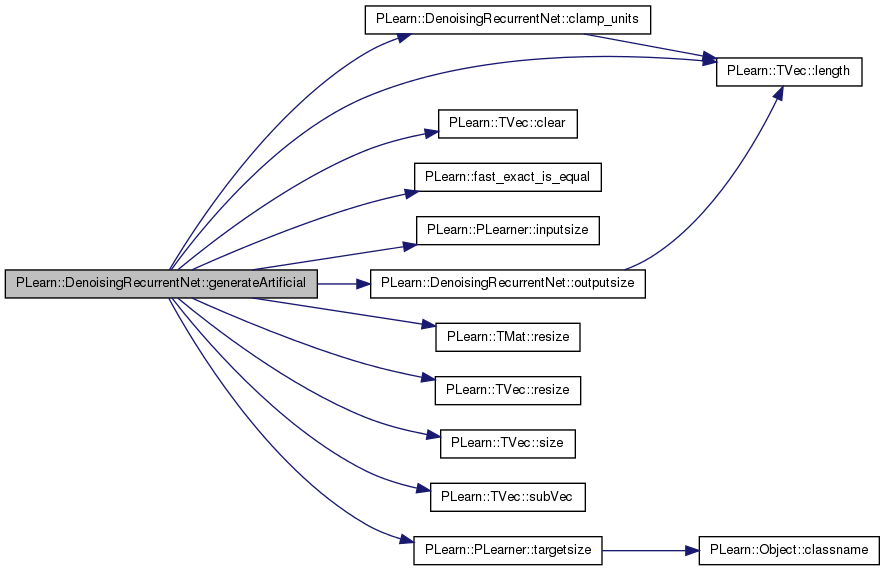
Definition at line 2305 of file DenoisingRecurrentNet.cc.
Referenced by encode_onehot_diffNote_duration(), and encode_onehot_note_octav_duration().
{
if(duration==5) // map infrequent 5 to 4
duration=4;
return duration;
}

| Mat PLearn::DenoisingRecurrentNet::getDynamicConnectionsWeightMatrix | ( | ) | [private] |
Definition at line 1227 of file DenoisingRecurrentNet.cc.
References dynamic_connections, PLERROR, and PLearn::RBMMatrixConnection::weights.
Referenced by recurrentUpdate().
{
RBMMatrixConnection* conn = dynamic_cast<RBMMatrixConnection*>((RBMConnection*)dynamic_connections);
if(conn==0)
PLERROR("Expecting input connection to be a RBMMatrixConnection. Je sais c'est sale, mais au point ou on est rendu..");
return conn->weights;
}

| Mat PLearn::DenoisingRecurrentNet::getDynamicReconstructionConnectionsWeightMatrix | ( | ) | [private] |
Definition at line 1235 of file DenoisingRecurrentNet.cc.
References dynamic_reconstruction_connections, PLERROR, and PLearn::RBMMatrixConnection::weights.
Referenced by recurrentUpdate().
{
RBMMatrixConnection* conn = dynamic_cast<RBMMatrixConnection*>((RBMConnection*)dynamic_reconstruction_connections);
if(conn==0)
PLERROR("Expecting input connection to be a RBMMatrixConnection. Je sais c'est sale, mais au point ou on est rendu..");
return conn->weights;
}

| Mat PLearn::DenoisingRecurrentNet::getInputConnectionsWeightMatrix | ( | ) | [private] |
Definition at line 1219 of file DenoisingRecurrentNet.cc.
References input_connections, PLERROR, and PLearn::RBMMatrixConnection::weights.
Referenced by recurrentUpdate().
{
RBMMatrixConnection* conn = dynamic_cast<RBMMatrixConnection*>((RBMConnection*)input_connections);
if(conn==0)
PLERROR("Expecting input connection to be a RBMMatrixConnection. Je sais c'est sale, mais au point ou on est rendu..");
return conn->weights;
}

| static Vec PLearn::DenoisingRecurrentNet::getInputWindow | ( | Mat | sequence, |
| int | startpos, | ||
| int | winsize | ||
| ) | [inline, static] |
Definition at line 209 of file DenoisingRecurrentNet.h.
References PLearn::TMat< T >::subMatRows(), and PLearn::TMat< T >::toVec().
{ return sequence.subMatRows(startpos, winsize).toVec(); }

| static void PLearn::DenoisingRecurrentNet::getNoteAndOctave | ( | int | midi_number, |
| int & | note, | ||
| int & | octave | ||
| ) | [inline, static] |
Definition at line 213 of file DenoisingRecurrentNet.h.
{
note = midi_number%12;
octave = midi_number/12;
}
| OptionList & PLearn::DenoisingRecurrentNet::getOptionList | ( | ) | const [virtual] |
Reimplemented from PLearn::Object.
Definition at line 71 of file DenoisingRecurrentNet.cc.
| OptionMap & PLearn::DenoisingRecurrentNet::getOptionMap | ( | ) | const [virtual] |
Reimplemented from PLearn::Object.
Definition at line 71 of file DenoisingRecurrentNet.cc.
| RemoteMethodMap & PLearn::DenoisingRecurrentNet::getRemoteMethodMap | ( | ) | const [virtual] |
Reimplemented from PLearn::Object.
Definition at line 71 of file DenoisingRecurrentNet.cc.
Returns the ith sequence.
Definition at line 2273 of file DenoisingRecurrentNet.cc.
References i, PLearn::TMat< T >::resize(), PLearn::PLearner::train_set, trainset_boundaries, w, and PLearn::VMat::width().
Referenced by train(), and trainUnconditionalPredictor().
{
int start = 0;
if(i>0)
start = trainset_boundaries[i-1]+1;
int end = trainset_boundaries[i];
int w = train_set->width();
seq.resize(end-start, w);
train_set->getMat(start,0,seq);
}


Definition at line 1211 of file DenoisingRecurrentNet.cc.
References PLERROR, target_connections, and PLearn::RBMMatrixConnection::weights.
Referenced by recurrentUpdate().
{
RBMMatrixConnection* conn = dynamic_cast<RBMMatrixConnection*>((RBMConnection*)target_connections[tar]);
if(conn==0)
PLERROR("Expecting input connection to be a RBMMatrixConnection. Je sais c'est sale, mais au point ou on est rendu..");
return conn->weights;
}

| TVec< string > PLearn::DenoisingRecurrentNet::getTestCostNames | ( | ) | const [virtual] |
Returns the names of the costs computed by computeCostsFromOutpus (and thus the test method).
Implements PLearn::PLearner.
Definition at line 2684 of file DenoisingRecurrentNet.cc.
References PLearn::TVec< T >::append(), i, PLearn::TVec< T >::length(), target_layers, and PLearn::tostring().
Referenced by getTrainCostNames().
{
TVec<string> cost_names(0);
for( int i=0; i<target_layers.length(); i++ )
cost_names.append("target" + tostring(i) + ".NLL");
return cost_names;
}


| TVec< string > PLearn::DenoisingRecurrentNet::getTrainCostNames | ( | ) | const [virtual] |
Returns the names of the objective costs that the train method computes and for which it updates the VecStatsCollector train_stats.
Implements PLearn::PLearner.
Definition at line 2692 of file DenoisingRecurrentNet.cc.
References getTestCostNames().
Referenced by train(), and trainUnconditionalPredictor().
{
return getTestCostNames();
}


| void PLearn::DenoisingRecurrentNet::inject_zero_forcing_noise | ( | Mat | sequence, |
| double | noise_prob | ||
| ) | const |
Definition at line 2466 of file DenoisingRecurrentNet.cc.
References PLearn::TMat< T >::data(), PLearn::TMat< T >::isCompact(), n, PLERROR, PLearn::PLearner::random_gen, and PLearn::TMat< T >::size().
Referenced by fpropHiddenReconstructionFromLastHidden(), and splitRawMaskedSupervisedSequence().
{
if(!sequence.isCompact())
PLERROR("Expected a compact sequence");
real* p = sequence.data();
int n = sequence.size();
while(n--)
{
if(*p!=real(0.) && random_gen->uniform_sample()<noise_prob)
*p = real(0.);
++p;
}
}


| void PLearn::DenoisingRecurrentNet::inject_zero_forcing_noise | ( | Vec | sequence, |
| double | noise_prob | ||
| ) | const |
Definition at line 2481 of file DenoisingRecurrentNet.cc.
References PLearn::TVec< T >::data(), n, PLearn::PLearner::random_gen, and PLearn::TVec< T >::size().
{
real* p = sequence.data();
int n = sequence.size();
while(n--)
{
if(*p!=real(0.) && random_gen->uniform_sample()<noise_prob)
*p = real(0.);
++p;
}
}

| void PLearn::DenoisingRecurrentNet::locateSequenceBoundaries | ( | VMat | dataset, |
| TVec< int > & | boundaries, | ||
| real | end_of_sequence_symbol | ||
| ) | [static] |
Definition at line 2292 of file DenoisingRecurrentNet.cc.
References PLearn::TVec< T >::append(), i, PLearn::VMat::length(), and PLearn::TVec< T >::resize().
Referenced by setTrainingSet(), and test().
{
boundaries.resize(10000);
boundaries.resize(0);
int l = dataset->length();
for(int i=0; i<l; i++)
{
if(dataset(i,0)==end_of_sequence_symbol)
boundaries.append(i);
}
}


| void PLearn::DenoisingRecurrentNet::makeDeepCopyFromShallowCopy | ( | CopiesMap & | copies | ) | [virtual] |
Transforms a shallow copy into a deep copy.
Reimplemented from PLearn::PLearner.
Definition at line 511 of file DenoisingRecurrentNet.cc.
References acc_dynamic_connections_gr, acc_hidden_bias_gr, acc_input_connections_gr, acc_recons_bias_gr, acc_reconstruction_dynamic_connections_gr, acc_target_bias_gr, acc_target_connections_gr, bias_gradient, clean_encoded_seq, data, PLearn::deepCopyField(), dynamic_act_no_bias_contribution, dynamic_connections, dynamic_reconstruction_connections, encoded_seq, hidden2_act_no_bias_list, hidden2_list, hidden_act_no_bias_list, hidden_connections, hidden_gradient, hidden_layer, hidden_layer2, hidden_list, hidden_reconstruction_bias, hidden_reconstruction_bias2, hidden_reconstruction_prob, hidden_temporal_gradient, input_connections, input_layer, input_list, input_reconstruction_bias, input_reconstruction_prob, input_symbol_sizes, PLearn::PLearner::makeDeepCopyFromShallowCopy(), masks_list, mean_encoded_vec, nll_list, seq, target_connections, target_layers, target_layers_n_of_target_elements, target_layers_weights, target_prediction_act_no_bias_list, target_prediction_list, target_symbol_sizes, targets_list, testset_boundaries, trainset_boundaries, and visi_bias_gradient.
{
inherited::makeDeepCopyFromShallowCopy(copies);
// Public fields
deepCopyField( target_layers_weights, copies );
deepCopyField( input_layer, copies);
deepCopyField( target_layers , copies);
deepCopyField( hidden_layer, copies);
deepCopyField( hidden_layer2 , copies);
deepCopyField( dynamic_connections , copies);
deepCopyField( dynamic_reconstruction_connections , copies);
deepCopyField( hidden_connections , copies);
deepCopyField( input_connections , copies);
deepCopyField( target_connections , copies);
deepCopyField( target_layers_n_of_target_elements, copies);
deepCopyField( input_symbol_sizes, copies);
deepCopyField( target_symbol_sizes, copies);
deepCopyField( mean_encoded_vec, copies);
deepCopyField( input_reconstruction_bias, copies);
deepCopyField( hidden_reconstruction_bias, copies);
deepCopyField( hidden_reconstruction_bias2, copies);
// Protected fields
deepCopyField( data, copies);
deepCopyField( acc_target_connections_gr, copies);
deepCopyField( acc_input_connections_gr, copies);
deepCopyField( acc_dynamic_connections_gr, copies);
deepCopyField( acc_reconstruction_dynamic_connections_gr, copies);
deepCopyField( acc_target_bias_gr, copies);
deepCopyField( acc_hidden_bias_gr, copies);
deepCopyField( acc_recons_bias_gr, copies);
deepCopyField( bias_gradient , copies);
deepCopyField( visi_bias_gradient , copies);
deepCopyField( hidden_gradient , copies);
deepCopyField( hidden_temporal_gradient , copies);
deepCopyField( hidden_list , copies);
deepCopyField( hidden_act_no_bias_list , copies);
deepCopyField( hidden2_list , copies);
deepCopyField( hidden2_act_no_bias_list , copies);
deepCopyField( target_prediction_list , copies);
deepCopyField( target_prediction_act_no_bias_list , copies);
deepCopyField( input_list , copies);
deepCopyField( targets_list , copies);
deepCopyField( nll_list , copies);
deepCopyField( masks_list , copies);
deepCopyField( dynamic_act_no_bias_contribution, copies);
deepCopyField( trainset_boundaries, copies);
deepCopyField( testset_boundaries, copies);
deepCopyField( seq, copies);
deepCopyField( encoded_seq, copies);
deepCopyField( clean_encoded_seq, copies);
deepCopyField( input_reconstruction_prob, copies);
deepCopyField( hidden_reconstruction_prob, copies);
// deepCopyField(, copies);
//PLERROR("DenoisingRecurrentNet::makeDeepCopyFromShallowCopy(): "
//"not implemented yet");
}

| int PLearn::DenoisingRecurrentNet::nSequences | ( | ) | const [inline] |
Returns the number of sequences in the training_set.
Definition at line 262 of file DenoisingRecurrentNet.h.
References PLearn::TVec< T >::length(), and trainset_boundaries.
Referenced by train(), and trainUnconditionalPredictor().
{ return trainset_boundaries.length(); }


| int PLearn::DenoisingRecurrentNet::outputsize | ( | ) | const [virtual] |
Returns the size of this learner's output, (which typically may depend on its inputsize(), targetsize() and set options).
Implements PLearn::PLearner.
Definition at line 574 of file DenoisingRecurrentNet.cc.
References i, PLearn::TVec< T >::length(), and target_layers.
Referenced by generate(), generateArtificial(), and test().
{
int out_size = 0;
for( int i=0; i<target_layers.length(); i++ )
out_size += target_layers[i]->size;
return out_size;
}


| void PLearn::DenoisingRecurrentNet::partition | ( | TVec< double > | part, |
| TVec< double > | periode, | ||
| TVec< double > | vel | ||
| ) | const |
Use the partition.
| void PLearn::DenoisingRecurrentNet::recurrentFprop | ( | Vec | train_costs, |
| Vec | train_n_items, | ||
| bool | useDynamicConnections = true |
||
| ) | const [private] |
Definition at line 1125 of file DenoisingRecurrentNet.cc.
References dynamic_act_no_bias_contribution, dynamic_connections, PLearn::fast_exact_is_equal(), hidden2_act_no_bias_list, hidden2_list, hidden_act_no_bias_list, hidden_connections, hidden_layer, hidden_layer2, hidden_list, i, input_connections, input_list, PLearn::TVec< T >::length(), masks_list, nll_list, PLearn::sum(), target_connections, target_layers, target_layers_weights, target_prediction_act_no_bias_list, target_prediction_list, targets_list, and use_target_layers_masks.
Referenced by test(), and train().
{
int l = input_list.length();
int ntargets = target_layers.length();
for(int i=0; i<l; i++ )
{
Vec hidden_act_no_bias_i = hidden_act_no_bias_list(i);
input_connections->fprop( input_list[i], hidden_act_no_bias_i);
if(useDynamicConnections){
if( i > 0 && dynamic_connections )
{
Vec hidden_i_prev = hidden_list(i-1);
dynamic_connections->fprop(hidden_i_prev,dynamic_act_no_bias_contribution );
hidden_act_no_bias_i += dynamic_act_no_bias_contribution;
}
}
Vec hidden_i = hidden_list(i);
hidden_layer->fprop( hidden_act_no_bias_i,
hidden_i);
Vec last_hidden = hidden_i;
if( hidden_layer2 )
{
Vec hidden2_i = hidden2_list(i);
Vec hidden2_act_no_bias_i = hidden2_act_no_bias_list(i);
hidden_connections->fprop(hidden_i, hidden2_act_no_bias_i);
hidden_layer2->fprop(hidden2_act_no_bias_i, hidden2_i);
last_hidden = hidden2_i; // last hidden layer vec
}
for( int tar=0; tar < ntargets; tar++ )
{
if( !fast_exact_is_equal(target_layers_weights[tar],0) )
{
Vec target_prediction_i = target_prediction_list[tar](i);
Vec target_prediction_act_no_bias_i = target_prediction_act_no_bias_list[tar](i);
target_connections[tar]->fprop(last_hidden, target_prediction_act_no_bias_i);
target_layers[tar]->fprop(target_prediction_act_no_bias_i, target_prediction_i);
if( use_target_layers_masks )
target_prediction_i *= masks_list[tar](i);
target_layers[tar]->activation << target_prediction_act_no_bias_i;
target_layers[tar]->activation += target_layers[tar]->bias;
target_layers[tar]->setExpectation(target_prediction_i);
Vec target_vec = targets_list[tar](i);
nll_list(i,tar) = target_layers[tar]->fpropNLL(target_vec);
train_costs[tar] += nll_list(i,tar);
// Normalize by the number of things to predict
if( use_target_layers_masks )
train_n_items[tar] += sum(masks_list[tar](i));
else
train_n_items[tar]++;
}
}
}
//if(noise)
// inject_zero_forcing_noise(hidden_list, input_noise_prob);
}
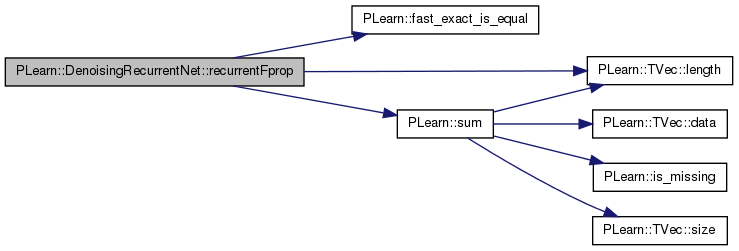

| void PLearn::DenoisingRecurrentNet::recurrentUpdate | ( | real | input_reconstruction_weight, |
| real | hidden_reconstruction_cost_weight, | ||
| real | temporal_gradient_contribution, | ||
| real | prediction_cost_weight, | ||
| real | inputAndDynamicPart, | ||
| Vec | train_costs, | ||
| Vec | train_n_items | ||
| ) |
Updates both the RBM parameters and the dynamic connections in the recurrent tuning phase, after the visible units have been clamped.
Definition at line 1862 of file DenoisingRecurrentNet.cc.
References acc_dynamic_connections_gr, acc_input_connections_gr, acc_reconstruction_dynamic_connections_gr, acc_target_connections_gr, bias_gradient, bpropUpdateConnection(), bpropUpdateHiddenLayer(), PLearn::TMat< T >::clear(), PLearn::TVec< T >::clear(), current_learning_rate, dynamic_connections, PLearn::fast_exact_is_equal(), fpropHiddenReconstructionFromLastHidden(), fpropUpdateInputReconstructionFromHidden(), getDynamicConnectionsWeightMatrix(), getDynamicReconstructionConnectionsWeightMatrix(), getInputConnectionsWeightMatrix(), getTargetConnectionsWeightMatrix(), hidden2_act_no_bias_list, hidden2_list, hidden_act_no_bias_list, hidden_connections, hidden_gradient, hidden_layer, hidden_layer2, hidden_list, hidden_reconstruction_bias, hidden_reconstruction_bias2, hidden_reconstruction_prob, hidden_temporal_gradient, i, input_connections, input_list, input_reconstruction_bias, input_reconstruction_prob, PLearn::TMat< T >::length(), PLearn::TVec< T >::length(), masks_list, PLearn::multiplyAcc(), nll_list, PLearn::TMat< T >::resize(), PLearn::TVec< T >::resize(), target_connections, target_layers, target_layers_weights, target_prediction_act_no_bias_list, target_prediction_list, targets_list, updateTargetLayer(), use_target_layers_masks, and visi_bias_gradient.
Referenced by train().
{
TVec < Mat> targetWeights ;
Mat inputWeights;
Mat dynamicWeights;
Mat reconsWeights;
targetWeights.resize(target_connections.length());
for( int tar=0; tar<target_layers.length(); tar++)
{
targetWeights[tar] = getTargetConnectionsWeightMatrix(tar);
}
inputWeights = getInputConnectionsWeightMatrix();
if(dynamic_connections )
{
dynamicWeights = getDynamicConnectionsWeightMatrix();
reconsWeights = getDynamicReconstructionConnectionsWeightMatrix();
}
acc_target_connections_gr.resize(target_connections.length());
for( int tar=0; tar<target_layers.length(); tar++)
{
acc_target_connections_gr[tar].resize(target_connections[tar]->up_size, target_connections[tar]->down_size);
acc_target_connections_gr[tar].clear();
}
acc_input_connections_gr.resize(input_connections->up_size, input_connections->down_size);
acc_input_connections_gr.clear();
if(dynamic_connections )
{
acc_dynamic_connections_gr.resize(dynamic_connections->up_size, dynamic_connections->down_size);
acc_dynamic_connections_gr.clear();
acc_reconstruction_dynamic_connections_gr.resize(dynamic_connections->down_size, dynamic_connections->up_size);
acc_reconstruction_dynamic_connections_gr.clear();
}
hidden_temporal_gradient.resize(hidden_layer->size);
hidden_temporal_gradient.clear();
for(int i=hidden_list.length()-1; i>=0; i--){
if( hidden_layer2 )
hidden_gradient.resize(hidden_layer2->size);
else
hidden_gradient.resize(hidden_layer->size);
hidden_gradient.clear();
if( predic_cost_weight!=0 )
{
for( int tar=0; tar<target_layers.length(); tar++)
{
if( !fast_exact_is_equal(target_layers_weights[tar],0) )
{
target_layers[tar]->activation << target_prediction_act_no_bias_list[tar](i);
target_layers[tar]->activation += target_layers[tar]->bias;
target_layers[tar]->setExpectation(target_prediction_list[tar](i));
target_layers[tar]->bpropNLL(targets_list[tar](i),nll_list(i,tar),bias_gradient);
bias_gradient *= predic_cost_weight;
if(use_target_layers_masks)
bias_gradient *= masks_list[tar](i);
//target_layers[tar]->update(bias_gradient);
updateTargetLayer( bias_gradient,
target_layers[tar]->bias,
target_layers[tar]->learning_rate );
//Mat targetWeights = getTargetConnectionsWeightMatrix(tar);
if( hidden_layer2 ){
//target_connections[tar]->bpropUpdate(hidden2_list(i),target_prediction_act_no_bias_list[tar](i),hidden_gradient, bias_gradient,true);
bpropUpdateConnection(hidden2_list(i),
target_prediction_act_no_bias_list[tar](i),
hidden_gradient,
bias_gradient,
targetWeights[tar],
acc_target_connections_gr[tar],
target_connections[tar]->down_size,
target_connections[tar]->up_size,
target_connections[tar]->learning_rate,
true,
false);
}
else{
//target_connections[tar]->bpropUpdate(hidden_list(i),target_prediction_act_no_bias_list[tar](i),hidden_gradient, bias_gradient,true);
bpropUpdateConnection(hidden_list(i),
target_prediction_act_no_bias_list[tar](i),
hidden_gradient,
bias_gradient,
targetWeights[tar],
acc_target_connections_gr[tar],
target_connections[tar]->down_size,
target_connections[tar]->up_size,
target_connections[tar]->learning_rate,
true,
false);
}
}
}
if (hidden_layer2)
{
hidden_layer2->bpropUpdate(
hidden2_act_no_bias_list(i), hidden2_list(i),
bias_gradient, hidden_gradient);
hidden_connections->bpropUpdate(
hidden_list(i),
hidden2_act_no_bias_list(i),
hidden_gradient, bias_gradient);
}
}
if(inputAndDynamicPart){
// Add contribution of input reconstruction cost in hidden_gradient
if(input_reconstruction_weight!=0)
{
//Mat reconstruction_weights = getInputConnectionsWeightMatrix();
//Vec clean_input = clean_encoded_seq.subMatRows(i, input_window_size).toVec();
train_costs[train_costs.length()-2] += fpropUpdateInputReconstructionFromHidden(hidden_list(i), inputWeights, acc_input_connections_gr, input_reconstruction_bias, input_reconstruction_prob,
input_list[i], hidden_gradient, input_reconstruction_weight, current_learning_rate);
train_n_items[train_costs.length()-2]++;
}
//if(i!=0 && dynamic_connections )
if(i>1 && dynamic_connections )
{
// Add contribution of hidden reconstruction cost in hidden_gradient
Vec hidden_reconstruction_activation_grad;
hidden_reconstruction_activation_grad.resize(hidden_layer->size);
//Mat reconstruction_weights = getDynamicConnectionsWeightMatrix();
if(hidden_reconstruction_weight!=0)
{
//Vec hidden_reconstruction_activation_grad;
//Mat reconstruction_weights = getDynamicConnectionsWeightMatrix();
//truc stan
//fpropHiddenSymmetricDynamicMatrix(hidden_list(i-1), reconstruction_weights, hidden_reconstruction_prob, hidden_list(i), hidden_gradient, hidden_reconstruction_weight, current_learning_rate);
train_costs[train_costs.length()-1] += fpropHiddenReconstructionFromLastHidden(input_list[i],
hidden_list(i),
dynamicWeights, //reconsWeights, //dynamicWeights,
acc_dynamic_connections_gr, //acc_reconstruction_dynamic_connections_gr, //acc_dynamic_connections_gr,
hidden_reconstruction_bias,
hidden_reconstruction_bias2,
hidden_reconstruction_activation_grad,
hidden_reconstruction_prob,
hidden_list(i-1),
hidden_gradient,
hidden_reconstruction_weight,
current_learning_rate);
/*
train_costs[train_costs.length()-1] += fpropHiddenReconstructionFromLastHidden2(input_list[i],
hidden_list(i),
dynamicWeights, //reconsWeights, //dynamicWeights,
acc_dynamic_connections_gr, //acc_reconstruction_dynamic_connections_gr, //acc_dynamic_connections_gr,
hidden_reconstruction_bias,
hidden_reconstruction_bias2,
hidden_reconstruction_activation_grad,
hidden_reconstruction_prob,
hidden_list(i-2),
hidden_gradient,
hidden_reconstruction_weight,
current_learning_rate);
*/
//fpropHiddenReconstructionFromLastHidden(hidden_list(i), reconsWeights, acc_reconstruction_dynamic_connections_gr, hidden_reconstruction_bias, hidden_reconstruction_activation_grad, hidden_reconstruction_prob, hidden_list(i-1), hidden_gradient, hidden_reconstruction_weight, current_learning_rate);
train_n_items[train_costs.length()-1]++;
}
// add contribution to gradient of next time step hidden layer
if(temporal_gradient_contribution>0)
{ // add weighted contribution of hidden_temporal gradient to hidden_gradient
// It does this: hidden_gradient += temporal_gradient_contribution*hidden_temporal_gradient;
multiplyAcc(hidden_gradient, hidden_temporal_gradient, temporal_gradient_contribution);
}
bpropUpdateHiddenLayer(hidden_act_no_bias_list(i),
hidden_list(i),
hidden_temporal_gradient,
hidden_gradient,
hidden_layer->bias,
hidden_layer->learning_rate );
//input
//if(hidden_reconstruction_weight==0)
//{
bpropUpdateConnection(input_list[i],
hidden_act_no_bias_list(i),
visi_bias_gradient,
hidden_temporal_gradient,// Here, it should be activations - cond_bias, but doesn't matter
inputWeights,
acc_input_connections_gr,
input_connections->down_size,
input_connections->up_size,
input_connections->learning_rate,
false,
true);
//}
//Dynamic
//if(input_reconstruction_weight==0)
//{
/*bpropUpdateHiddenLayer(hidden_act_no_bias_list(i),
hidden_list(i),
hidden_temporal_gradient,
hidden_gradient,
hidden_layer->bias,
hidden_layer->learning_rate );*/
bpropUpdateConnection(hidden_list(i-1),
hidden_act_no_bias_list(i), // Here, it should be dynamic_act_no_bias_contribution, but doesn't matter because a RBMMatrixConnection::bpropUpdate doesn't use its second argument
hidden_gradient,
hidden_temporal_gradient,
dynamicWeights,
acc_dynamic_connections_gr,
dynamic_connections->down_size,
dynamic_connections->up_size,
dynamic_connections->learning_rate,
false,
false);
//}
hidden_temporal_gradient << hidden_gradient;
//if(hidden_reconstruction_weight!=0)
// hidden_temporal_gradient += hidden_reconstruction_activation_grad;
}
else
{
if(input_reconstruction_weight==0)
{
bpropUpdateHiddenLayer(hidden_act_no_bias_list(i),
hidden_list(i),
hidden_temporal_gradient, // Not really temporal gradient, but this is the final iteration...
hidden_gradient,
hidden_layer->bias,
hidden_layer->learning_rate );
//input
bpropUpdateConnection(input_list[i],
hidden_act_no_bias_list(i),
visi_bias_gradient,
hidden_temporal_gradient,// Here, it should be activations - cond_bias, but doesn't matter
inputWeights,
acc_input_connections_gr,
input_connections->down_size,
input_connections->up_size,
input_connections->learning_rate,
false,
true);
}
}
}
}
//update matrice's connections
for( int tar=0; tar<target_layers.length(); tar++)
{
multiplyAcc(targetWeights[tar], acc_target_connections_gr[tar], 1);
}
multiplyAcc(inputWeights, acc_input_connections_gr, 1);
if(dynamic_connections )
{
multiplyAcc(dynamicWeights, acc_dynamic_connections_gr, 1);
//multiplyAcc(reconsWeights, acc_reconstruction_dynamic_connections_gr, 1);
}
/* int r;
int modulo;
if(input_reconstruction_weight!=0)
modulo = 2;
else
modulo=3;
r = rand() % modulo +1;
if(r==1)
{
multiplyAcc(inputWeights, acc_input_connections_gr, 1);
}
else if (r==2){
if(dynamic_connections )
{
multiplyAcc(dynamicWeights, acc_dynamic_connections_gr, 1);
//multiplyAcc(reconsWeights, acc_reconstruction_dynamic_connections_gr, 1);
}
}
else {
//update matrice's connections
for( int tar=0; tar<target_layers.length(); tar++)
{
multiplyAcc(targetWeights[tar], acc_target_connections_gr[tar], 1);
}
}*/
}
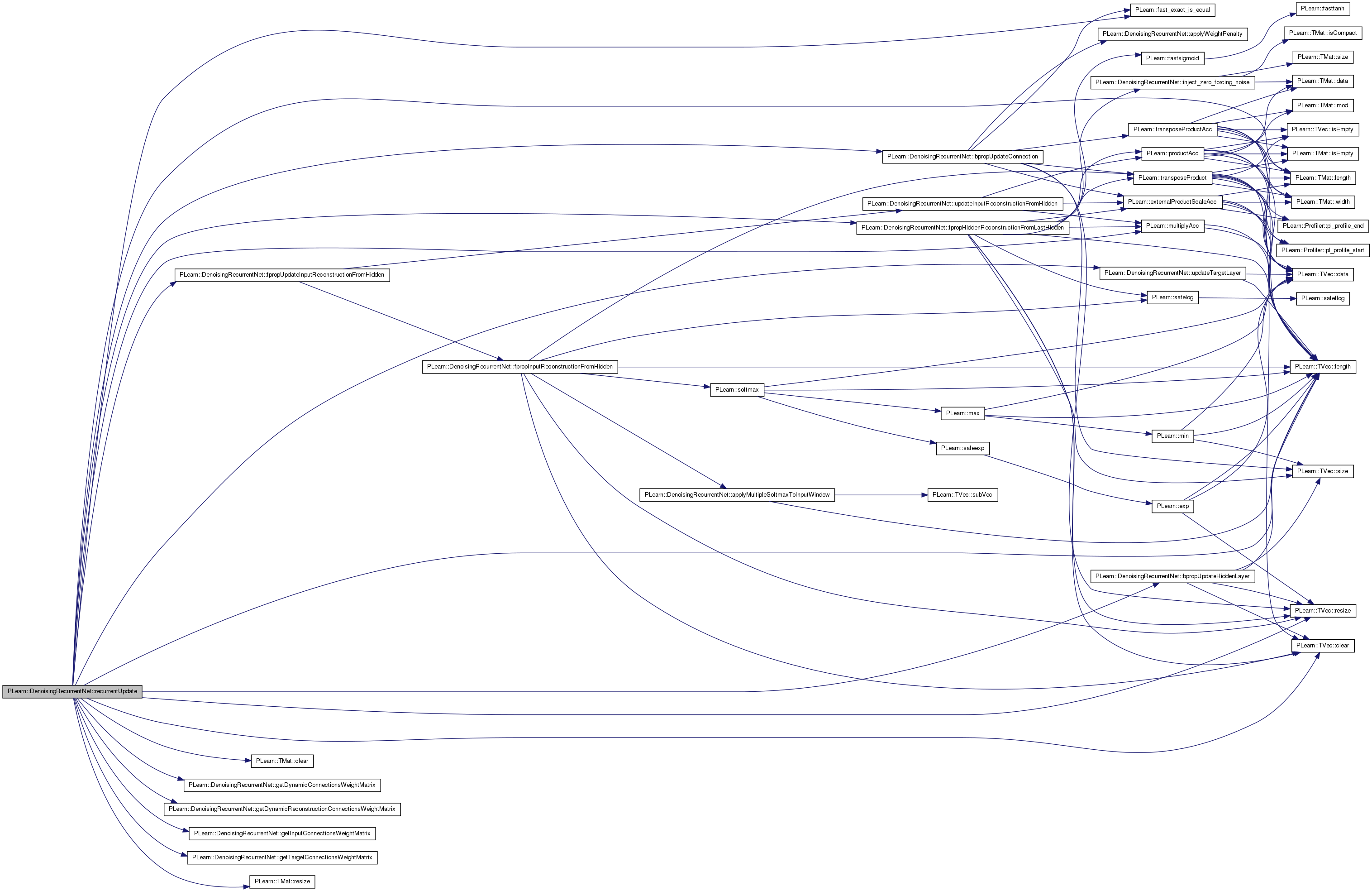

| void PLearn::DenoisingRecurrentNet::resize_lists | ( | int | l | ) | const [private] |
Definition at line 1054 of file DenoisingRecurrentNet.cc.
References hidden2_act_no_bias_list, hidden2_list, hidden_act_no_bias_list, hidden_layer, hidden_layer2, hidden_list, input_list, PLearn::TVec< T >::length(), nll_list, PLearn::TMat< T >::resize(), PLearn::TVec< T >::resize(), PLearn::TVec< T >::size(), target_layers, target_prediction_act_no_bias_list, and target_prediction_list.
Referenced by encode_artificialData(), encodeAndCreateSupervisedSequence(), encodeAndCreateSupervisedSequence2(), and splitRawMaskedSupervisedSequence().
{
input_list.resize(l);
hidden_list.resize(l, hidden_layer->size);
hidden_act_no_bias_list.resize(l, hidden_layer->size);
if( hidden_layer2 )
{
hidden2_list.resize(l, hidden_layer2->size);
hidden2_act_no_bias_list.resize(l, hidden_layer2->size);
}
int ntargets = target_layers.length();
target_prediction_list.resize( ntargets );
target_prediction_act_no_bias_list.resize( ntargets );
for( int tar=0; tar < ntargets; tar++ )
{
int targsize = target_layers[tar]->size;
target_prediction_list[tar].resize(l, targsize);
target_prediction_act_no_bias_list[tar].resize(l, targsize);
}
nll_list.resize(l,ntargets);
}
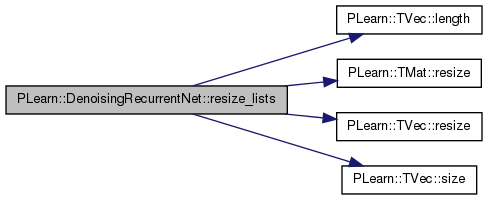

| void PLearn::DenoisingRecurrentNet::setLearningRate | ( | real | the_learning_rate | ) |
Sets the learning of all layers and connections Remembers it by copying value to current_learning_rate.
Definition at line 2550 of file DenoisingRecurrentNet.cc.
References current_learning_rate, dynamic_connections, dynamic_reconstruction_connections, hidden_connections, hidden_layer, hidden_layer2, i, input_connections, input_layer, PLearn::TVec< T >::length(), target_connections, and target_layers.
Referenced by train().
{
current_learning_rate = the_learning_rate;
input_layer->setLearningRate( the_learning_rate );
hidden_layer->setLearningRate( the_learning_rate );
input_connections->setLearningRate( the_learning_rate );
if( dynamic_connections ){
//dynamic_connections->setLearningRate( dynamic_gradient_scale_factor*the_learning_rate );
dynamic_connections->setLearningRate( the_learning_rate );
}
if( dynamic_reconstruction_connections ){
//dynamic_reconstruction_connections->setLearningRate( dynamic_gradient_scale_factor*the_learning_rate );
dynamic_reconstruction_connections->setLearningRate( the_learning_rate );
}
if( hidden_layer2 )
{
hidden_layer2->setLearningRate( the_learning_rate );
hidden_connections->setLearningRate( the_learning_rate );
}
for( int i=0; i<target_layers.length(); i++ )
{
target_layers[i]->setLearningRate( the_learning_rate );
target_connections[i]->setLearningRate( the_learning_rate );
}
}


| void PLearn::DenoisingRecurrentNet::setTrainingSet | ( | VMat | training_set, |
| bool | call_forget = true |
||
| ) | [virtual] |
Declares the training set.
Then calls build() and forget() if necessary. Also sets this learner's inputsize_ targetsize_ weightsize_ from those of the training_set. Note: You shouldn't have to override this in subclasses, except in maybe to forward the call to an underlying learner.
Reimplemented from PLearn::PLearner.
Definition at line 2285 of file DenoisingRecurrentNet.cc.
References end_of_sequence_symbol, locateSequenceBoundaries(), PLearn::PLearner::setTrainingSet(), and trainset_boundaries.
{
inherited::setTrainingSet(training_set, call_forget);
locateSequenceBoundaries(training_set, trainset_boundaries, end_of_sequence_symbol);
}
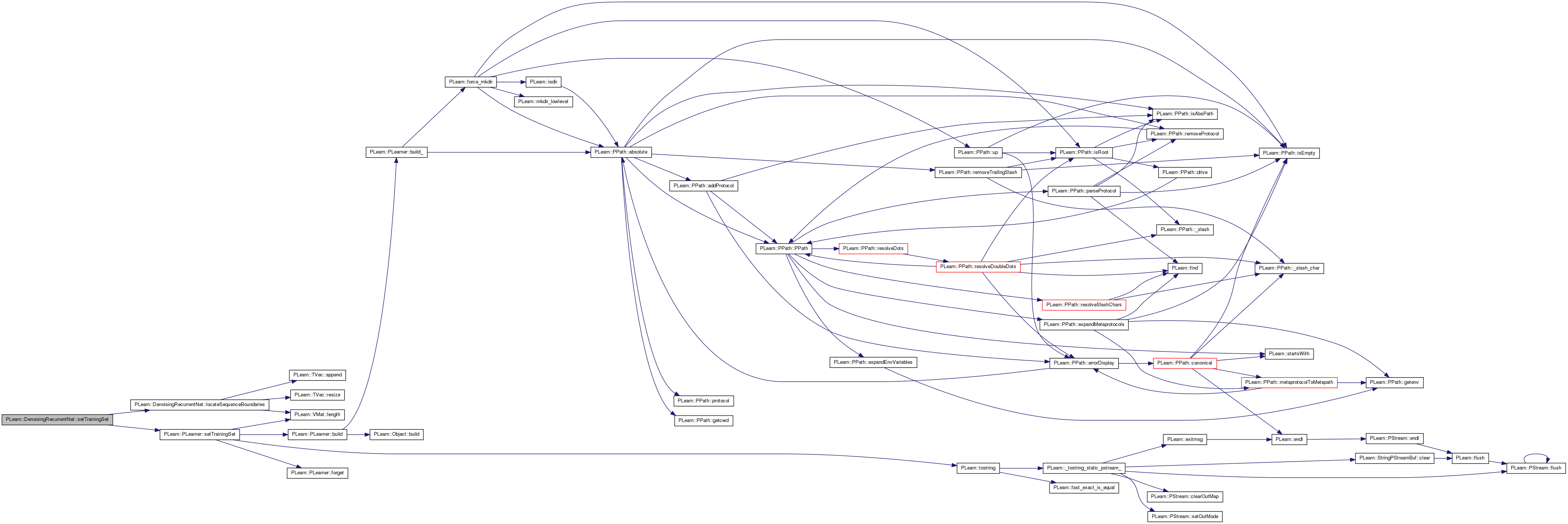
| void PLearn::DenoisingRecurrentNet::splitRawMaskedSupervisedSequence | ( | Mat | seq, |
| bool | doNoise | ||
| ) | const [private] |
For the (backward testing) raw_masked_supervised case. Populates: input_list, targets_list, masks_list.
Definition at line 973 of file DenoisingRecurrentNet.cc.
References encoded_seq, i, inject_zero_forcing_noise(), input_list, input_noise_prob, PLearn::PLearner::inputsize(), PLearn::TMat< T >::length(), PLearn::TVec< T >::length(), masks_list, PLearn::TMat< T >::resize(), PLearn::TVec< T >::resize(), resize_lists(), PLearn::TVec< T >::size(), PLearn::TMat< T >::subMatColumns(), target_layers, targets_list, PLearn::PLearner::targetsize(), and PLearn::TMat< T >::width().
Referenced by encodeSequenceAndPopulateLists().
{
int l = seq.length();
resize_lists(l);
int inputsize_without_masks = inputsize()-targetsize();
Mat input_part;
input_part.resize(seq.length(),inputsize_without_masks);
input_part << seq.subMatColumns(0,inputsize_without_masks);
Mat mask_part = seq.subMatColumns(inputsize_without_masks, targetsize());
Mat target_part = seq.subMatColumns(inputsize_without_masks+targetsize(), targetsize());
if(doNoise)
inject_zero_forcing_noise(input_part, input_noise_prob);
for(int i=0; i<l; i++)
input_list[i] = input_part(i);
int ntargets = target_layers.length();
targets_list.resize(ntargets);
masks_list.resize(ntargets);
int startcol = 0; // starting column of next target in target_part and mask_part
for(int k=0; k<ntargets; k++)
{
int targsize = target_layers[k]->size;
targets_list[k] = target_part.subMatColumns(startcol, targsize);
masks_list[k] = mask_part.subMatColumns(startcol, targsize);
startcol += targsize;
}
encoded_seq.resize(input_part.length(), input_part.width());
encoded_seq << input_part;
}
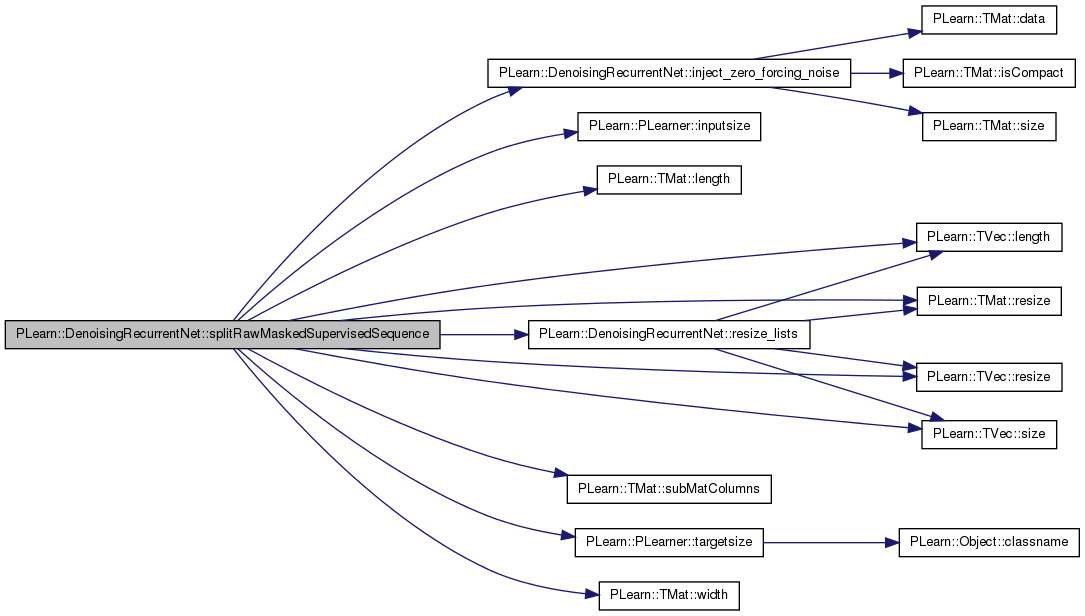

| void PLearn::DenoisingRecurrentNet::test | ( | VMat | testset, |
| PP< VecStatsCollector > | test_stats, | ||
| VMat | testoutputs = 0, |
||
| VMat | testcosts = 0 |
||
| ) | const [virtual] |
Performs test on testset, updating test cost statistics, and optionally filling testoutputs and testcosts.
The default version repeatedly calls computeOutputAndCosts or computeCostsOnly. Note that neither test_stats->forget() nor test_stats->finalize() is called, so that you should call them yourself (respectively before and after calling this method) if you don't plan to accumulate statistics.
Reimplemented from PLearn::PLearner.
Definition at line 2595 of file DenoisingRecurrentNet.cc.
References PLearn::TVec< T >::clear(), encoded_seq, encodeSequenceAndPopulateLists(), end_of_sequence_symbol, PLearn::fast_exact_is_equal(), PLearn::TVec< T >::fill(), i, input_window_size, PLearn::TVec< T >::length(), PLearn::VMat::length(), locateSequenceBoundaries(), MISSING_VALUE, PLearn::PLearner::nTestCosts(), outputsize(), recurrentFprop(), PLearn::PLearner::report_progress, PLearn::TMat< T >::resize(), seq, PLearn::TVec< T >::size(), PLearn::TVec< T >::subVec(), target_layers, target_layers_weights, target_prediction_list, testset_boundaries, unconditionalFprop(), w, and PLearn::VMat::width().
{
int len = testset.length();
Vec output(outputsize());
output.clear();
Vec costs(nTestCosts());
costs.clear();
Vec n_items(nTestCosts());
n_items.clear();
PP<ProgressBar> pb;
if (report_progress)
pb = new ProgressBar("Testing learner", len);
if (len == 0) {
// Empty test set: we give -1 cost arbitrarily.
costs.fill(-1);
test_stats->update(costs);
}
int w = testset->width();
locateSequenceBoundaries(testset, testset_boundaries, end_of_sequence_symbol);
int nseq = testset_boundaries.length();
seq.resize(5000,2); // contains the current sequence
encoded_seq.resize(5000, 4);
int pos = 0; // position in testoutputs
for(int i=0; i<nseq; i++)
{
int start = 0;
if(i>0)
start = testset_boundaries[i-1]+1;
int end = testset_boundaries[i];
int seqlen = end-start; // target_prediction_list[0].length();
seq.resize(seqlen, w);
testset->getMat(start,0,seq);
encodeSequenceAndPopulateLists(seq, false);
if(input_window_size==0)
unconditionalFprop(costs, n_items);
else
recurrentFprop(costs, n_items);
if (testoutputs)
{
for(int t=0; t<seqlen; t++)
{
int sum_target_layers_size = 0;
for( int tar=0; tar < target_layers.length(); tar++ )
{
if( !fast_exact_is_equal(target_layers_weights[tar],0) )
{
output.subVec(sum_target_layers_size,target_layers[tar]->size)
<< target_prediction_list[tar](t);
}
sum_target_layers_size += target_layers[tar]->size;
}
testoutputs->putOrAppendRow(pos++, output);
}
output.fill(end_of_sequence_symbol);
testoutputs->putOrAppendRow(pos++, output);
}
else
pos += seqlen;
if (report_progress)
pb->update(pos);
}
for(int i=0; i<costs.length(); i++)
{
if( !fast_exact_is_equal(target_layers_weights[i],0) )
costs[i] /= n_items[i];
else
costs[i] = MISSING_VALUE;
}
if (testcosts)
testcosts->putOrAppendRow(0, costs);
if (test_stats)
test_stats->update(costs, 1.);
}
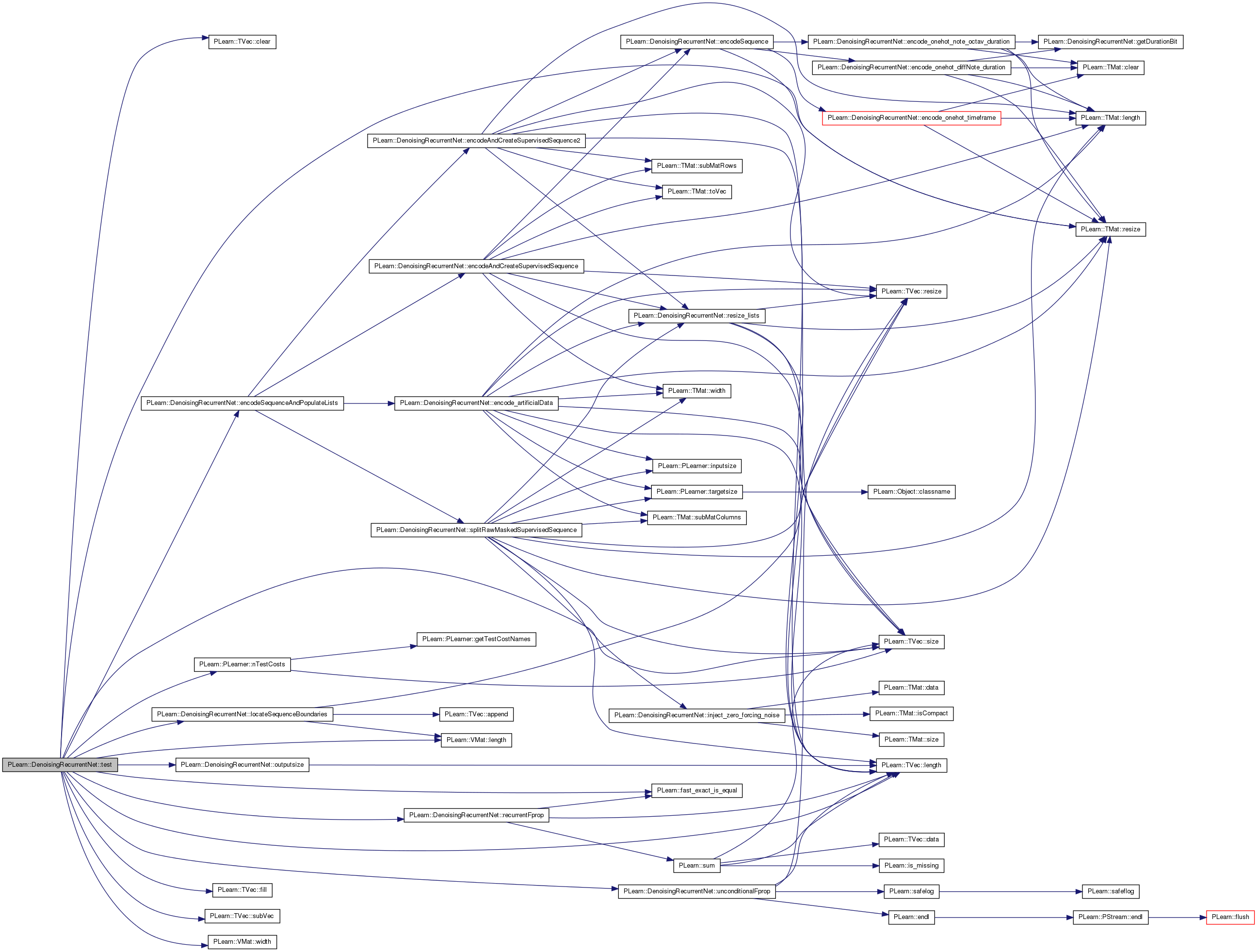
| void PLearn::DenoisingRecurrentNet::train | ( | ) | [virtual] |
The role of the train method is to bring the learner up to stage==nstages, updating the train_stats collector with training costs measured on-line in the process.
Implements PLearn::PLearner.
Definition at line 669 of file DenoisingRecurrentNet.cc.
References classname(), PLearn::TVec< T >::clear(), dynamic_gradient_scale_factor, encodeSequenceAndPopulateLists(), PLearn::endl(), PLearn::fast_exact_is_equal(), getSequence(), getTrainCostNames(), hidden_noise_prob, hidden_reconstruction_cost_weight, hidden_reconstruction_lr, i, PLearn::PLearner::initTrain(), input_noise_prob, input_reconstruction_cost_weight, input_reconstruction_lr, input_window_size, PLearn::TVec< T >::length(), MISSING_VALUE, nb_stage_reconstruction, noise, noisy_recurrent_lr, nSequences(), PLearn::PLearner::nstages, prediction_cost_weight, recurrent_lr, recurrentFprop(), recurrentUpdate(), PLearn::PLearner::report_progress, PLearn::TVec< T >::resize(), PLearn::TMat< T >::resize(), seq, setLearningRate(), PLearn::PLearner::stage, target_layers_weights, PLearn::PLearner::train_stats, trainUnconditionalPredictor(), PLearn::ProgressBar::update(), and PLearn::PLearner::verbosity.
{
if(input_window_size==0)
{
trainUnconditionalPredictor();
return;
}
MODULE_LOG << "train() called " << endl;
// reserve memory for sequences
seq.resize(5000,2); // contains the current sequence
// real weight = 0; // Unused
Vec train_costs( getTrainCostNames().length() );
train_costs.clear();
Vec train_n_items( getTrainCostNames().length() );
if( !initTrain() )
{
MODULE_LOG << "train() aborted" << endl;
return;
}
ProgressBar* pb = 0;
// clear stats of previous epoch
train_stats->forget();
/***** Recurrent phase *****/
if( stage >= nstages )
return;
if( stage < nstages )
{
MODULE_LOG << "Training the whole model" << endl;
int init_stage = stage;
//int end_stage = max(0,nstages-(rbm_nstages + dynamic_nstages));
int end_stage = nstages;
MODULE_LOG << " stage = " << stage << endl;
MODULE_LOG << " end_stage = " << end_stage << endl;
MODULE_LOG << " input_noise_prob = " << input_noise_prob << endl;
MODULE_LOG << " input_reconstruction_lr = " << input_reconstruction_lr << endl;
MODULE_LOG << " hidden_noise_prob = " << hidden_noise_prob << endl;
MODULE_LOG << " hidden_reconstruction_lr = " << hidden_reconstruction_lr << endl;
MODULE_LOG << " noisy_recurrent_lr = " << noisy_recurrent_lr << endl;
MODULE_LOG << " dynamic_gradient_scale_factor = " << dynamic_gradient_scale_factor << endl;
MODULE_LOG << " recurrent_lr = " << recurrent_lr << endl;
if( report_progress && stage < end_stage )
pb = new ProgressBar( "Recurrent training phase of "+classname(),
end_stage - init_stage );
int nCost = 2;
train_costs.resize(train_costs.length() + nCost);
train_n_items.resize(train_n_items.length() + nCost);
while(stage < end_stage)
{
train_costs.clear();
train_n_items.clear();
int nseq = nSequences();
for(int i=0; i<nseq; i++)
{
if(input_noise_prob!=0 )
noise = true;
else
noise = false;
getSequence(i, seq);
encodeSequenceAndPopulateLists(seq, false);
//bool corrupt_input = false;//input_noise_prob!=0 && (noisy_recurrent_lr!=0 || input_reconstruction_lr!=0);
//clean_encoded_seq.resize(encoded_seq.length(), encoded_seq.width());
//clean_encoded_seq << encoded_seq;
//if(corrupt_input) // WARNING: encoded_sequence will be dirty!!!!
// inject_zero_forcing_noise(encoded_seq, input_noise_prob);
// recurrent no noise phase
if(stage >= nb_stage_reconstruction){
if(recurrent_lr!=0)
{
setLearningRate( recurrent_lr );
recurrentFprop(train_costs, train_n_items);
recurrentUpdate(0,0,1, prediction_cost_weight,1, train_costs, train_n_items );
}
}
if(stage < nb_stage_reconstruction || nb_stage_reconstruction == 0 ){
// greedy phase hidden
if(hidden_reconstruction_lr!=0){
setLearningRate( hidden_reconstruction_lr);
recurrentFprop(train_costs, train_n_items, true);
//recurrentUpdate(0, hidden_reconstruction_cost_weight, 1, 0,1, train_costs, train_n_items );
recurrentUpdate(0, hidden_reconstruction_cost_weight, 1, 0,1, train_costs, train_n_items );
}
/*if(recurrent_lr!=0)
{
setLearningRate( recurrent_lr );
recurrentFprop(train_costs, train_n_items);
//recurrentUpdate(0,0,1, prediction_cost_weight,0, train_costs, train_n_items );
recurrentUpdate(0,0,0, prediction_cost_weight,0, train_costs, train_n_items );
}*/
// greedy phase input
if(input_reconstruction_lr!=0){
if (noise)
encodeSequenceAndPopulateLists(seq, true);
setLearningRate( input_reconstruction_lr );
recurrentFprop(train_costs, train_n_items, false);
if (noise)
encodeSequenceAndPopulateLists(seq, false);
//recurrentUpdate(input_reconstruction_cost_weight, 0, 1, 0,1, train_costs, train_n_items );
recurrentUpdate(input_reconstruction_cost_weight, 0, 1, 0,1, train_costs, train_n_items );
}
}
// recurrent no noise phase
/*if(stage>=nb_stage_reconstruction && stage<nb_stage_target+nb_stage_reconstruction){
if(recurrent_lr!=0)
{
if(noise) // need to recover the clean sequence
encoded_seq << clean_encoded_seq;
setLearningRate( recurrent_lr );
recurrentFprop(train_costs, train_n_items);
recurrentUpdate(0,0,1, prediction_cost_weight,0, train_costs, train_n_items );
}
}*/
// recurrent noisy phase
if(noisy_recurrent_lr!=0)
{
setLearningRate( noisy_recurrent_lr );
recurrentFprop(train_costs, train_n_items);
recurrentUpdate(input_reconstruction_cost_weight, hidden_reconstruction_cost_weight, 1,1, prediction_cost_weight, train_costs, train_n_items );
}
}
noise= false;
if( pb )
pb->update( stage + 1 - init_stage);
//double totalCosts = 0;
for(int i=0; i<train_costs.length(); i++)
{
if (train_costs[i] <= 0 || train_n_items[i] <= 0 ){
train_costs[i] = 1;
train_n_items[i] = 1;
}
if (i < target_layers_weights.length()){
if( !fast_exact_is_equal(target_layers_weights[i],0) ){
train_costs[i] /= train_n_items[i];
//totalCosts += train_costs[i]*target_layers_weights[i];
}
else
train_costs[i] = MISSING_VALUE;
}
if (i == train_costs.length()-nCost ){
train_costs[i] /= train_n_items[i];
//totalCosts += train_costs[i]*input_reconstruction_cost_weight;
}
else if (i == train_costs.length()-1)
train_costs[i] /= train_n_items[i];
}
if(verbosity>0)
cout << "mean costs at stage " << stage <<
" = " << train_costs << endl;
stage++;
train_stats->update(train_costs);
}
if( pb )
{
delete pb;
pb = 0;
}
}
train_stats->finalize();
}
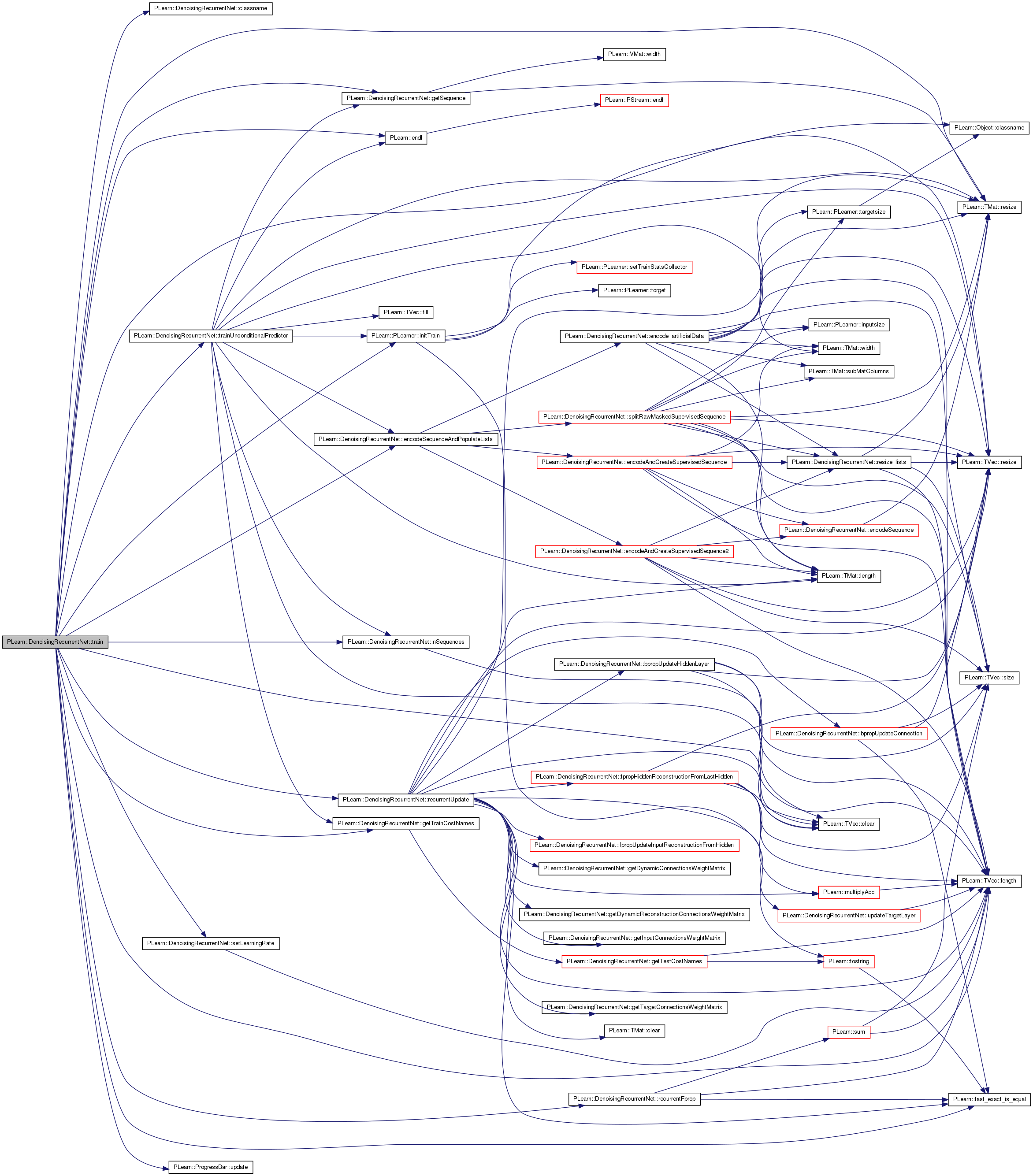
| void PLearn::DenoisingRecurrentNet::trainUnconditionalPredictor | ( | ) | [private] |
Definition at line 610 of file DenoisingRecurrentNet.cc.
References PLearn::TVec< T >::clear(), encoded_seq, encodeSequenceAndPopulateLists(), PLearn::endl(), PLearn::TVec< T >::fill(), getSequence(), getTrainCostNames(), i, PLearn::PLearner::initTrain(), PLearn::TMat< T >::length(), mean_encoded_vec, nSequences(), PLearn::PLearner::nstages, PLearn::PLearner::report_progress, PLearn::TMat< T >::resize(), PLearn::TVec< T >::resize(), seq, PLearn::PLearner::stage, PLearn::PLearner::train_stats, and PLearn::TMat< T >::width().
Referenced by train().
{
MODULE_LOG << "trainUnconditionalPredictor() called " << endl;
// reserve memory for sequences
seq.resize(5000,2); // contains the current sequence
// real weight = 0; // Unused
Vec train_costs( getTrainCostNames().length() );
train_costs.fill(-1);
if( !initTrain() )
{
MODULE_LOG << "train() aborted" << endl;
return;
}
if( stage==0 && nstages==1 )
{
// clear stats of previous epoch
train_stats->forget();
int nvecs = 0;
int nseq = nSequences();
ProgressBar* pb = 0;
if( report_progress)
pb = new ProgressBar( "Sequences ",nseq);
for(int i=0; i<nseq; i++)
{
getSequence(i, seq);
encodeSequenceAndPopulateLists(seq, false);
if(i==0)
{
mean_encoded_vec.resize(encoded_seq.width());
mean_encoded_vec.clear();
}
for(int t=0; t<encoded_seq.length(); t++)
{
mean_encoded_vec += encoded_seq(t);
nvecs++;
}
}
mean_encoded_vec *= 1./nvecs;
train_stats->update(train_costs);
train_stats->finalize();
if( pb )
{
delete pb;
pb = 0;
}
++stage;
}
}
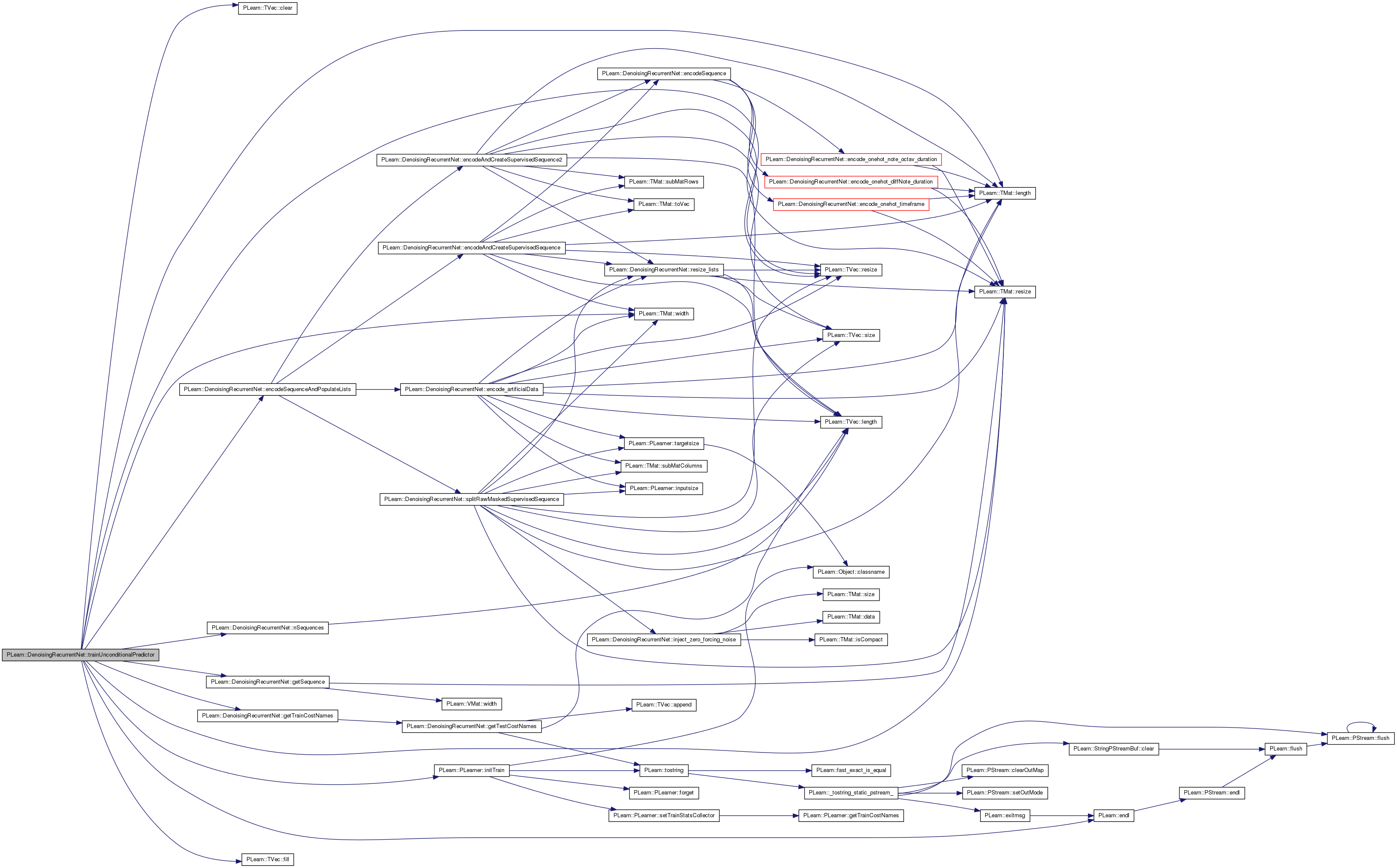

| void PLearn::DenoisingRecurrentNet::unconditionalFprop | ( | Vec | train_costs, |
| Vec | train_n_items | ||
| ) | const [private] |
Definition at line 1082 of file DenoisingRecurrentNet.cc.
References PLearn::endl(), i, input_list, PLearn::TVec< T >::length(), mean_encoded_vec, nll_list, PLearn::perr, PLERROR, PLWARNING, PLearn::TVec< T >::resize(), PLearn::safelog(), target_prediction_list, and targets_list.
Referenced by test().
{
int pred_size = mean_encoded_vec.length();
if(pred_size<=0)
PLERROR("mean_encoded_vec not properly initialized. Did you call trainUnconditionalPredictor prior to unconditionalFprop ?");
int l = input_list.length();
int tar = 0;
train_n_items[tar] += l;
target_prediction_list[tar].resize(l,pred_size);
for(int i=0; i<l; i++)
{
Vec target_prediction_i = target_prediction_list[tar](i);
target_prediction_i << mean_encoded_vec;
Vec target_vec = targets_list[tar](i);
/*
target_layers[tar]->setExpectation(target_prediction_i);
nll_list(i,tar) = target_layers[tar]->fpropNLL(target_vec);
*/
double nllcost = 0;
for(int k=0; k<target_vec.length(); k++)
if(target_vec[k]!=0)
nllcost -= target_vec[k]*safelog(target_prediction_i[k]);
nll_list(i,tar) = nllcost;
if (isinf(nll_list(i,tar)))
{
PLWARNING("Row %d of sequence of length %d lead to inf cost",i,l);
perr << "Problem at positions (vec of length " << target_vec.length() << "): ";
for(int k=0; k<target_vec.length(); k++)
if(target_vec[k]!=0 && target_prediction_i[k]==0)
perr << k << " ";
perr << endl;
// perr << "target_vec = " << target_vec << endl;
// perr << "target_prediction_i = " << target_prediction_i << endl;
}
else
train_costs[tar] += nll_list(i,tar);
}
}


| void PLearn::DenoisingRecurrentNet::updateInputReconstructionFromHidden | ( | Vec | hidden, |
| Mat & | reconstruction_weights, | ||
| Mat & | acc_weights_gr, | ||
| Vec & | input_reconstruction_bias, | ||
| Vec | input_reconstruction_prob, | ||
| Vec | clean_input, | ||
| Vec | hidden_gradient, | ||
| double | input_reconstruction_cost_weight, | ||
| double | lr | ||
| ) | [private] |
Backpropagates reconstruction cost (after comparison with clean_input) with learning rate input_reconstruction_lr accumulates gradient in hidden_gradient, and updates reconstruction_weights and input_reconstruction_bias.
Definition at line 1452 of file DenoisingRecurrentNet.cc.
References PLearn::externalProductScaleAcc(), input_reconstruction_cost_weight, input_reconstruction_prob, PLearn::multiplyAcc(), and PLearn::productAcc().
Referenced by fpropUpdateInputReconstructionFromHidden().
{
// gradient of -log softmax is just output_of_softmax - onehot_target
// so let's accumulate this in hidden_gradient
Vec input_reconstruction_activation_grad = input_reconstruction_prob;
input_reconstruction_activation_grad -= clean_input;
input_reconstruction_activation_grad *= input_reconstruction_cost_weight;
// update bias
multiplyAcc(input_reconstruction_bias, input_reconstruction_activation_grad, -lr);
// update weight
// THIS IS COMMENTED OUT BECAUSE THE reconstruction_weights ARE tied (same) TO THE input_connection weights,
// WHICH GET UPDATED LATER IN recurrentUpdate SO IF WE UPDATE THEM HERE THEY WOULD GET UPDATED TWICE.
// WARNING: THIS WOULD NO LONGER BE THE CASE IF THEY WERE NOT TIED!
externalProductScaleAcc(acc_weights_gr, hidden, input_reconstruction_activation_grad, -lr);
// accumulate in hidden_gradient
productAcc(hidden_gradient, reconstruction_weights, input_reconstruction_activation_grad);
}
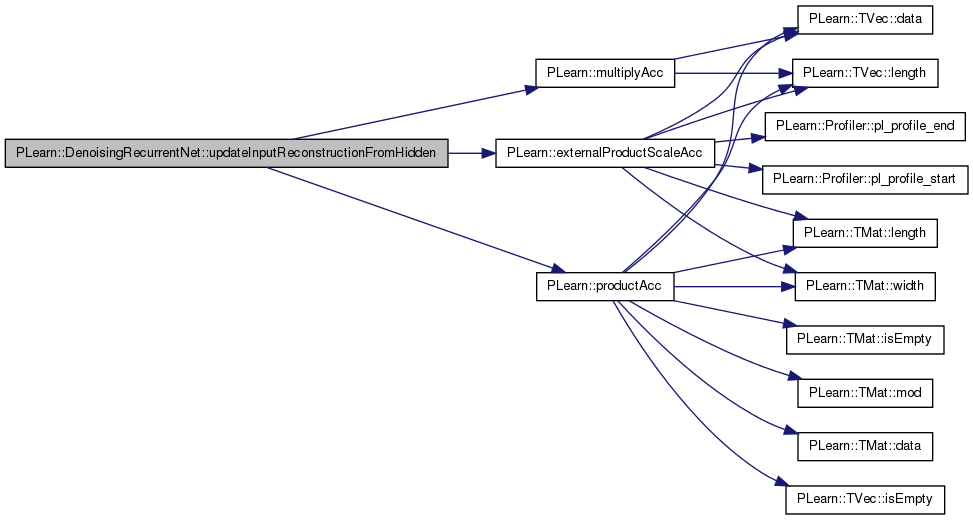

| void PLearn::DenoisingRecurrentNet::updateTargetLayer | ( | Vec & | grad, |
| Vec & | bias, | ||
| real & | lr | ||
| ) | [private] |
Definition at line 1243 of file DenoisingRecurrentNet.cc.
References b, PLearn::TVec< T >::data(), i, and PLearn::TVec< T >::length().
Referenced by recurrentUpdate().
{
real* b = bias.data();
real* gb = grad.data();
int size = bias.length();
for( int i=0 ; i<size ; i++ )
{
b[i] -= lr * gb[i];
}
}


Reimplemented from PLearn::PLearner.
Definition at line 328 of file DenoisingRecurrentNet.h.
Mat PLearn::DenoisingRecurrentNet::acc_dynamic_connections_gr [mutable, protected] |
Definition at line 347 of file DenoisingRecurrentNet.h.
Referenced by makeDeepCopyFromShallowCopy(), and recurrentUpdate().
Vec PLearn::DenoisingRecurrentNet::acc_hidden_bias_gr [mutable, protected] |
Stores accumulate hidden bias gradient.
Definition at line 355 of file DenoisingRecurrentNet.h.
Referenced by makeDeepCopyFromShallowCopy().
Mat PLearn::DenoisingRecurrentNet::acc_input_connections_gr [mutable, protected] |
Definition at line 345 of file DenoisingRecurrentNet.h.
Referenced by makeDeepCopyFromShallowCopy(), and recurrentUpdate().
Vec PLearn::DenoisingRecurrentNet::acc_recons_bias_gr [mutable, protected] |
Stores accumulate reconstruction bias gradient.
Definition at line 358 of file DenoisingRecurrentNet.h.
Referenced by makeDeepCopyFromShallowCopy().
Mat PLearn::DenoisingRecurrentNet::acc_reconstruction_dynamic_connections_gr [mutable, protected] |
Definition at line 349 of file DenoisingRecurrentNet.h.
Referenced by makeDeepCopyFromShallowCopy(), and recurrentUpdate().
Vec PLearn::DenoisingRecurrentNet::acc_target_bias_gr [mutable, protected] |
Stores accumulate target bias gradient.
Definition at line 352 of file DenoisingRecurrentNet.h.
Referenced by makeDeepCopyFromShallowCopy().
TVec< Mat > PLearn::DenoisingRecurrentNet::acc_target_connections_gr [mutable, protected] |
Definition at line 343 of file DenoisingRecurrentNet.h.
Referenced by makeDeepCopyFromShallowCopy(), and recurrentUpdate().
Vec PLearn::DenoisingRecurrentNet::bias_gradient [mutable, protected] |
Stores bias gradient.
Definition at line 361 of file DenoisingRecurrentNet.h.
Referenced by makeDeepCopyFromShallowCopy(), and recurrentUpdate().
Mat PLearn::DenoisingRecurrentNet::clean_encoded_seq [mutable, protected] |
Definition at line 412 of file DenoisingRecurrentNet.h.
Referenced by makeDeepCopyFromShallowCopy().
double PLearn::DenoisingRecurrentNet::current_learning_rate [mutable, protected] |
Definition at line 338 of file DenoisingRecurrentNet.h.
Referenced by recurrentUpdate(), and setLearningRate().
PP<AutoVMatrix> PLearn::DenoisingRecurrentNet::data [protected] |
Store external data;.
Definition at line 341 of file DenoisingRecurrentNet.h.
Referenced by generate(), generateArtificial(), and makeDeepCopyFromShallowCopy().
Vec PLearn::DenoisingRecurrentNet::dynamic_act_no_bias_contribution [mutable, protected] |
Contribution of dynamic weights to hidden layer activation.
Definition at line 405 of file DenoisingRecurrentNet.h.
Referenced by fpropHiddenReconstructionFromLastHidden(), fpropHiddenReconstructionFromLastHidden2(), generate(), generateArtificial(), makeDeepCopyFromShallowCopy(), and recurrentFprop().
The RBMConnection between the first hidden layers, through time.
Definition at line 99 of file DenoisingRecurrentNet.h.
Referenced by build_(), declareOptions(), forget(), fpropHiddenReconstructionFromLastHidden(), generate(), generateArtificial(), getDynamicConnectionsWeightMatrix(), makeDeepCopyFromShallowCopy(), recurrentFprop(), recurrentUpdate(), and setLearningRate().
Definition at line 151 of file DenoisingRecurrentNet.h.
Referenced by declareOptions(), and train().
The RBMConnection for the reconstruction between the hidden layers, through time.
Definition at line 102 of file DenoisingRecurrentNet.h.
Referenced by build_(), declareOptions(), forget(), getDynamicReconstructionConnectionsWeightMatrix(), makeDeepCopyFromShallowCopy(), and setLearningRate().
Mat PLearn::DenoisingRecurrentNet::encoded_seq [mutable, protected] |
Definition at line 411 of file DenoisingRecurrentNet.h.
Referenced by encode_artificialData(), encodeAndCreateSupervisedSequence(), encodeAndCreateSupervisedSequence2(), makeDeepCopyFromShallowCopy(), splitRawMaskedSupervisedSequence(), test(), and trainUnconditionalPredictor().
Chooses what type of encoding to apply to an input sequence Possibilities: "timeframe", "note_duration", "note_octav_duration", "raw_masked_supervised".
Definition at line 127 of file DenoisingRecurrentNet.h.
Referenced by build_(), declareOptions(), encodeSequence(), encodeSequenceAndPopulateLists(), and fpropInputReconstructionFromHidden().
Value of the first input component for end-of-sequence delimiter.
Definition at line 84 of file DenoisingRecurrentNet.h.
Referenced by declareOptions(), generate(), generateArtificial(), setTrainingSet(), and test().
Mat PLearn::DenoisingRecurrentNet::hidden2_act_no_bias_list [mutable, protected] |
Definition at line 382 of file DenoisingRecurrentNet.h.
Referenced by generate(), generateArtificial(), makeDeepCopyFromShallowCopy(), recurrentFprop(), recurrentUpdate(), and resize_lists().
Mat PLearn::DenoisingRecurrentNet::hidden2_list [mutable, protected] |
List of second hidden layers values.
Definition at line 380 of file DenoisingRecurrentNet.h.
Referenced by generate(), generateArtificial(), makeDeepCopyFromShallowCopy(), recurrentFprop(), recurrentUpdate(), and resize_lists().
Mat PLearn::DenoisingRecurrentNet::hidden_act_no_bias_list [mutable, protected] |
Definition at line 376 of file DenoisingRecurrentNet.h.
Referenced by generate(), generateArtificial(), makeDeepCopyFromShallowCopy(), recurrentFprop(), recurrentUpdate(), and resize_lists().
The RBMConnection between the first and second hidden layers (optional)
Definition at line 105 of file DenoisingRecurrentNet.h.
Referenced by build_(), declareOptions(), forget(), generate(), generateArtificial(), makeDeepCopyFromShallowCopy(), recurrentFprop(), recurrentUpdate(), and setLearningRate().
Vec PLearn::DenoisingRecurrentNet::hidden_gradient [mutable, protected] |
Stores hidden gradient of dynamic connections.
Definition at line 367 of file DenoisingRecurrentNet.h.
Referenced by makeDeepCopyFromShallowCopy(), and recurrentUpdate().
The hidden layer of the model.
Definition at line 93 of file DenoisingRecurrentNet.h.
Referenced by build_(), declareOptions(), forget(), fpropHiddenReconstructionFromLastHidden(), fpropHiddenSymmetricDynamicMatrix(), generate(), generateArtificial(), makeDeepCopyFromShallowCopy(), recurrentFprop(), recurrentUpdate(), resize_lists(), and setLearningRate().
The second hidden layer of the model (optional)
Definition at line 96 of file DenoisingRecurrentNet.h.
Referenced by build_(), declareOptions(), forget(), generate(), generateArtificial(), makeDeepCopyFromShallowCopy(), recurrentFprop(), recurrentUpdate(), resize_lists(), and setLearningRate().
Mat PLearn::DenoisingRecurrentNet::hidden_list [mutable, protected] |
List of hidden layers values.
Definition at line 374 of file DenoisingRecurrentNet.h.
Referenced by generate(), generateArtificial(), makeDeepCopyFromShallowCopy(), recurrentFprop(), recurrentUpdate(), and resize_lists().
Definition at line 144 of file DenoisingRecurrentNet.h.
Referenced by declareOptions(), and train().
Definition at line 163 of file DenoisingRecurrentNet.h.
Referenced by makeDeepCopyFromShallowCopy(), and recurrentUpdate().
Definition at line 165 of file DenoisingRecurrentNet.h.
Referenced by makeDeepCopyFromShallowCopy(), and recurrentUpdate().
Definition at line 169 of file DenoisingRecurrentNet.h.
Referenced by declareOptions(), fpropHiddenReconstructionFromLastHidden(), fpropHiddenReconstructionFromLastHidden2(), fpropHiddenSymmetricDynamicMatrix(), and train().
Definition at line 145 of file DenoisingRecurrentNet.h.
Referenced by declareOptions(), and train().
Vec PLearn::DenoisingRecurrentNet::hidden_reconstruction_prob [mutable, protected] |
Definition at line 416 of file DenoisingRecurrentNet.h.
Referenced by makeDeepCopyFromShallowCopy(), and recurrentUpdate().
Vec PLearn::DenoisingRecurrentNet::hidden_temporal_gradient [mutable, protected] |
Stores hidden gradient of dynamic connections coming from time t+1.
Definition at line 370 of file DenoisingRecurrentNet.h.
Referenced by makeDeepCopyFromShallowCopy(), and recurrentUpdate().
The RBMConnection from input_layer to hidden_layer.
Definition at line 108 of file DenoisingRecurrentNet.h.
Referenced by build_(), declareOptions(), forget(), fpropHiddenReconstructionFromLastHidden(), generate(), generateArtificial(), getInputConnectionsWeightMatrix(), makeDeepCopyFromShallowCopy(), recurrentFprop(), recurrentUpdate(), and setLearningRate().
The input layer of the model.
Definition at line 87 of file DenoisingRecurrentNet.h.
Referenced by build_(), declareOptions(), forget(), generate(), generateArtificial(), makeDeepCopyFromShallowCopy(), and setLearningRate().
TVec< Vec > PLearn::DenoisingRecurrentNet::input_list [mutable, protected] |
List of inputs values.
Definition at line 391 of file DenoisingRecurrentNet.h.
Referenced by encode_artificialData(), encodeAndCreateSupervisedSequence(), encodeAndCreateSupervisedSequence2(), generate(), generateArtificial(), makeDeepCopyFromShallowCopy(), recurrentFprop(), recurrentUpdate(), resize_lists(), splitRawMaskedSupervisedSequence(), and unconditionalFprop().
Definition at line 142 of file DenoisingRecurrentNet.h.
Referenced by declareOptions(), fpropHiddenReconstructionFromLastHidden(), splitRawMaskedSupervisedSequence(), and train().
Definition at line 160 of file DenoisingRecurrentNet.h.
Referenced by forget(), makeDeepCopyFromShallowCopy(), and recurrentUpdate().
Definition at line 168 of file DenoisingRecurrentNet.h.
Referenced by declareOptions(), train(), and updateInputReconstructionFromHidden().
Definition at line 143 of file DenoisingRecurrentNet.h.
Referenced by declareOptions(), and train().
Vec PLearn::DenoisingRecurrentNet::input_reconstruction_prob [mutable, protected] |
Definition at line 415 of file DenoisingRecurrentNet.h.
Referenced by makeDeepCopyFromShallowCopy(), recurrentUpdate(), and updateInputReconstructionFromHidden().
Number of symbols for each symbolic field of train_set.
Definition at line 120 of file DenoisingRecurrentNet.h.
Referenced by build_(), declareOptions(), generate(), generateArtificial(), and makeDeepCopyFromShallowCopy().
Input window size.
Definition at line 138 of file DenoisingRecurrentNet.h.
Referenced by applyMultipleSoftmaxToInputWindow(), declareOptions(), encodeAndCreateSupervisedSequence(), encodeAndCreateSupervisedSequence2(), encodeSequence(), test(), and train().
Optional (default=0) factor of L1 regularization term.
Definition at line 132 of file DenoisingRecurrentNet.h.
Referenced by applyWeightPenalty(), bpropUpdateConnection(), and declareOptions().
Optional (default=0) factor of L2 regularization term.
Definition at line 135 of file DenoisingRecurrentNet.h.
Referenced by applyWeightPenalty(), bpropUpdateConnection(), and declareOptions().
TVec< Mat > PLearn::DenoisingRecurrentNet::masks_list [mutable, protected] |
List of all targets' masks.
Definition at line 402 of file DenoisingRecurrentNet.h.
Referenced by generate(), generateArtificial(), makeDeepCopyFromShallowCopy(), recurrentFprop(), recurrentUpdate(), and splitRawMaskedSupervisedSequence().
Definition at line 157 of file DenoisingRecurrentNet.h.
Referenced by declareOptions(), makeDeepCopyFromShallowCopy(), trainUnconditionalPredictor(), and unconditionalFprop().
Definition at line 171 of file DenoisingRecurrentNet.h.
Referenced by declareOptions(), and train().
Definition at line 172 of file DenoisingRecurrentNet.h.
Referenced by declareOptions().
Mat PLearn::DenoisingRecurrentNet::nll_list [mutable, protected] |
List of the nll of the input samples in a sequence.
Definition at line 398 of file DenoisingRecurrentNet.h.
Referenced by generate(), generateArtificial(), makeDeepCopyFromShallowCopy(), recurrentFprop(), recurrentUpdate(), resize_lists(), and unconditionalFprop().
Definition at line 129 of file DenoisingRecurrentNet.h.
Referenced by train().
Definition at line 150 of file DenoisingRecurrentNet.h.
Referenced by declareOptions(), and train().
Definition at line 167 of file DenoisingRecurrentNet.h.
Referenced by declareOptions(), and train().
Definition at line 154 of file DenoisingRecurrentNet.h.
Referenced by declareOptions(), and train().
Mat PLearn::DenoisingRecurrentNet::seq [mutable, protected] |
Definition at line 410 of file DenoisingRecurrentNet.h.
Referenced by makeDeepCopyFromShallowCopy(), test(), train(), and trainUnconditionalPredictor().
The RBMConnection from input_layer to hidden_layer.
Definition at line 111 of file DenoisingRecurrentNet.h.
Referenced by build_(), declareOptions(), forget(), generate(), generateArtificial(), getTargetConnectionsWeightMatrix(), makeDeepCopyFromShallowCopy(), recurrentFprop(), recurrentUpdate(), and setLearningRate().
The target layers of the model.
Definition at line 90 of file DenoisingRecurrentNet.h.
Referenced by applyMultipleSoftmaxToInputWindow(), build_(), declareOptions(), encode_artificialData(), encodeAndCreateSupervisedSequence(), encodeAndCreateSupervisedSequence2(), forget(), generate(), generateArtificial(), getTestCostNames(), makeDeepCopyFromShallowCopy(), outputsize(), recurrentFprop(), recurrentUpdate(), resize_lists(), setLearningRate(), splitRawMaskedSupervisedSequence(), and test().
Number of elements in the target part of a VMatrix associated to each target layer.
Definition at line 117 of file DenoisingRecurrentNet.h.
Referenced by build_(), declareOptions(), generate(), generateArtificial(), and makeDeepCopyFromShallowCopy().
The training weights of each target layers.
Definition at line 76 of file DenoisingRecurrentNet.h.
Referenced by build_(), declareOptions(), generate(), generateArtificial(), makeDeepCopyFromShallowCopy(), recurrentFprop(), recurrentUpdate(), test(), and train().
TVec<Mat> PLearn::DenoisingRecurrentNet::target_prediction_act_no_bias_list [mutable, protected] |
Definition at line 388 of file DenoisingRecurrentNet.h.
Referenced by generate(), generateArtificial(), makeDeepCopyFromShallowCopy(), recurrentFprop(), recurrentUpdate(), and resize_lists().
TVec<Mat> PLearn::DenoisingRecurrentNet::target_prediction_list [mutable, protected] |
List of target prediction values.
Definition at line 386 of file DenoisingRecurrentNet.h.
Referenced by applyMultipleSoftmaxToInputWindow(), generate(), generateArtificial(), makeDeepCopyFromShallowCopy(), recurrentFprop(), recurrentUpdate(), resize_lists(), test(), and unconditionalFprop().
Number of symbols for each symbolic field of train_set.
Definition at line 123 of file DenoisingRecurrentNet.h.
Referenced by build_(), declareOptions(), generate(), generateArtificial(), and makeDeepCopyFromShallowCopy().
TVec<Mat> PLearn::DenoisingRecurrentNet::targets_list [mutable, protected] |
List of inputs values.
Definition at line 395 of file DenoisingRecurrentNet.h.
Referenced by encode_artificialData(), encodeAndCreateSupervisedSequence(), encodeAndCreateSupervisedSequence2(), generate(), generateArtificial(), makeDeepCopyFromShallowCopy(), recurrentFprop(), recurrentUpdate(), splitRawMaskedSupervisedSequence(), and unconditionalFprop().
TVec<int> PLearn::DenoisingRecurrentNet::testset_boundaries [mutable, protected] |
Definition at line 408 of file DenoisingRecurrentNet.h.
Referenced by makeDeepCopyFromShallowCopy(), and test().
Definition at line 146 of file DenoisingRecurrentNet.h.
Referenced by declareOptions().
Definition at line 141 of file DenoisingRecurrentNet.h.
Referenced by declareOptions().
TVec<int> PLearn::DenoisingRecurrentNet::trainset_boundaries [protected] |
Definition at line 407 of file DenoisingRecurrentNet.h.
Referenced by getSequence(), makeDeepCopyFromShallowCopy(), nSequences(), and setTrainingSet().
Indication that a mask indicating which target to predict is present in the input part of the VMatrix dataset.
no loinger an option: this is set to true only for (encoding=="raw_masked_supervised")
Definition at line 81 of file DenoisingRecurrentNet.h.
Referenced by build_(), encodeAndCreateSupervisedSequence(), encodeAndCreateSupervisedSequence2(), generate(), generateArtificial(), recurrentFprop(), and recurrentUpdate().
Vec PLearn::DenoisingRecurrentNet::visi_bias_gradient [mutable, protected] |
Stores bias gradient.
Definition at line 364 of file DenoisingRecurrentNet.h.
Referenced by makeDeepCopyFromShallowCopy(), and recurrentUpdate().
 1.7.4
1.7.4